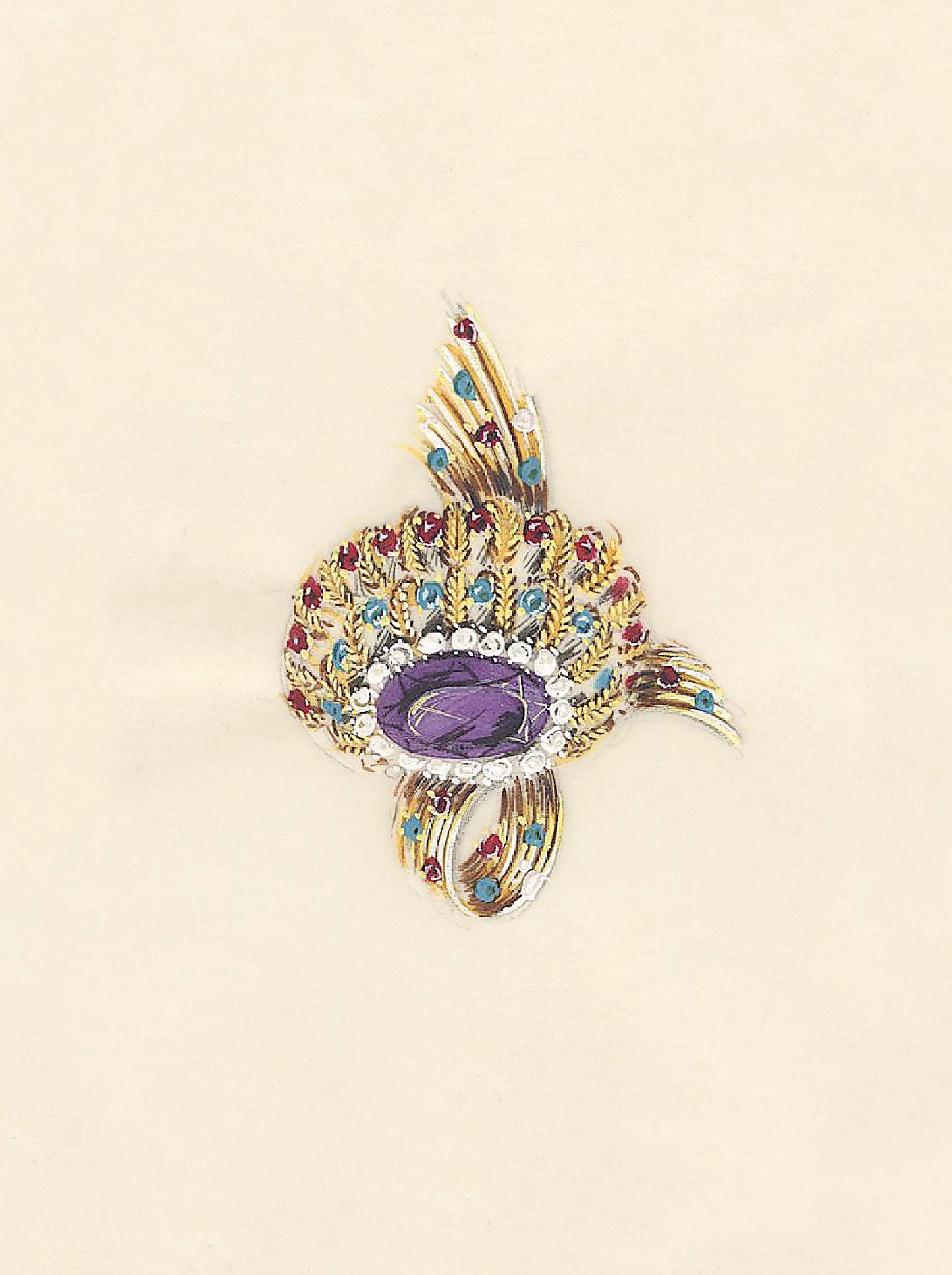LES ENLUMINURES
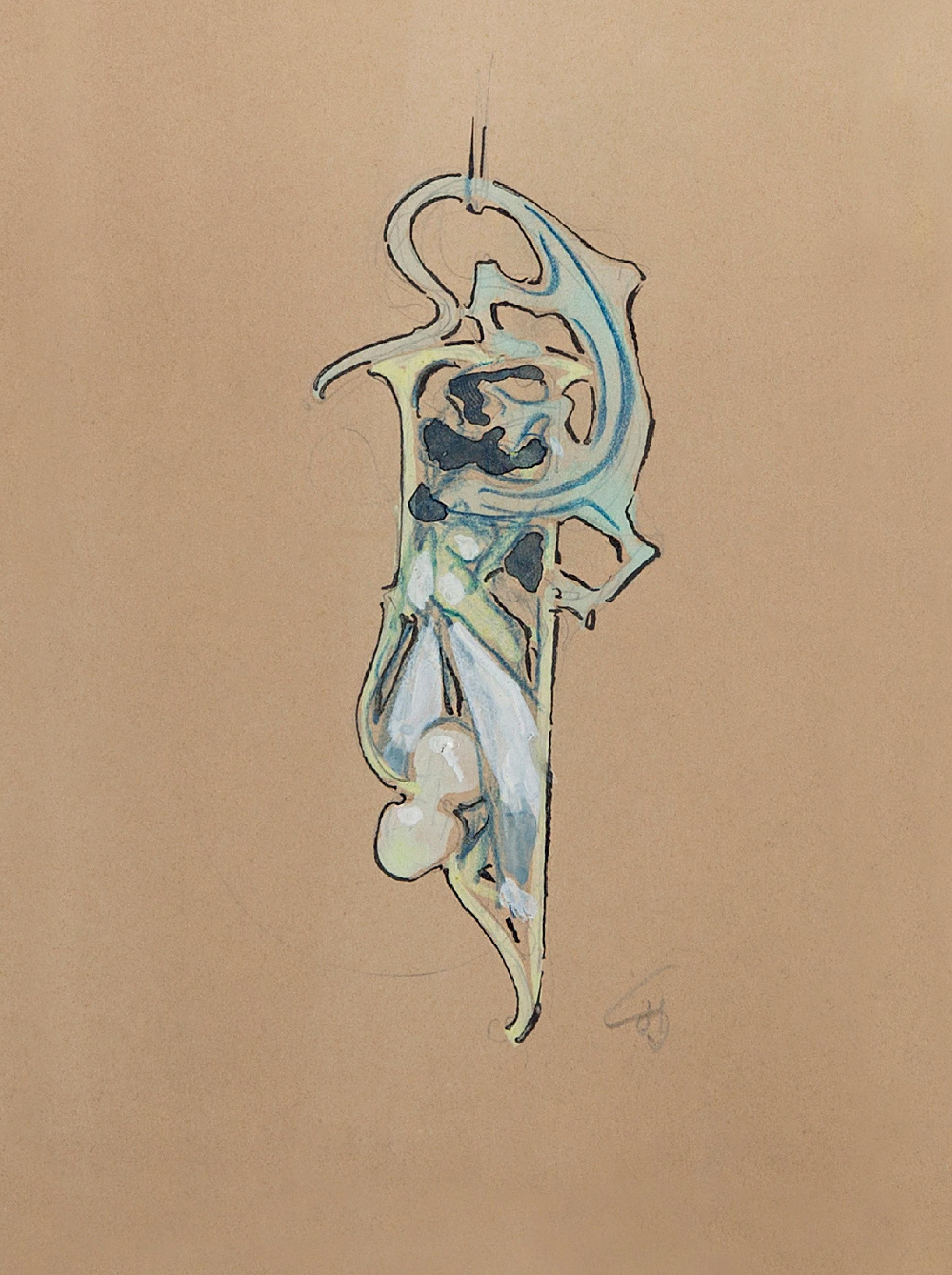


Beatriz
A staggering number of more than 2,750 drawings make up this exceptionally rich archive of jewelry designs that spans two centuries from the late eighteenth century to the 1970s. The eleven separate collections — consisting both of bound albums and of boxed sets of individual sheets — represent diverse jewelers from Germany, Belgium, England, France, and the United States. Drawings encompass nearly every imaginable type of adornment, mostly for women, but occasionally for men, including rings, brooches, pendants, earrings, bracelets, necklaces, chains, combs and other hair ornaments, fob seals, watch keys and watch mounts, dress ornaments such as buttons and bows, tassels and festoons, frontneedles, and the occasional tiara.
Giving insight into the highly imaginative process of the jeweler and designer, the exchange between salesperson and customer, regional styles, and changing fashions and tastes, these drawings are also works of art in their own right. They complement other extensive and renowned museum collections, showcasing the rich world behind the scenes of one of society’s most cherished art forms.
Paris l New York l Chicago
Les enLuminures
21-22 Galerie de Montpensier
Jardin du Palais-Royal
75001 Paris
tel: +33 (0)1 42 60 15 58 info@lesenluminures.com
Les enLuminures Ltd
23 East 73rd Street 7th Floor, Penthouse
New York, NY 1002-1
tel: +1 212 717 7273 newyork@lesenluminures.com
Les enLuminures Ltd.
980 North Michigan Avenue, Suite 1330 Chicago, IL 60611
tel: +1 773 929 5986 chicago@lesenluminures.com
www.lesenluminures.com
Produced and published for Sandra Hindman, Les enLuminures
Design: Karen Gennaro
Printed in Italy: Printed by e-Graphic, a division of 4Flying Srl, Verona, Italy
ISBN: 979-8-9988532-0-3
Beatriz
Introduction Sandra Hindman

Introduction
1. A Jeweler’s Design Book Netherlands, late 18th - early 19th century
2. Book with Designs for Gemstone and Paste Jewelry by G. & J. Kemp England (London), c. 1822
3. Jeweler’s Sketchbook by Alfred Schaller, Munich Germany, possibly compiled in 1923 of jewels dating, c. 1880 - early 1920s
4. Sketchbook of Designs for Dress Accessories Probably France, c. 1880s - 1900
5. Three Drawings for Art Nouveau Jewels by Jules Chadel (1870-1942) for Georges Fouquet (1862-1957) Paris (France), c. 1900-1905
6. Album with Jewelry Designs in the Garland Style Probably France, c. 1890-1920
7. Jeweler’s Pattern Books for Rings Probably German, 1920s - early 1930s
8. Collection of Drawings from a Jeweler Probably France, late 1920s-1930s
9. Album of Designs and Sketches by Jules Fonteyne (1878-1964) Belgium (Bruges), c. 1920 -early 1930s
10. Designs from a Jeweler’s Workshop Probably France, late 1940s - 1950s
11. Collection of Drawings by a Jewelry Designer Probably France, 1950s-1970s
A staggering number of more than 2,750 drawings make up this exceptionally rich archive of jewelry designs that spans two centuries from the late eighteenth century to the 1970s. The eleven separate collections — consisting both of bound albums and of boxed sets of individual sheets — represent diverse jewelers from Germany, Belgium, England, France, and the United States. Drawings encompass nearly every imaginable type of adornment, mostly for women, but occasionally for men, including rings, brooches, pendants, earrings, bracelets, necklaces, chains, combs and other hair ornaments, fob seals, watch keys and watch mounts, dress ornaments such as buttons and bows, tassels and festoons, frontneedles, and the occasional tiara. As is traditional for jewelry designs intended for use in production, the majority (but not all) are on tracing paper; many are mounted on card. Most are executed in pen and ink or graphite with wash and pigment coloration, although a few are in black-and-white.
Named firms (no longer in business) include G. & J. Kemp of Fetter Lane in London (1822) and Alfred Schaller in Munich (c. 1880 to c. 1923). Among the identifiable artists are the Frenchman, Jules Chadel (1870-1942), whose Art Nouveau designs were destined for Paris jewelers Henri Vever, Georges le Turcq, Georges Fouquet, and the Belgian, Jules Fonteyne (1878-1964), who taught art and design in Bruges but by whom we have identified no surviving jewelry. The concluding album of designs is by an unknown craftsman who may have worked for the established houses of Asprey, London, and Van Cleef & Arpels, whose names appear next to several of his drawings. Other sets of drawings have not yet yielded the names of their designers or the firms they worked for; further research will hopefully reveal the identities of the designers and their firms, thus deepening our understanding of lesser-known houses.
The collection offers an excellent overview of the history of styles of jewelry from the eighteenth to the twentieth centuries. It begins in the 1770s with Neoclassicism, which signalled a move away from the exuberance of the earlier Rococo taste. It concludes with the glamour of the 1960s and
1970s, characterized by flamboyant use of gemstones, novel cuts, and color combinations in response to the rise of high-end Jewelry by the legendary great houses that still dominate the market today. In between these trends, the drawings present abundant examples of Romanticism, the “Louis XVI“ style, Art Nouveau, the “garland style“ (named by Cartier), Art Deco, the “New Look“ (created by Christian Dior), and modernist trends.
One of the most fascinating aspects of the collection is what it tells us about the process of making and selling jewelry. Although not always clearly discernible, the functions of the different sets of drawings reveal the varied purposes they served: preparatory designs, presentation drawings, and archival records. Some examples follow, but they are by no means comprehensive, and further study is warranted. For example, the detailed drawings by Jules Chadel probably served as initial ideas for the goldsmith fabricating the jewel (no. 5). The album of drawings by James Kemp for G.& E. Kemp, executed exclusively in graphite without color, displays only the settings, the spaces for the stones left blank; presumably the client (or the jeweler) could substitute stones of different colors and cuts as desired (no. 2). An unusual example is the album signed and dated in 1923 by Alfred Schaller with drawings dating over more than four decades (no. 3). The precisions, identifying the gems, giving the exact weight, and sometimes specifying the style, suggests it may have functioned as an archival record of the firm’s creations. Other examples blur the lines between presentation drawings and archival records (e.g., nos. 7, 11).
Giving insight into the highly imaginative process of the jeweler and designer, the exchange between salesperson and customer, regional styles, and changing fashions and tastes, these drawings are also works of art in their own right. They complement other extensive and renowned museum collections, such as those in the Victoria and Albert Museum in London, the Petit Palais in Paris, and Dartmouth College and The Rhode Island School of Design in the United States, to name but a few, showcasing the rich world behind the scenes of one of society’s most cherished art forms.
Sandra Hindman
Netherlands, late 18th-early19th century
By the 1760s, high-end jewelers were moving away from the exuberance and asymmetry of the Rococo style in their designs towards the symmetry and geometric forms of Neoclassicism. This style had been popularized by archaeological discoveries earlier in the eighteenth century of classical sites in Italy, such as Herculaneum and Pompeii. Renowned for their high-quality craftsmanship and virtuoso skills, Parisian goldsmiths led fashion trends combining symmetry with decorative swags, tassels, and festoons. Many fled Paris during the French Revolution of 1789 to seek employment abroad and their influence was widespread. It was not until 1804 when Napoleon Bonaparte (1769-1821) became Emperor of France that the French luxury trade was revived and Paris regained its preeminent status in fashion and jewelry design.
This jeweler’s book includes about 250 designs, each detailing the use of silver or gold, the cuts of the gemstones or pastes, the luster of individual pearls, and the use of enamel or blue glass. The highly fashionable jewels include rings with large bezels in the Neoclassical style, cluster rings, mourning and memento rings, as well as a wide array of jewels bearing inscriptions and symbolic motifs celebrating love. Also illustrated are pearl bracelets, often worn in pairs at the time the album was made, and a wide array of earrings, ranging from the late eighteenth-century pendeloque style to the early nineteenth-century possiarde design. Arrow hairpins, floral spray brooches, and necklaces with elaborate festoons also feature. One could assume the book was from a French jeweler due to the dominance of French styles; however one distinctive jewel — the frontneedle worn high on the forehead by women from the provinces of Friesland, Holland, and Zeeland — suggests instead that the book to be of Netherlandish origin.
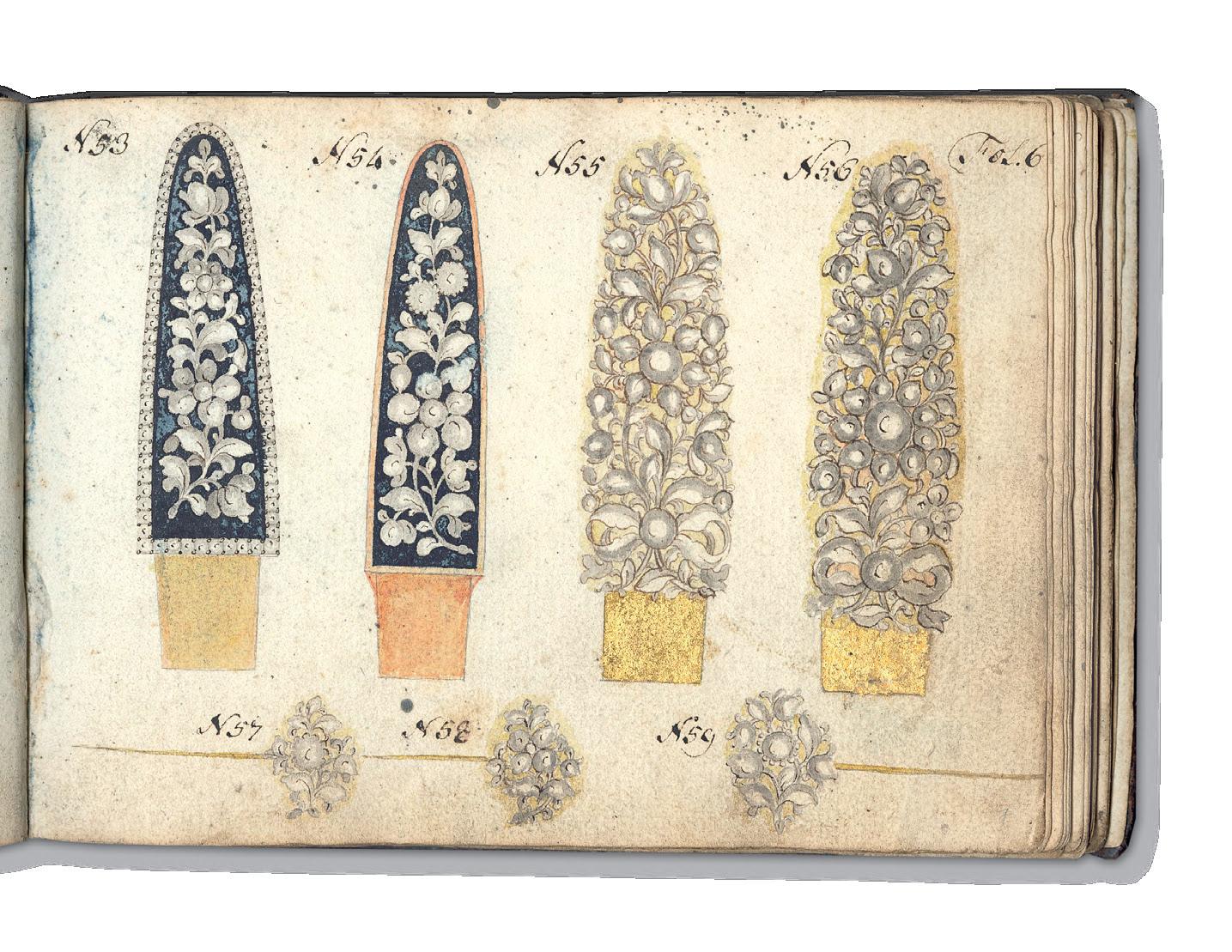

Designs for frontneedles with hair pins Designs for frontneedles with ear ornaments
267 designs in the album (260 are numbered) + 7 additional on loose sheets. Pen, ink, and watercolor on paper, several designs with gold highlights. The size of the drawings varies depending on the jewels: rings, lockets, earrings, necklaces, hair pins, bracelets, brooches, combs, fob seals, watch keys, and frontneedles. Page dimensions 130 x 176 mm.
Album: 88 pages, folios with designs are numbered from fol. 1 to fol. 37 (one folio missing number + 4 empty folios at the end). On paper, watermarks of Adriaan Rogge (on p. 1, fol. 9, fol. 34, p. 80). Color bleed stain and dirt on several pages. Repair on fol. 31 (v). Binding in simple gilt calf, spine rebacked, loss of some small parts on binding, otherwise in good condition. Flyleaf watermark type Garden of Holland. Dimensions 138 x 185 mm.
Designs are only on rectos of the folios; the pages are soiled, particularly on the bottom right, suggesting workshop use. Each drawing has final touches, such as coloring (in blue, grey, or white tones) and some have gold highlights. The drawings appear to have been made to present to clients. Some of the pieces include love inscriptions in French: “NOS COEURS SONT UNIS” (drawing numbered as N. 127) “A MON COEUR SOUVENIR PRECIEUX” (N. 100), “LIEN SOLIDE ET INSEPARABLE” (N. 124) and “LOVE“ (N. 24). There is a strong stylistic coherence throughout the entire ensemble, certainly executed by the same hand.
Provenance: Dorien van Benthem (1859-1941) to whom it came by family descent from the estate of Amsterdam jeweler Adriaan de Voys.
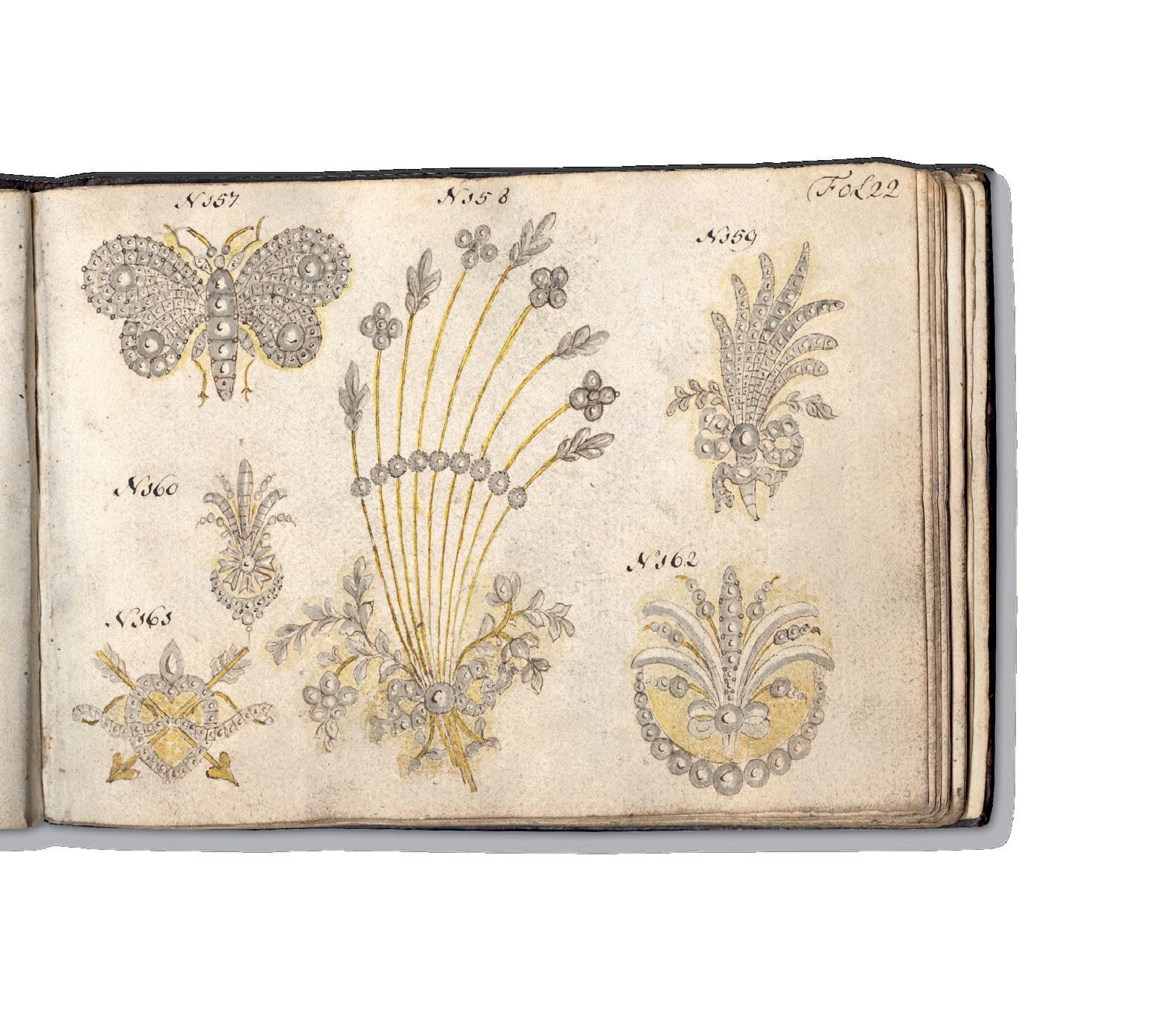
Designs for brooches inspired by nature
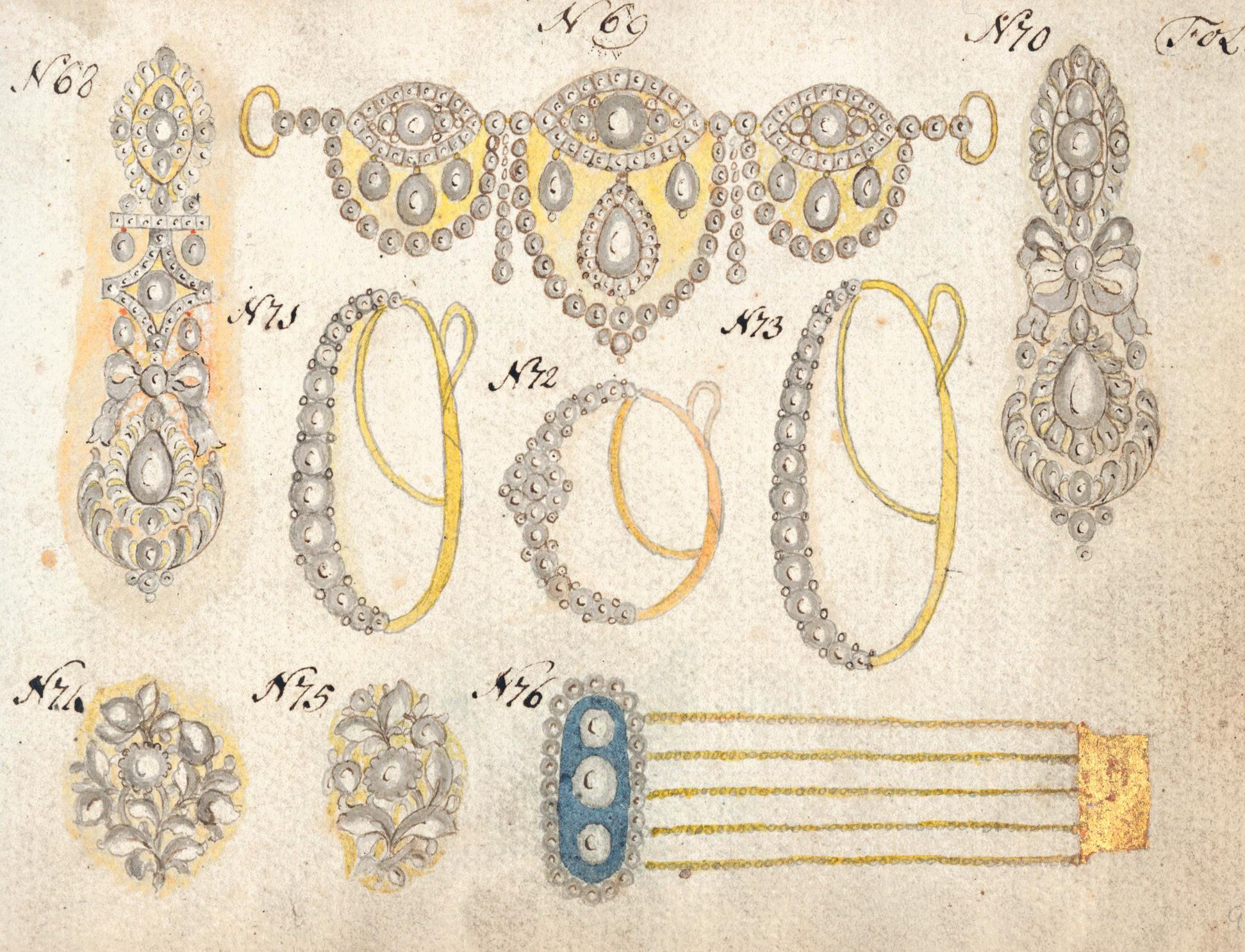
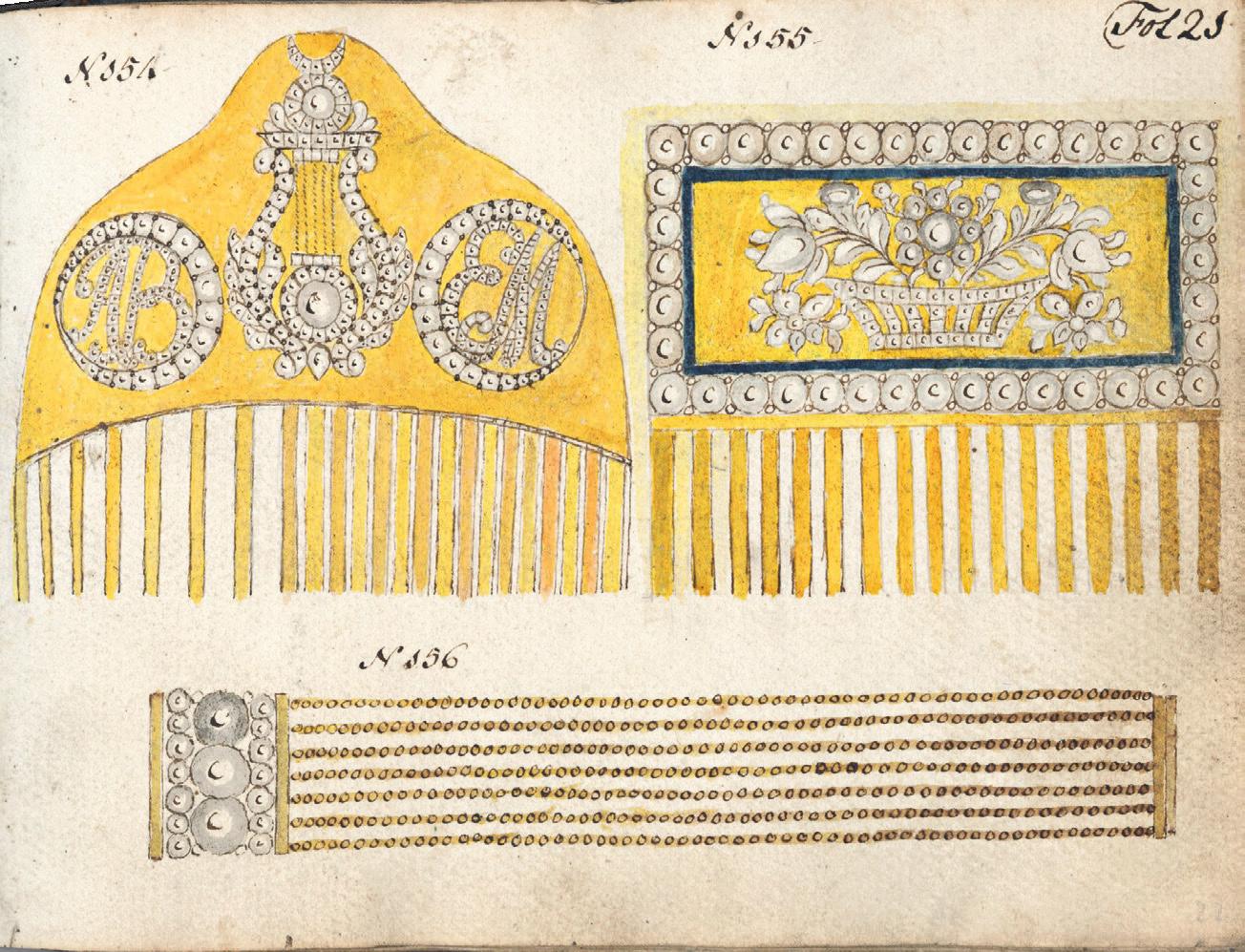
Designs for necklace, floral spray ornaments, bracelet, pendeloque and poissarde earrings
Designs for hair combs and bracelet
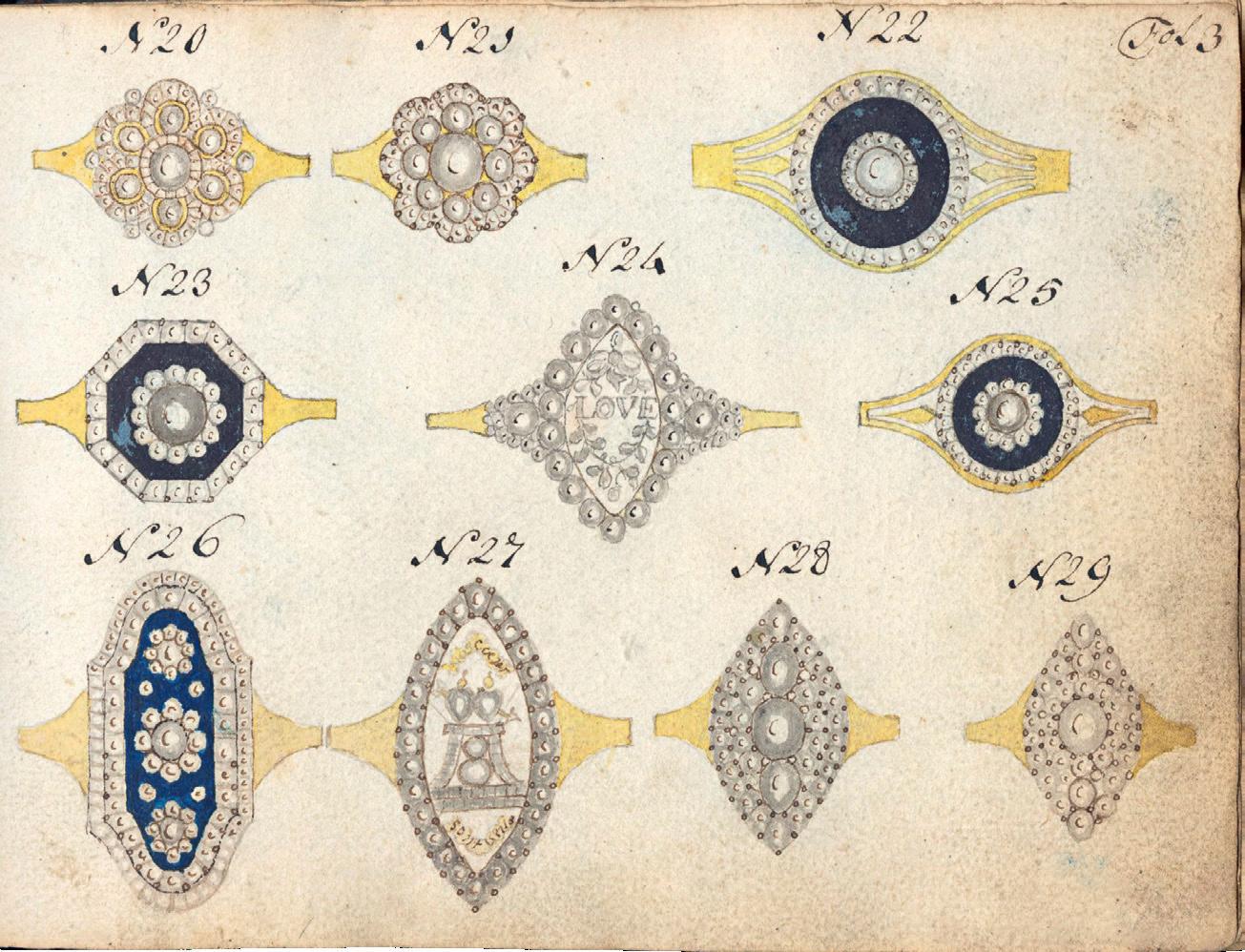
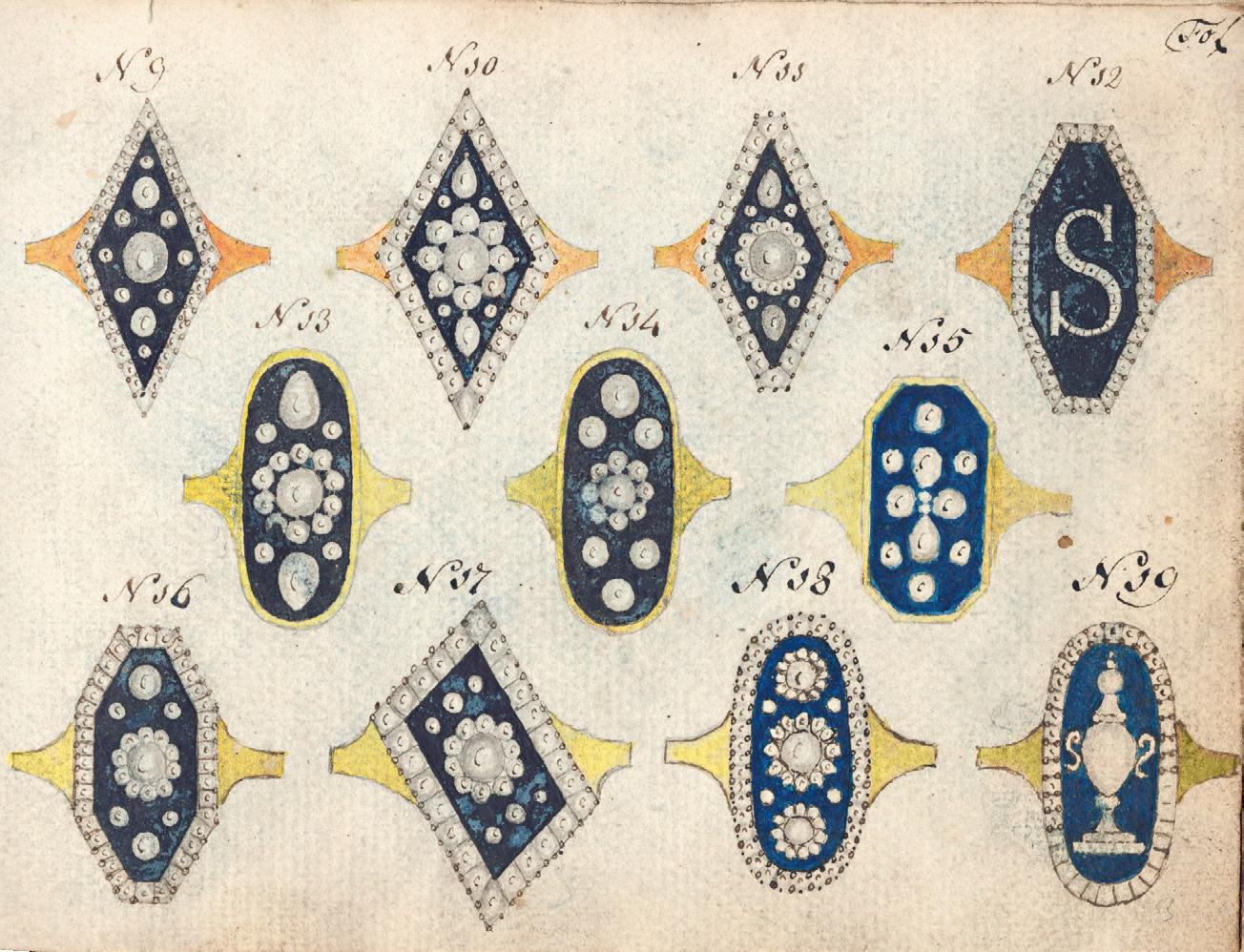
Designs for cluster rings, ring with love inscription and mourning rings in the Neoclassical style Designs for mourning rings in the Neoclassical style
By G. & J. Kemp
England (London), c. 1822
English high fashion in the 1820s and 1830s was heavily influenced by the monarch George IV (ruled 1820-30), who as Prince Regent had become a formidable arbiter of elegant but sumptuous taste. Lightweight silks, satins and velvets, and colorful accessories were de rigueur . Ornaments like bows, ribbons, garlands, and floral motifs continued to be popular in female dress and jewelry design. They reflected contemporary tastes both for the stylized Neoclassical style, popular in jewelry from the late eighteenth century, and for the later, more naturalistic Romantic style which emerged in the 1820s. Diamonds were increasingly replaced by colored gemstones such as amethysts, aquamarines, chrysoprase, citrines, garnets, peridots, topazes, and turquoise to create more affordable suites of jewelry for the emerging wealthy middleclasses. The jewelry designs emphasized gemstones set in fine gold settings.
This album of 46 pages by James Kemp features 304 outline drawings for bracelets, brooches, a wide variety of pendant crosses, chandelier earrings, and floral necklaces, and tiaras. They illustrate how the jeweler of the time presented various design possibilities to the client. Fashionable ladies could choose interchangeable items to form a parure for evening wear or demiparure for the daytime, selecting colored gemstones to match their dress. According to the members’ index of the Worshipful Company of Goldsmiths, James Kemp, the son of Thomas Kemp, was apprenticed to jeweler and possibly family relation George Kemp in 1813 and was made free on January 3, 1821. Their registered address was Fetter Lane in London, as noted in this album along with the imprint of their probable partnership “ G. & J. Kemp “
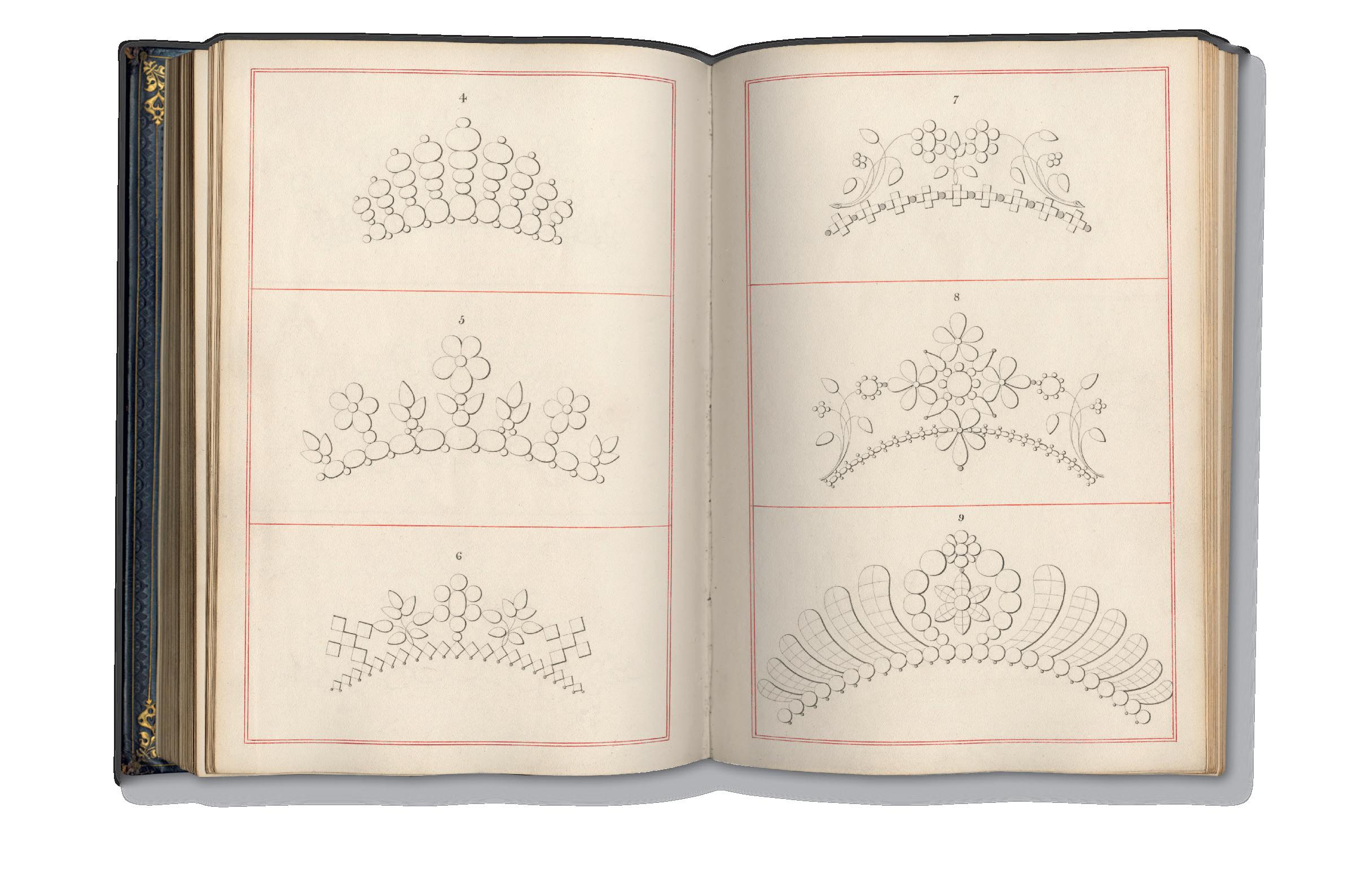
Designs for tiaras
304 designs , grey ink on wove paper, each leaf c. 262 x 180 mm. Pages with drawings ruled with red ink, double line for external borders, ruling 245 x 160 mm. Each page is divided into 3 or 4 horizontal lines and in 3, 2, or no vertical lines depending on the type of jewel. Designs are numbered and split up into categories of jewels. Includes 63 designs for cross pendants, 112 earrings, 82 brooches, 32 bracelets, 15 tiaras.
Album: 140 folios, on paper, watermark “J. Whatman 1822.” Most album leaves are blank, minor occasional surface dirt, otherwise in excellent condition. Bound in brown Morocco, tooled in gilt and blind, “G. & J. KEMP” on upper cover, gilded spine with 6 compartments with raised bands, gilded edges rubbed, inner-french fillet and purple endpaper. Stamp of the “Assay Office Library Birmingham” on the initial flyleaf. Joints slightly damaged. Dimensions 275 x 185 mm.
A collection of 304 original drawings featuring outlines for jewel designs. Their sharp and precise lines offer variations of different jewelry types. The geometrical floral designs, mostly symmetrical, have round and drop shapes, potentially meant to be filled with gemstones. Each section of jewelry is followed by blank pages, suggesting room for additional drawings, although the numbered ones are completed. The album also includes a sheet of tracing paper. The stylistic consistency throughout indicates the book originated from the same jeweler.
Bibliography: Culme 1992, p.64.
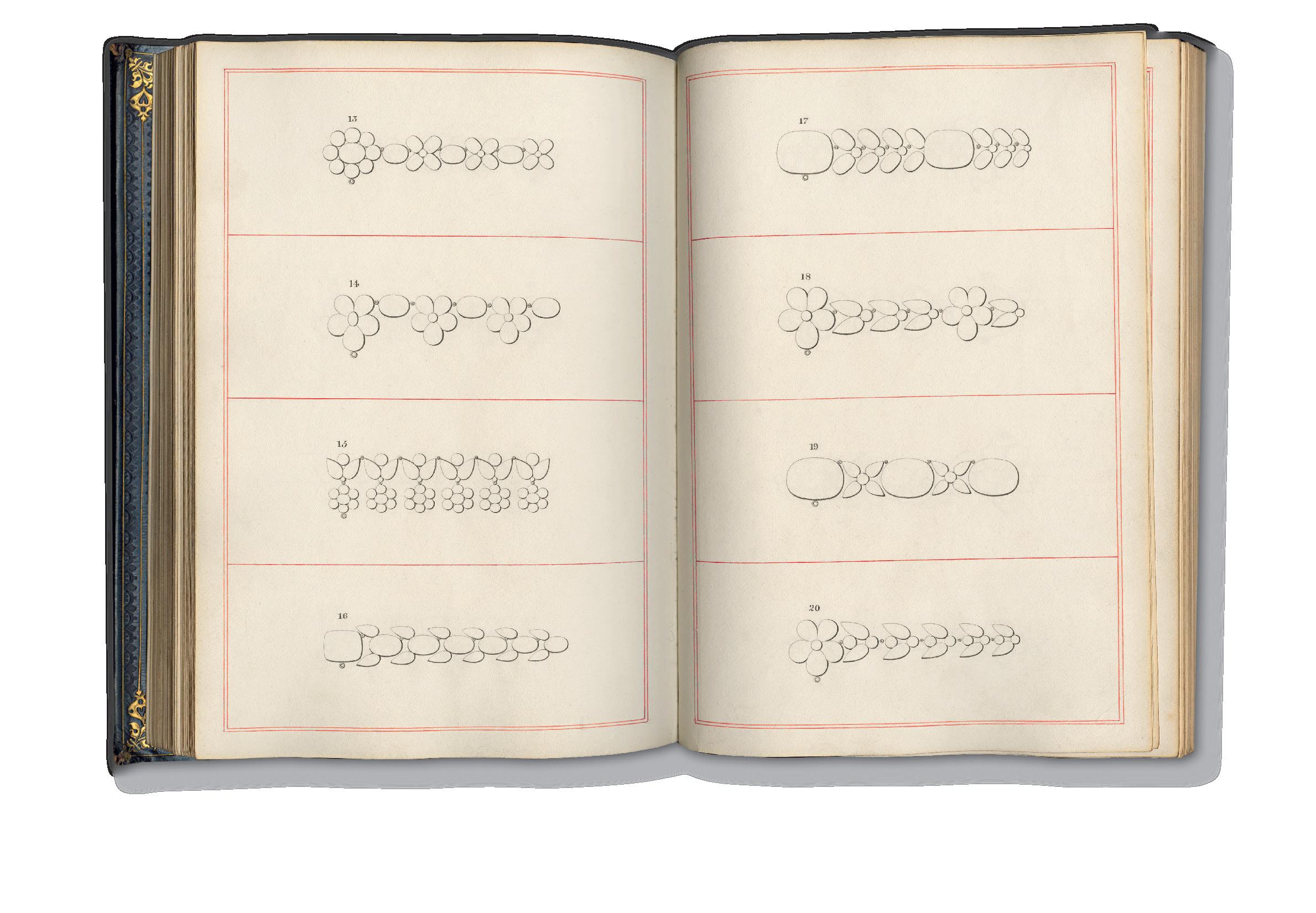
Designs for sections of necklaces and bracelets
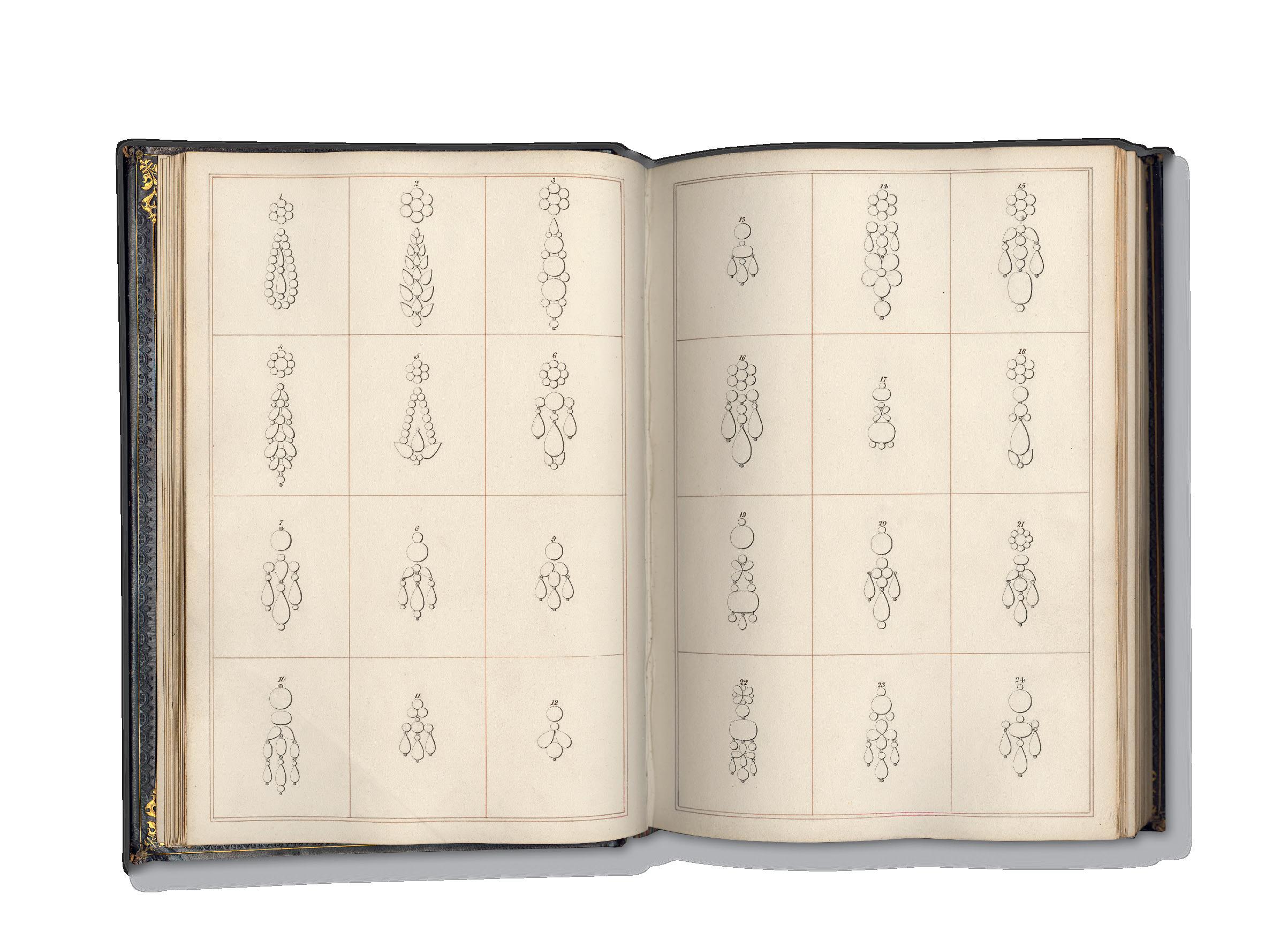
Designs for chandelier earrings

Designs for cross pendants
By Alfred Schaller, Munich
Germany, possibly compiled in 1923 of jewels dating c. 1880 – early 1920s
The nineteenth century was a fertile period for jewelry designers. The successful “ Great Exhibition of Works of Industry and all Nations, “ held in London in 1851, was the first international trade exhibition of its kind, attracting exhibitors and visitors from all over the world and inspiring similar events in Paris (1855, 1867) and Vienna (1873). They showcased how nineteenth-century jewelers and jewelry manufacturers were looking to the distant past and to distant lands for design inspiration. In Europe designers were pre-dominantly influenced by the arts of the ancient world, and by the Gothic, Renaissance, and Rococo styles. Often these revivals grew out of distinct national histories, such as the NeoRenaissance “ Fontainebleau “ style in France, or were fueled by patriotism. Alongside these new trends, conservative diamond jewelry fashions continued to be appreciated and sought after by the aristocracy, especially after the 1867 discovery of a new diamond source in South Africa flooded the market with more affordable gems.
Munich-based Alfred Schaller, who signed and dated this album in 1923, appears to have kept a record of jewelry designs offered by his manufacturing company from the 1880s to the early 1920s. The vast number and range of jewelry sketches in the book reflect a variety of historicist tastes in jewelry from this period, predominantly German and Austrian. These include NeoRenaissance designs, elaborate Neo-Rococo jewels, and the finely-set diamond jewels of the Belle Epoque in the chic “ Louis XVI style “ with bows and garlands. Some drawings seem to depict historical jewels from Roman and Egyptian antiquity, India and South America, perhaps after examples seen in museums, but, as with most of the jewels depicted in the album, he notes their gold content, the gemstones used, weights in carats, and further production details. He includes jewels inspired by nature but these are more conservative in taste, rather than reflecting the more modern Art Nouveau style.
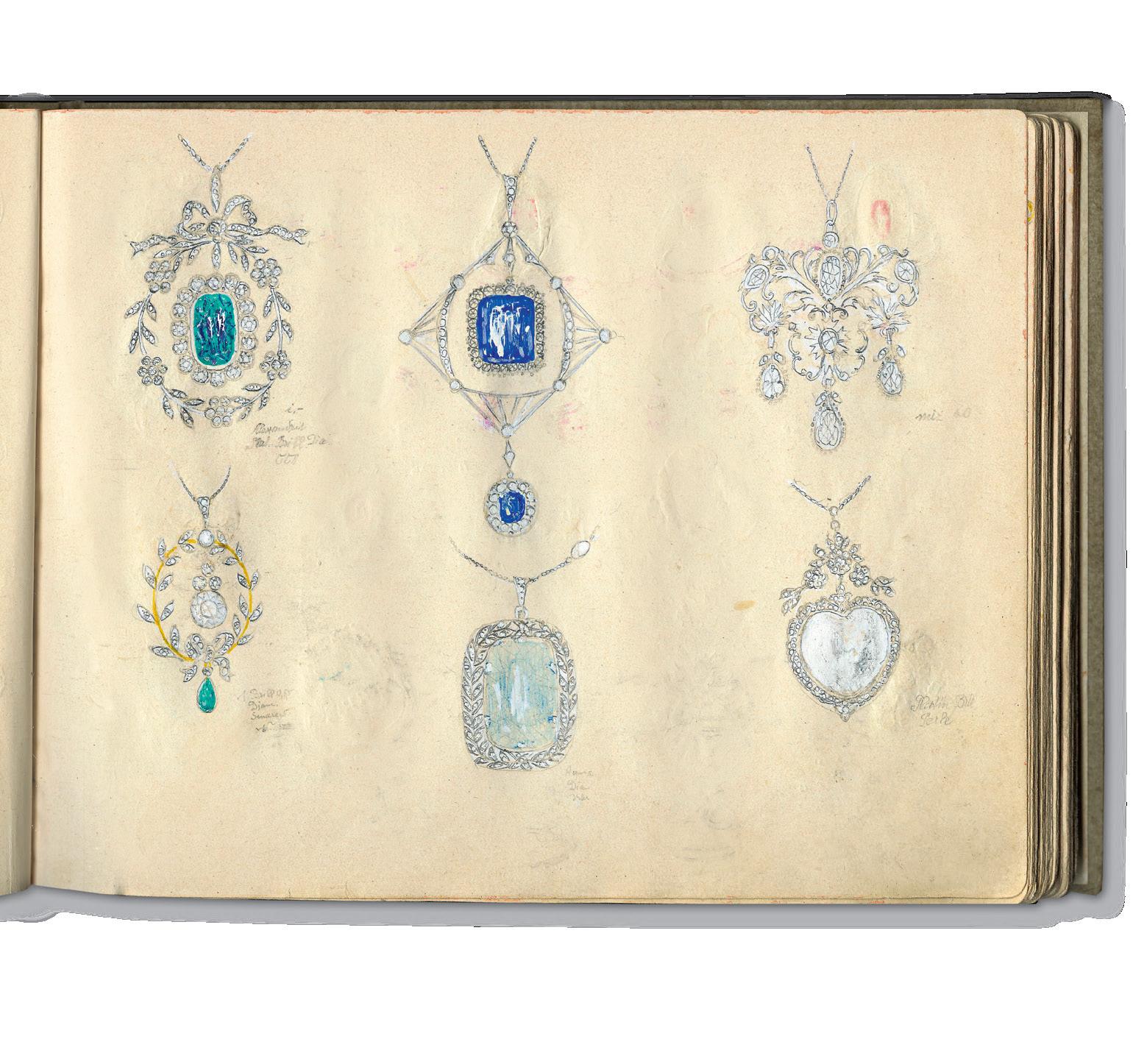
Drawings for gem-set pendants in the garland-style
c. 1188 drawings drawn directly on an album. In pencil, ink, gouache, on glossy thin paper. Largely annotated, handwritten notes in German. 190 pages (13 are blank) with a highly varied number of drawings (between 1 and 20 per page), also varying in size. Pencil and colors have bled on some pages, otherwise in good condition.
Album: Patterned paper binding with dots and small decorative colorful motifs. Date, name, and specific address of the owner on first flyleaf: Alfred SCHALLER, Munich 1923. In good condition. Dimensions 150 x 195 mm .
This sketchbook includes numerous drawings of jewelry and various small ornaments of all kinds and sizes. Some pencil inscriptions (mentioning grams or dimensions of the pieces) lead us to believe that these drawings are made from existing objects, rather than original creations. Many rubbings of seals, medals, and tobacco boxes reinforce this idea and even suggest that the author sometimes directly manipulated these objects. For the other drawings, the lines, made with a sharp tool (sometime visible on the verso of the sheets), are extremely precise and show no hesitation, suggesting these drawings are tracings. However, several pages have areas painted with white gouache, as if to cover mistakes. One page shows different cuts for stones. The annotations are varied and uneven, but clearly from the same hand, just like the drawings.
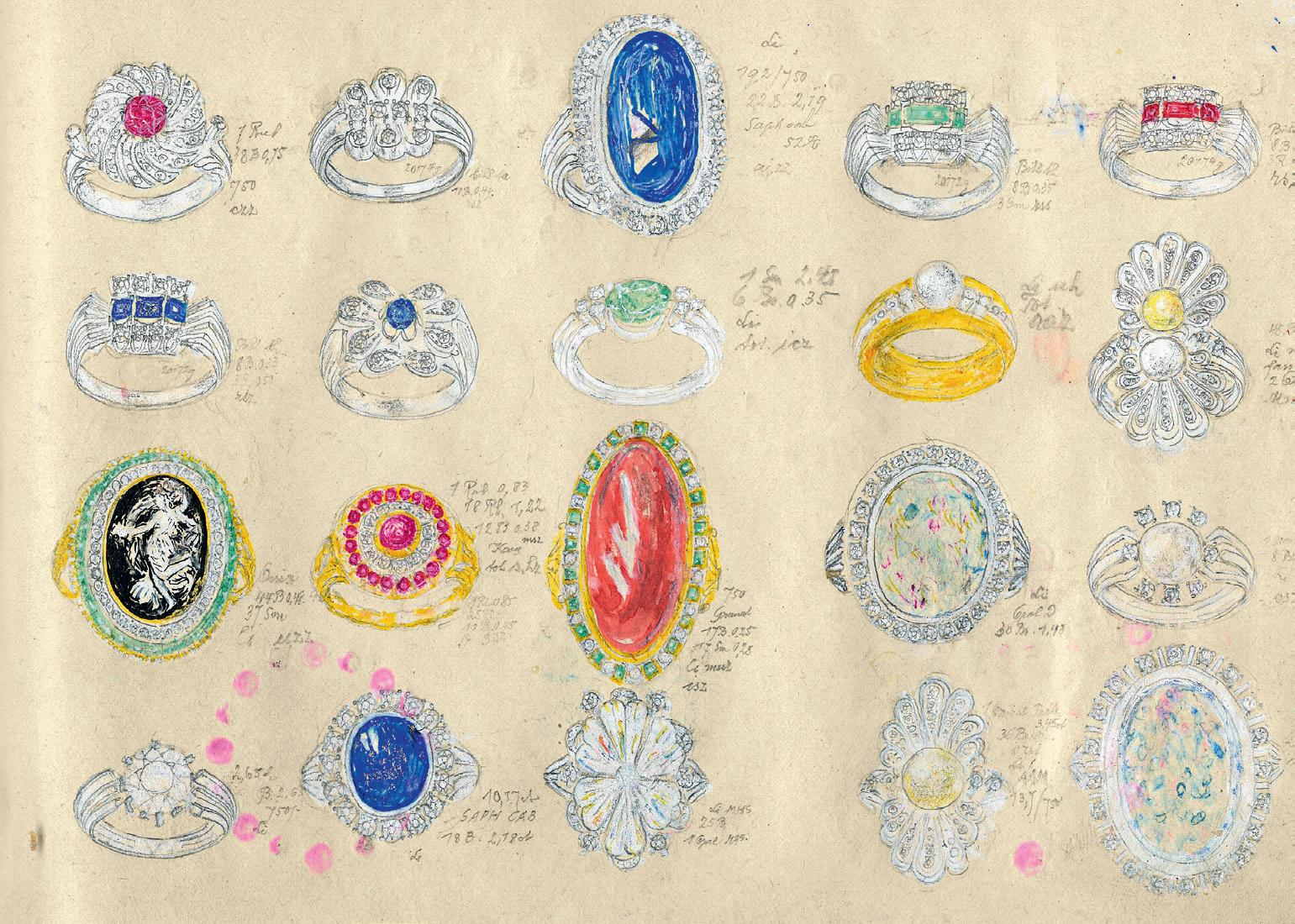
Drawings of rings in a variety of styles
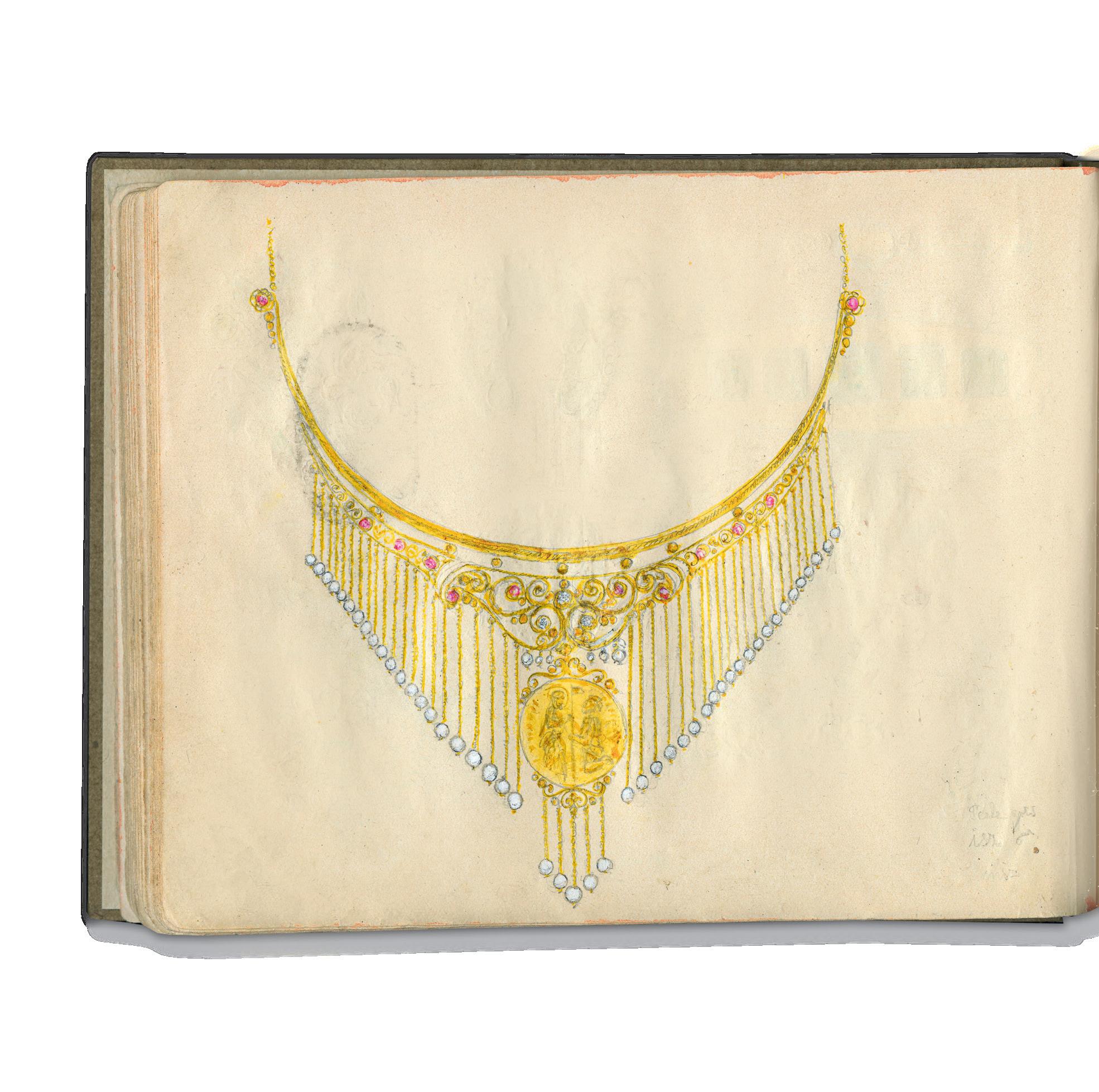
Drawing of a necklace in the Archaeological style with ancient coin
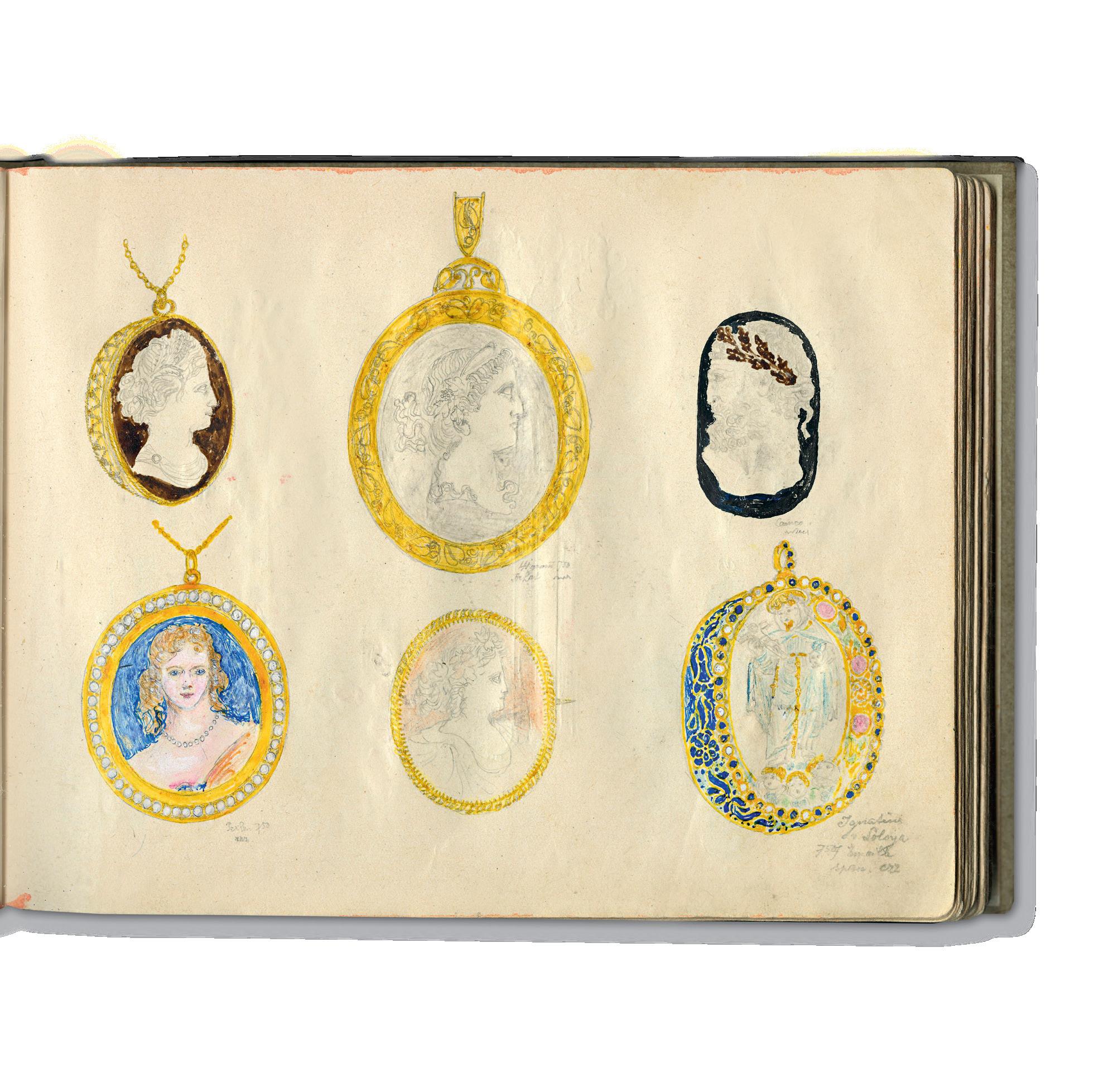
Drawings of pendants with cameos and miniatures
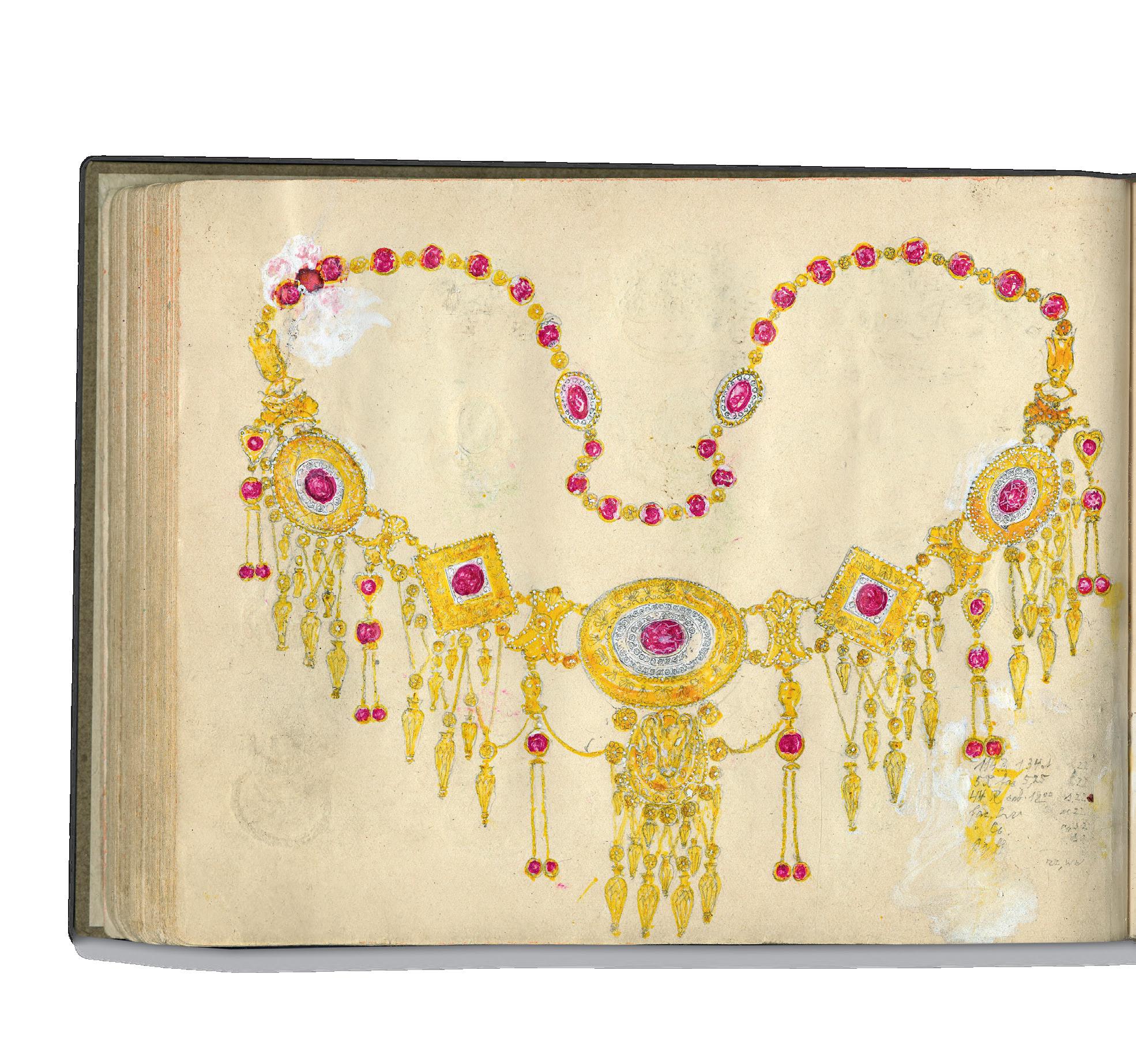
Drawing of necklace in the Archaeological style

Drawings of rings in varying historicist styles
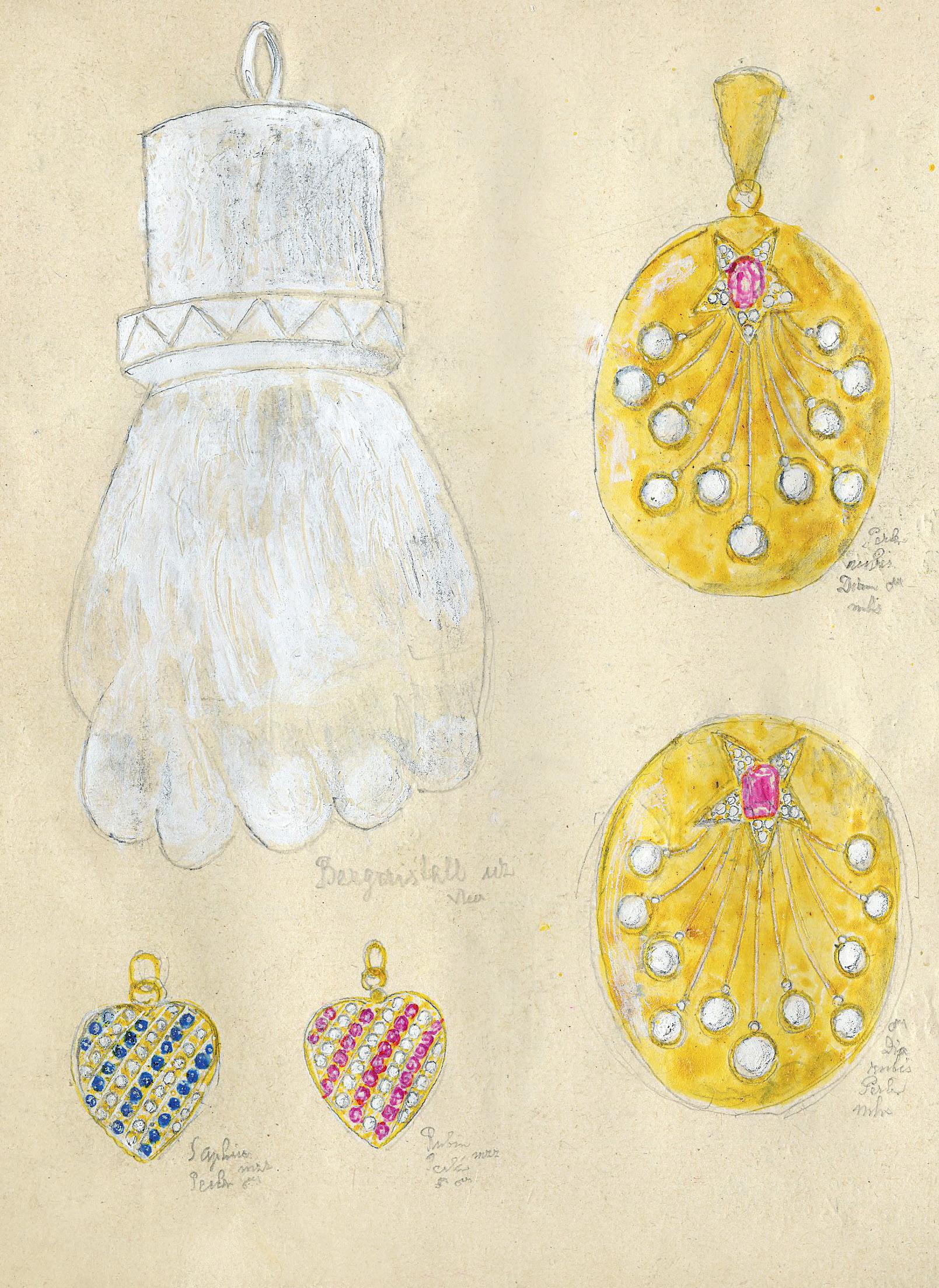
Drawings of pendants with figa, hearts and starburst designs
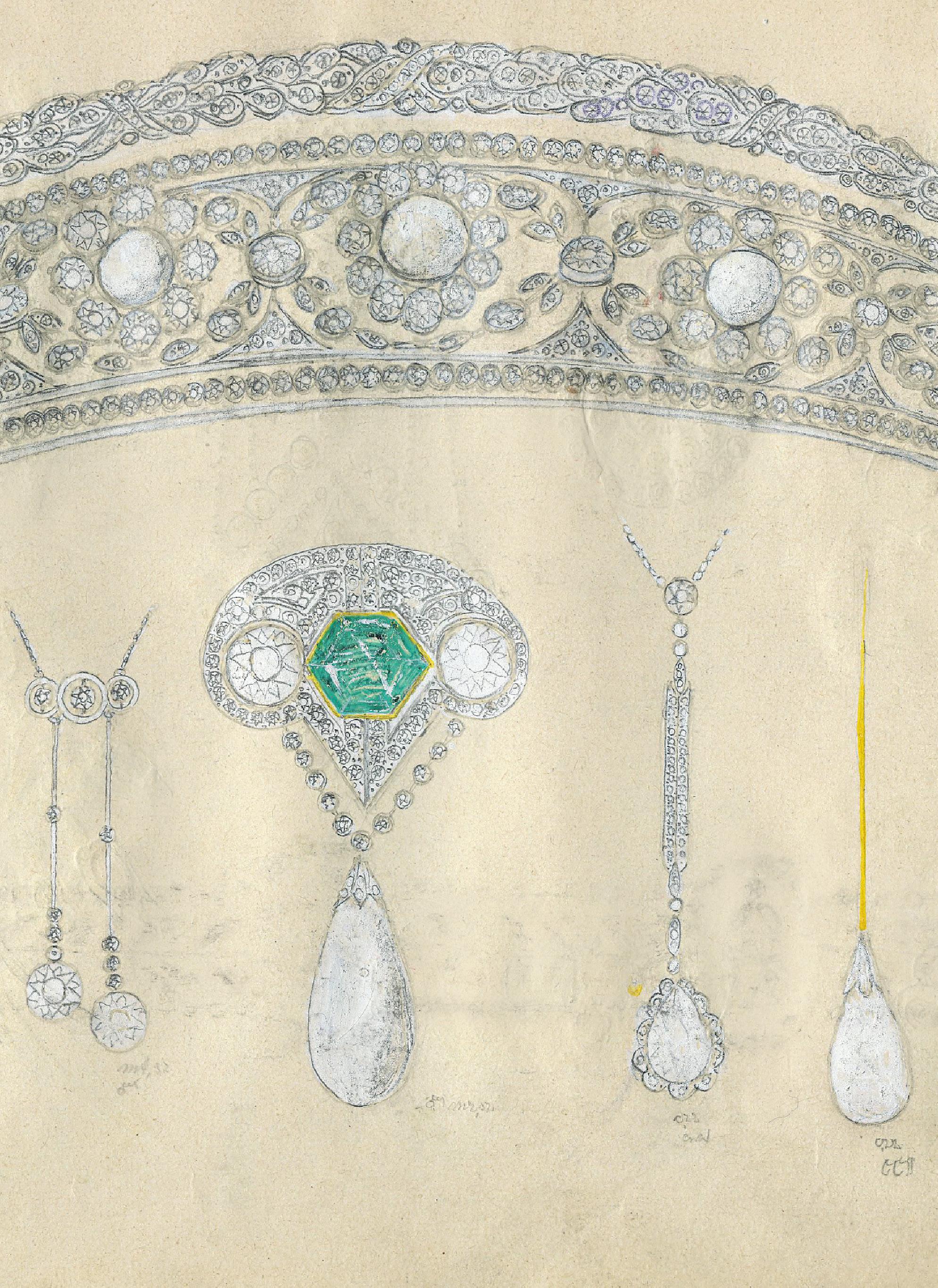
Drawings of diamond-set tiara and pendants with emerald and pearls

Drawings of pendants in different styles and varying gemstones
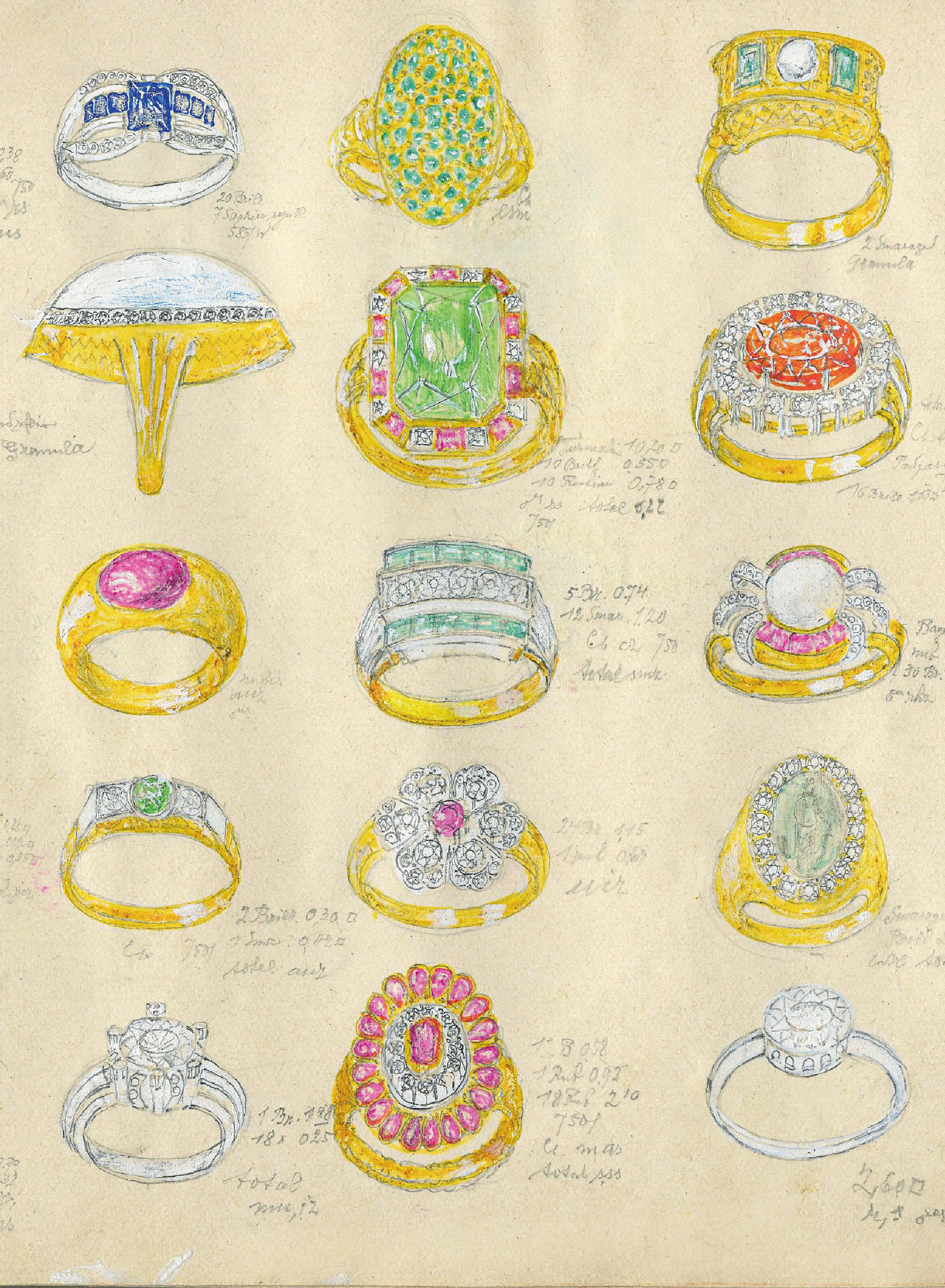
Drawings with a variety of gem-set rings
Probably France, c. 1880s-1900
Dress accessories such as hair combs and buttons were part of the jewelers’ repertoire. Hair combs as decoration, rather than purely functional, appear to have developed in the later decades of the eighteenth century when voluminous hairstyles were in fashion and gained in popularity as jewels in their own right over the course of the nineteenth.
This scrapbook is full of detailed hand-colored designs for ornamental hair combs and decorative roundels, probably buttons and possibly brooches. It may have been the source book for an artist or designer working for a jeweler. The coloring of some of the hair comb designs suggests they are to be crafted from tortoiseshell, horn, or ivory. Some echo the shape of the high-fronted Spanish mantilla comb or “ peineta, “ worn proud on the head secured into high-piled hairstyles. These had been fashionable across Europe in the 1830s, fallen out of favor and been revived in the 1870s when large coiffures came back into fashion and when the Paris production of Bizet’s Spanish-set opera Carmen in 1875 became a sensation. Some of the designs possibly reveal the influence of the Arts and Crafts aesthetic which emerged in the 1880s with the use of flowers, foliage, and birds, the asymmetry of some perhaps hinting at the later emergence of the Art Nouveau style. The roundels reflect nineteenth-century neo-medieval and neo-Renaissance Revival motifs such as playful cherubs, interlaced scrolls, cartouches, and fantastical birds and beasts. Some are gently humorous such as a cupid on a boat, cherubs riding cockerels and crickets, and boys riding doves, many of them symbols of love. The bright colors perhaps indicate the use of enamel to contrast with the gold or gilded metal.
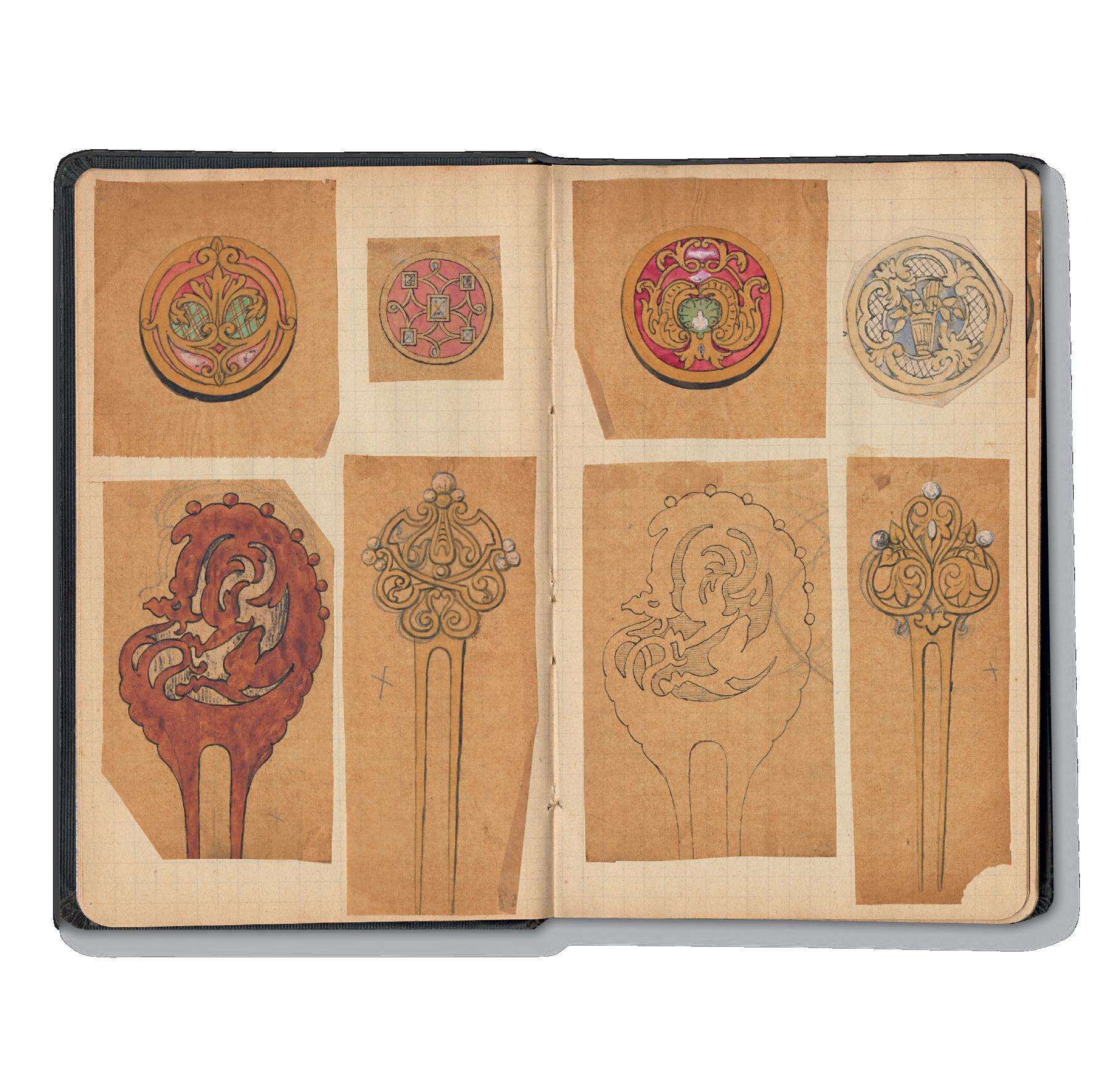
Sketches for hair combs and roundels
278 sketches, 261 on tracing (vellum?) paper and 17 on card. Pencil, ink, and watercolor. The size of the drawings varies, ranging from little roundels of 12 mm diameter to larger drawings measuring 110 x 120 mm. Excellent condition.
Album: The sketches are glued into a square-ruled notebook of 140 pages. The last 34 pages are empty. The notebook is bound in original black cloth, printed endpapers, stationery’s ticket “Papeterie Centrale des chemins de Fer/ L.& D. Grebel /83, Boulevard Magenta/ Paris” with price in pencil “3.25 /£ 98”. Dimensions 184 x 115 mm.
There is a stylistic coherence throughout the entire ensemble, certainly executed by the same hand. The recurring shape is the roundel with figurative motifs, probably intended for medallion-shaped pendants, lockets, or perhaps even watch cases. There is a selection of designs for ornamental hair combs. The finishing stage varies, the sketches evolve, initially drawn in pencil, with touchups. The floral or animal shapes evolve and are reworked with ink and watercolor, becoming more detailed. Notably, there is a series of 11 round sketches with a 40 mm diameter, all on a pink background, drawn in ink with white highlights. These sketches feature animal motifs and have a fairytale-like quality, depicting for example cherubs, fantastical creatures, putti, or musical instruments. Some sketches are marked with a pencil cross, likely indicating a selection among similar variations.
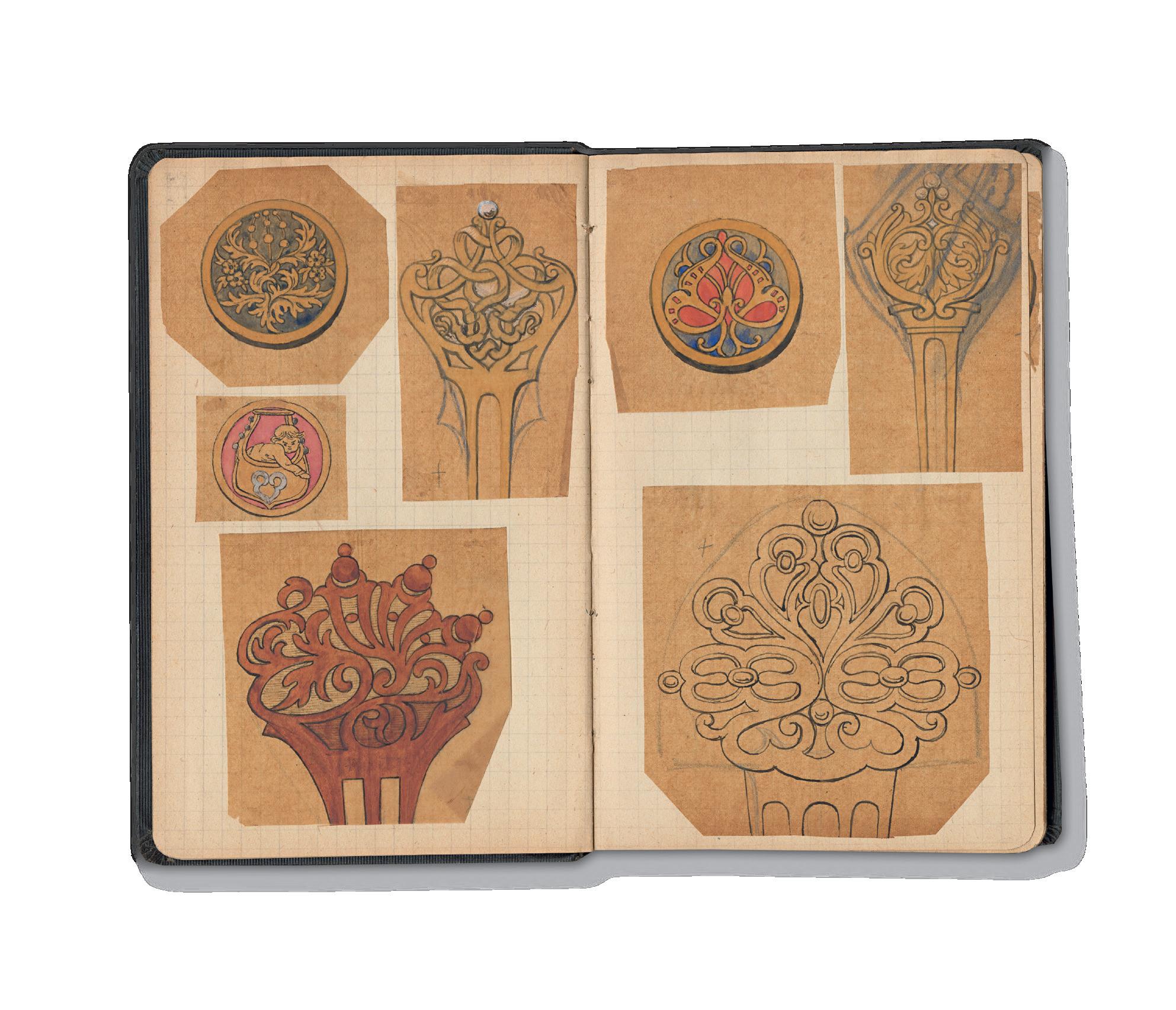
Sketches for hair combs and roundels
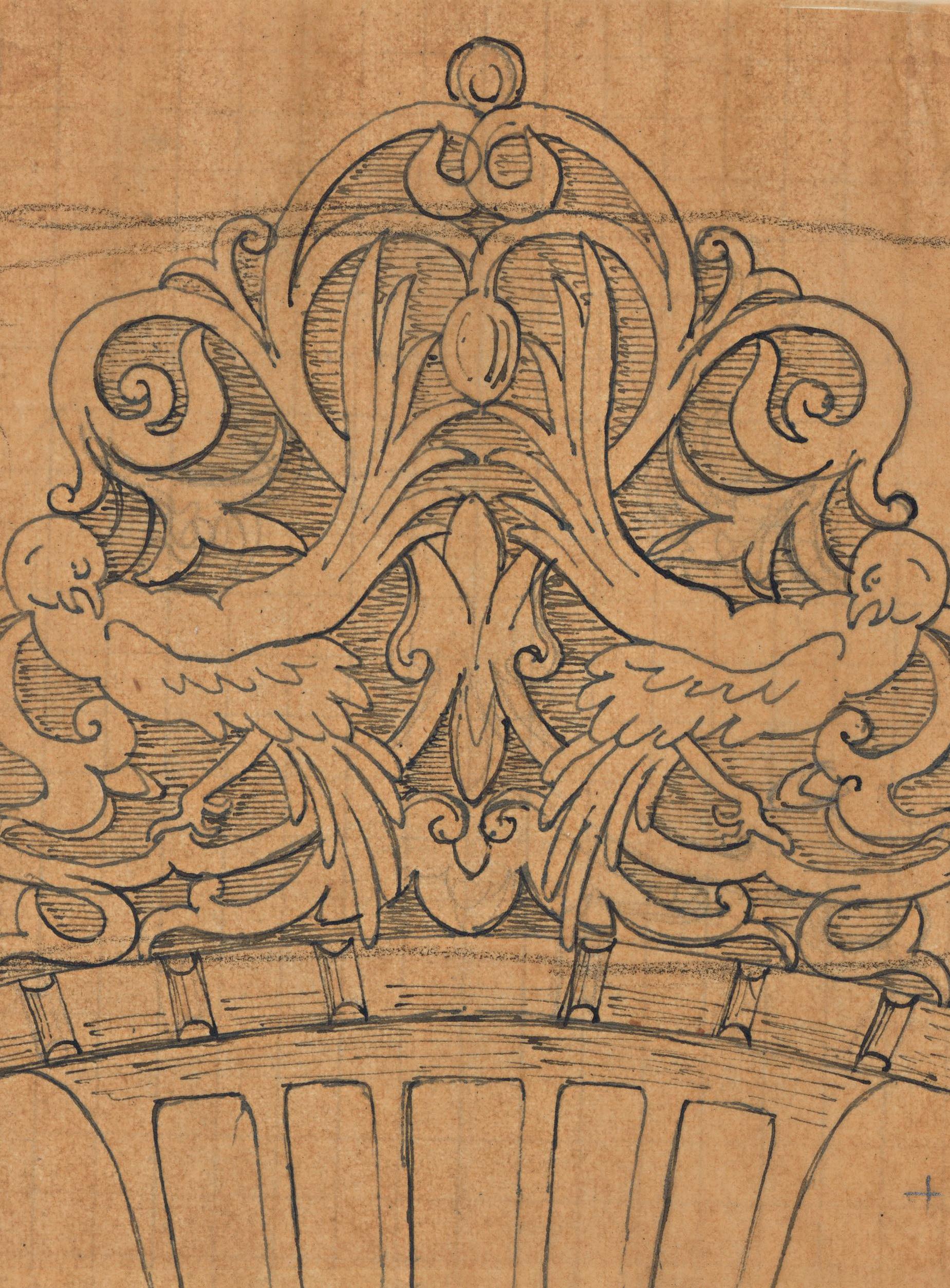
Sketch with detail of a hair comb and bird motif
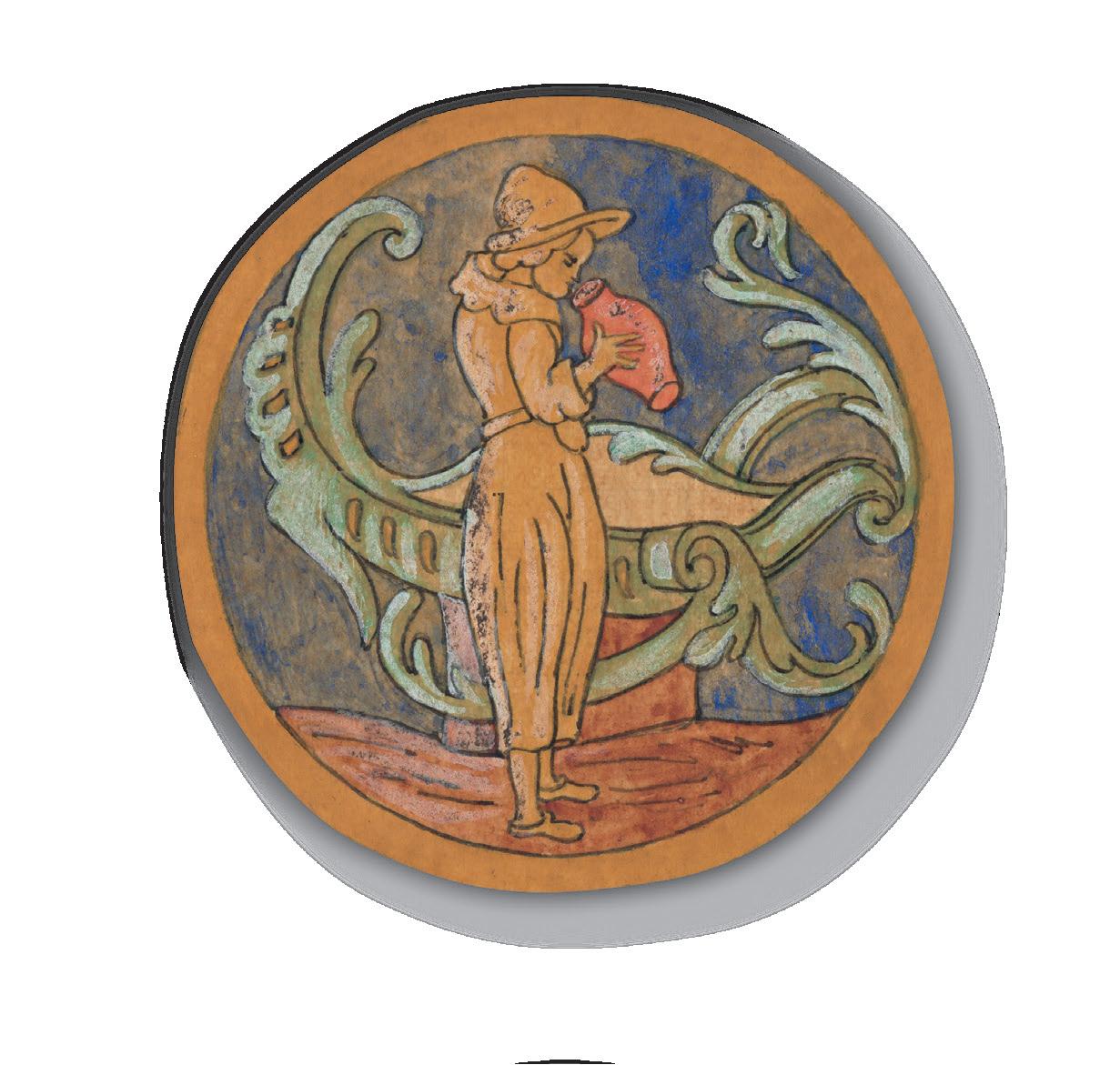

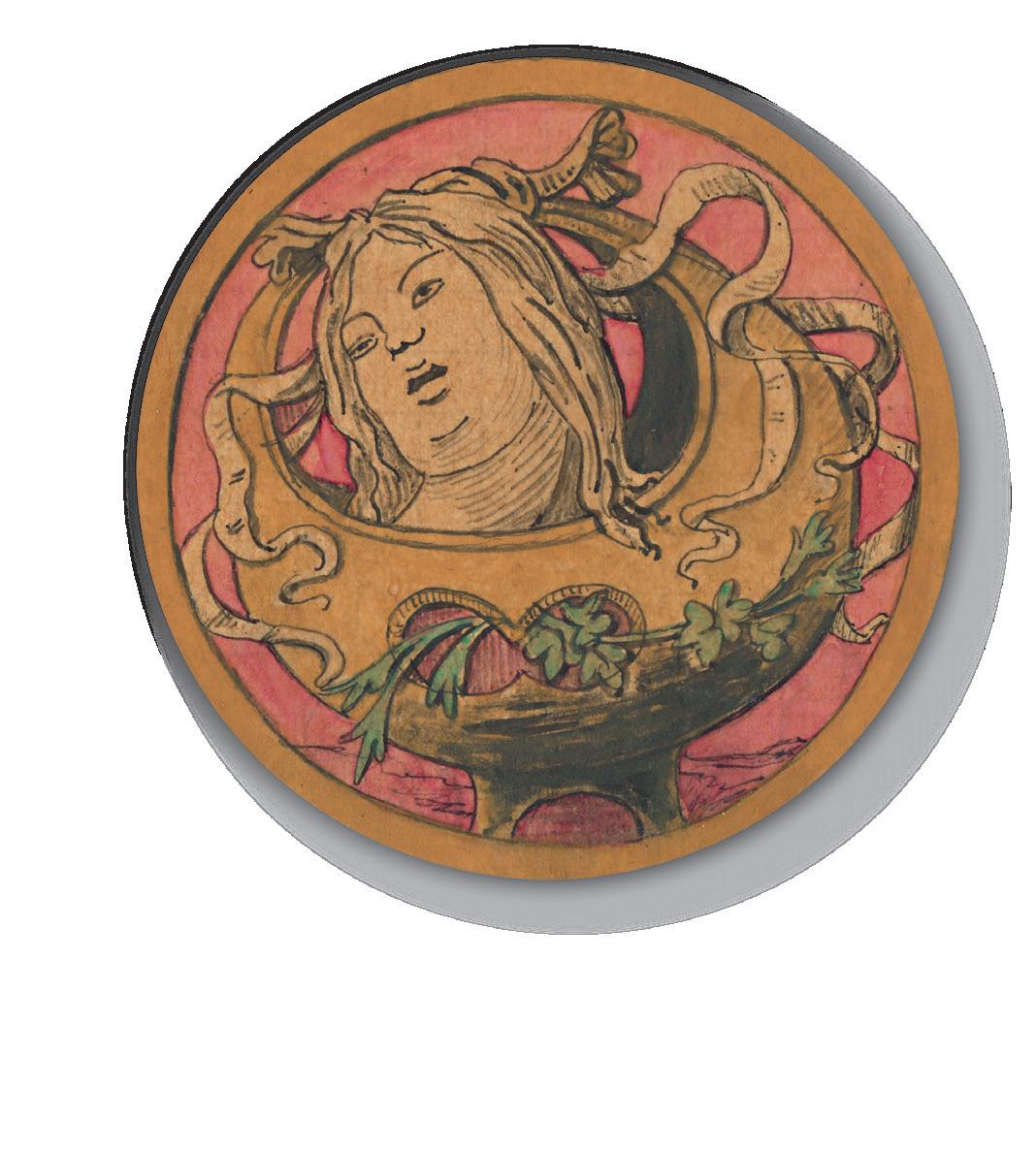
Sketches for roundels
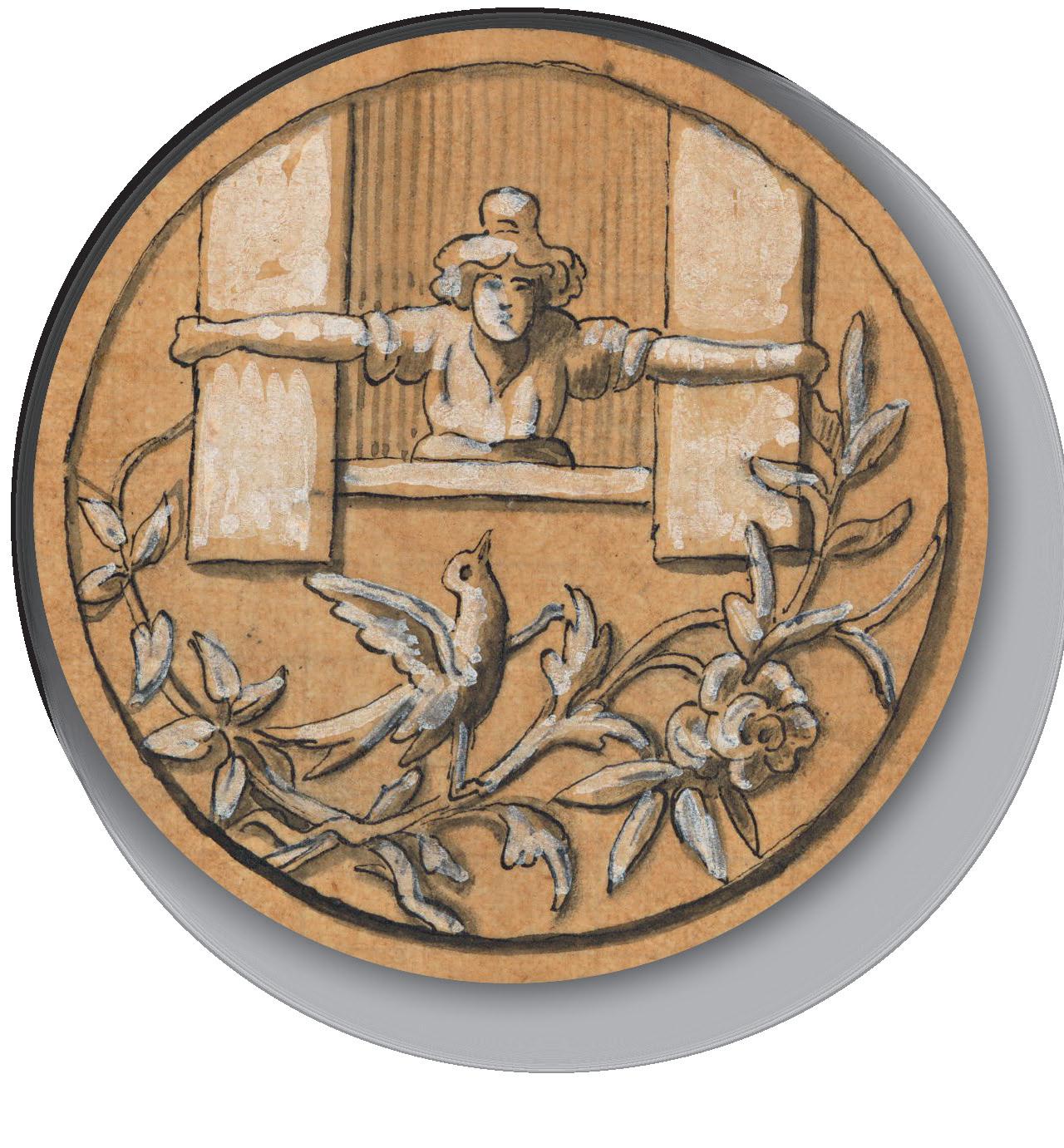


Sketches of a roundel, hair comb and ornament with violin playing figure

By Jules Chadel (1870-1942) for Georges Fouquet (1862-1957)
Paris (France), c. 1900-1905
Born in Clermont-Ferrand, Jules Chadel moved to Paris in 1893, where he attended the École des Arts Décoratifs, and remained in the city until his death. He was a multi-talented artist, painter, sculptor, illustrator, draughtsman, and engraver, though less known for his extensive jewelry designs. The jeweler Georges le Turcq recognized his talents and employed him as a designer from 1897 to 1904 when Art Nouveau was at its peak. This artistic movement culminated in the 1900 Exposition Universelle in Paris where René Lalique was lauded as the emancipator and modernizer of jewelry. Lalique’s experiments with unconventional materials such as glass and horn in combination with gold greatly inspired his contemporaries. Le Turcq also made jewels for renowned Parisian jewelers such as Boucheron and Maison Vever (founded in 1821), and it was perhaps through him that Chadel was introduced to Henri Vever. Vever mentions Chadel in his threevolume publication La Bijouterie française au XIX e siècle (1906-8), as a “ talented designer. “ Chadel designed jewelry for Vever from about 1904 and continued to design decorative objects and bookbindings for the next twenty years.
Chadel would have been familiar with Vever’s vast collection of Japanese prints and objets d’arts. The taste for naturalistic Japanese art reached a highpoint in the 1890s and early 1900s, inspiring Art Nouveau jewelers like Chadel to move away from figurative to expressive and symbolic representations of flora and fauna. The sketch here shows a preparatory design for a horn and pearl hair comb in the curvilinear Art Nouveau style. The central motif probably is meant to portray dancing nymphs in a highly
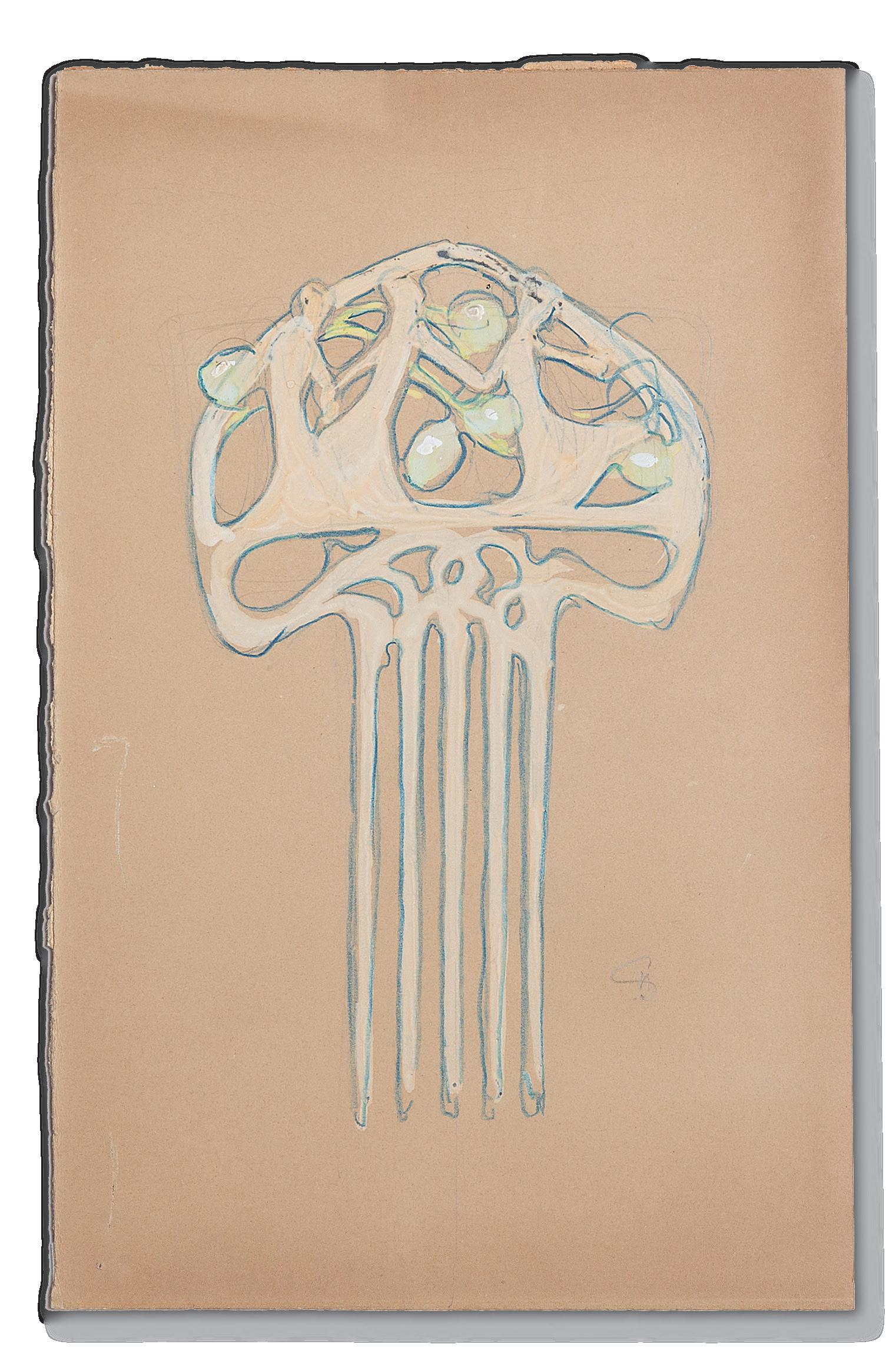
stylized rendition. The other drawings show pieces intended to be made of gold with fashionable plique-à-jour enamel, one featuring a lizard crawling across foliage with pearls. The collaboration between Chadel and Georges Fouquet had, until now, scarcely been highlighted; however it appears that Fouquet in collaboration with Charles Derosiers based the Sea Nymph pendant on a drawing by Chadel. The final choice of materials fell not on coral, which likewise evokes the marine world, but rather on translucent green enamel with diamonds as encrustations. Drawings by Chadel at the Rijksmuseum Amsterdam include an Art Nouveau comb and Art Deco jewels.

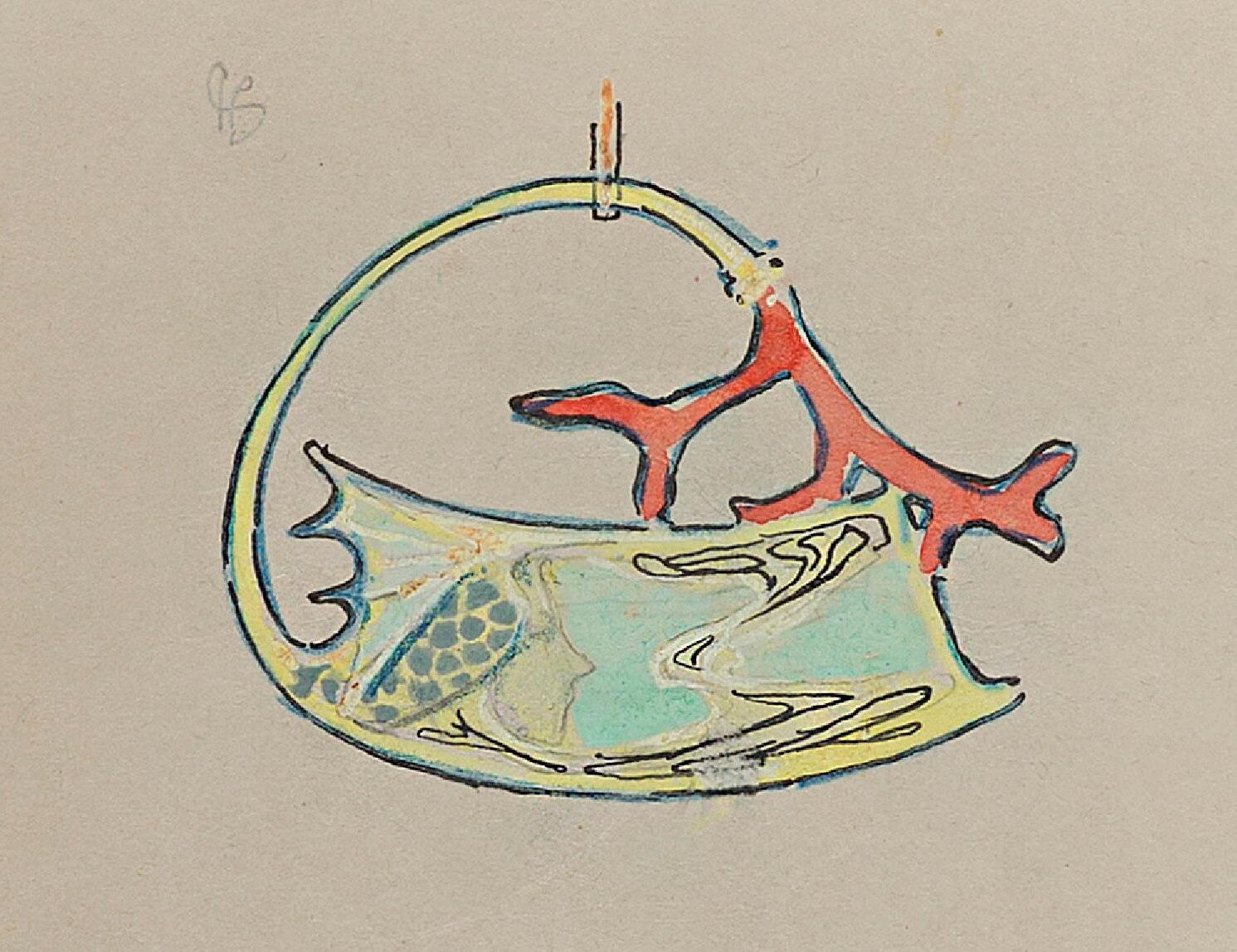
Sketch for a pendant with coral branch, marine motifs and female profile
3 signed sketches, watercolors, gouache, ink, blue pencil, and graphite on Japanese écru paper. Damp stains on the verso, otherwise in excellent condition. Framed.
a. On recto: hair comb, three human figures holding hands (with vegetal motifs possibly dancing nymphs). On verso: a basic sketch in blue pencil. Paper dimensions: 252 x 160 mm. Drawing dimensions: 178 x 108 mm.
b. Round shaped pendant: female profile with marine elements and vegetal motifs. Paper dimensions: 162 x 149 mm. Drawing dimensions: 57 x 71 mm.
c. Long shaped pendant: a lizard and vegetal motifs. Paper dimensions: 163 x 106 mm. Drawing dimensions: 111 x 44 mm.
Each sketch is signed with the monogram of the artist (J Ch) for Jules Chadel. The technique is the same for all three drawings: drawing in blue pencil, contouring in ink, traces of graphite both for underdrawings and for touchups, lavishly colored, with gouache. Each piece is a distinct creation, employing a different color palette to indicate the intended materials for the jewels (the red in the round-shaped pendant likely represents coral).
Provenance: Arsène Bonafous-Murat (1935-2011)
Bibliography: exh. cat. Jules Chadel 2015; Beatriz Chadour-Sampson/Sonya Newell-Smith 2021, p. 469; Froissard 2023, p. 190.

Probably France, c. 1890-1920
From the 1870s until the outbreak of war in 1914, Western Europe and the United States enjoyed a period of relative peace and prosperity, later referred to nostalgically as a golden age or, in France, the “ Belle Époque. “ In the European courts and among the privileged and wealthy classes, fashion and jewelry reflected splendor and elegance. Due to the discovery of significant new diamond mines in South Africa in 1867, the wearing of diamond jewelry became highly fashionable. High-end Parisian jewelers set the trends, opening branches in London. Sparked by the sale of the French Crown Jewels at the end of the Second Empire in 1887, the highly decorative styles of eighteenthcentury France — the period of Louis XV, Louis XVI, and Marie-Antoinette — were in vogue until the 1910s. Paris jewelers such as Boucheron, Chaumet, Mellerio, Vever, and Cartier created luxury jewels echoing the splendor of the royal court of Versailles. The “ garland style, “ as it was coined by Cartier, reflected the lavish use of garlands, ribbons, bows, swags, tassels, laurel leaves, and trellis or lace patterns.
The designs for jewelry in this album are examples of the garland style and show the contemporary preference for white gold and platinum. Increasingly, platinum was favored as the hardness of the metal allowed for almost invisible settings and fine outlines. Diamonds are dominant and pearls, rubies, and sapphires create touches of color.
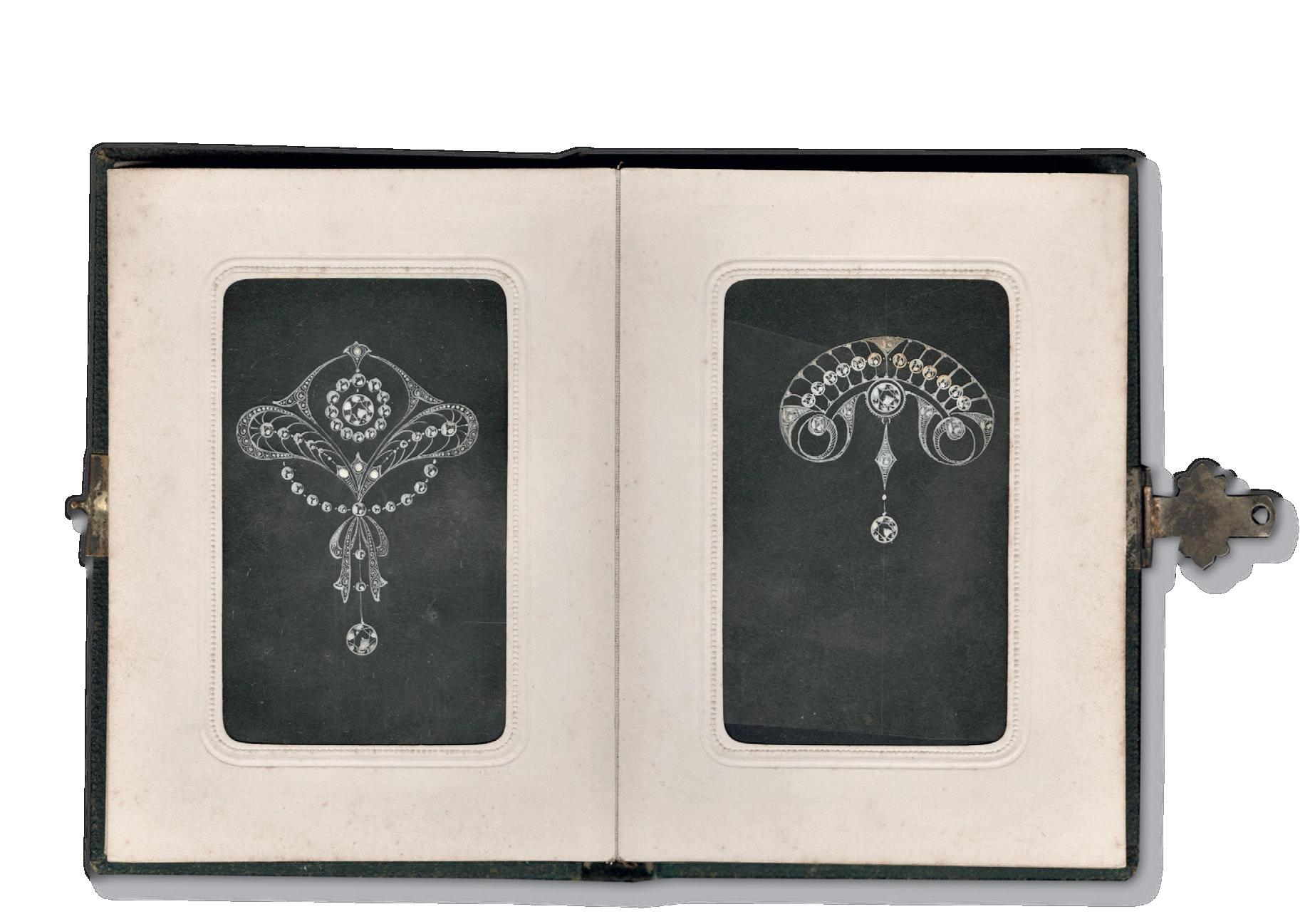
Designs for diamond-set brooches
20 gouache designs depicting pendants, brooches, and bracelets, on rhodoid (one page is on tracing paper). The designs are slipped into the openwork pages of a photo album with black cardboard on the back. Each individual rhodoid measures c. 105 x 60 mm. In excellent condition.
Album: The album itself is made of 20 pages, bound in dark blue percaline, decorated with overall hot-stamped. The binding pattern consists of diamonds connected by circles and small floral motifs. Stationery’s ticket reads “A. Préau, Pass. Du Saumon, 59." Metal clasp on the side, edges gilt; in very good condition. Dimensions 130 x 90 mm.
This album features a single drawing for each jewelry item. They are enhanced with meticulous white and black highlights, and, where necessary, subtle touches of color to represent gemstones. The designs are executed with skill and precision, most likely all by the same hand. A very thin line is used for the outline. The transparency of the material and the treatment of color create the illusion of the brilliance of diamonds, pearls, or gemstones and the play of light. The state of completion suggests that these are presentation drawings.
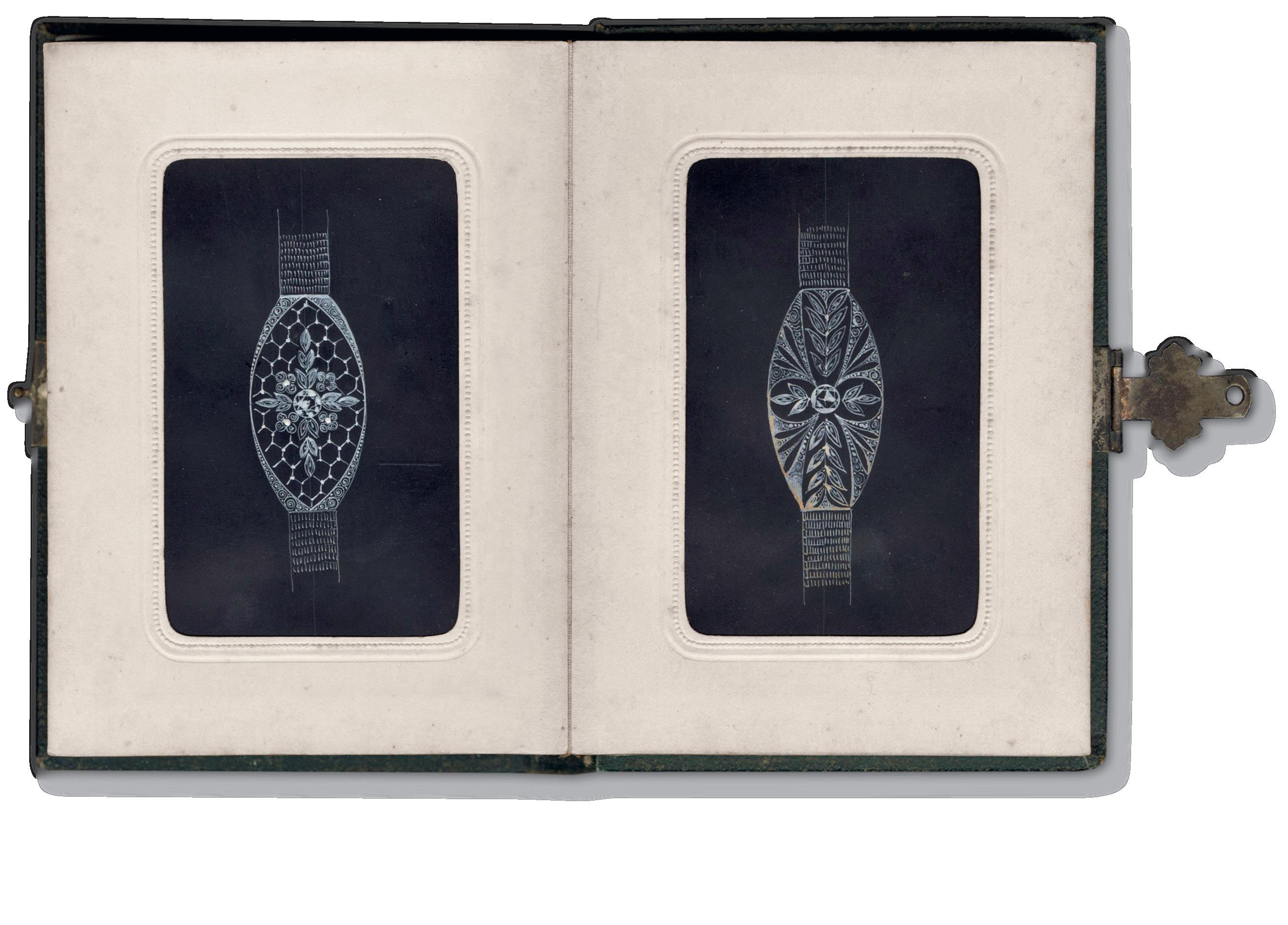
Designs for diamond-set bracelets

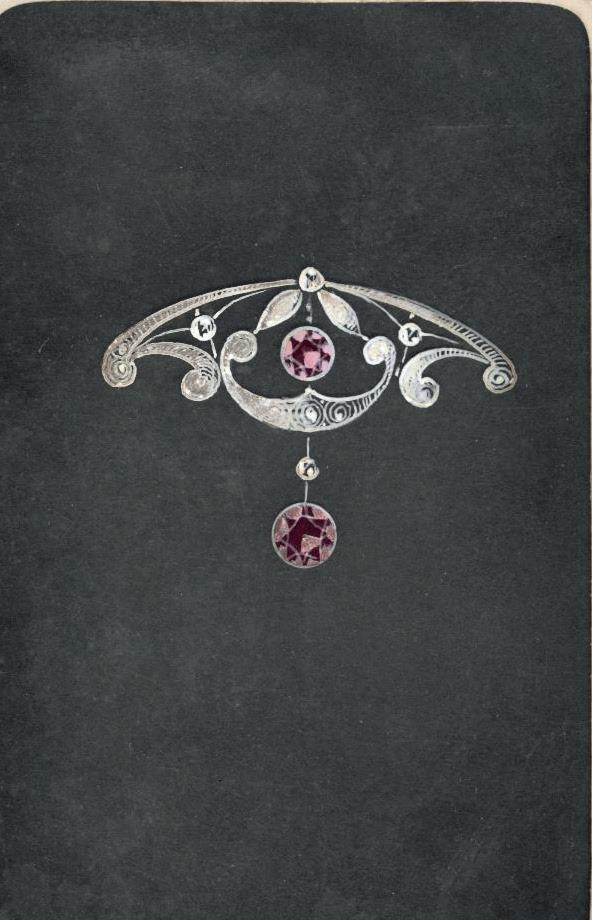
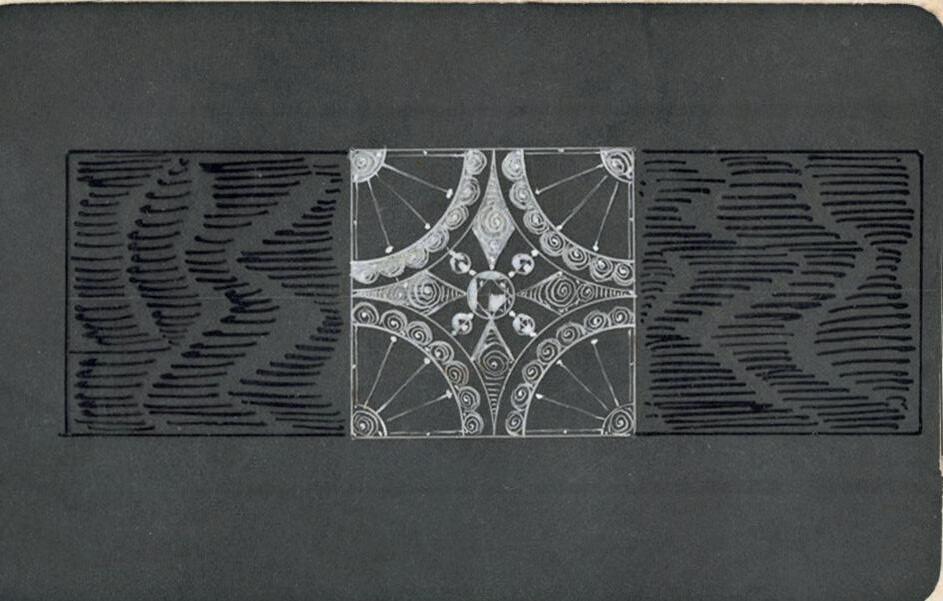
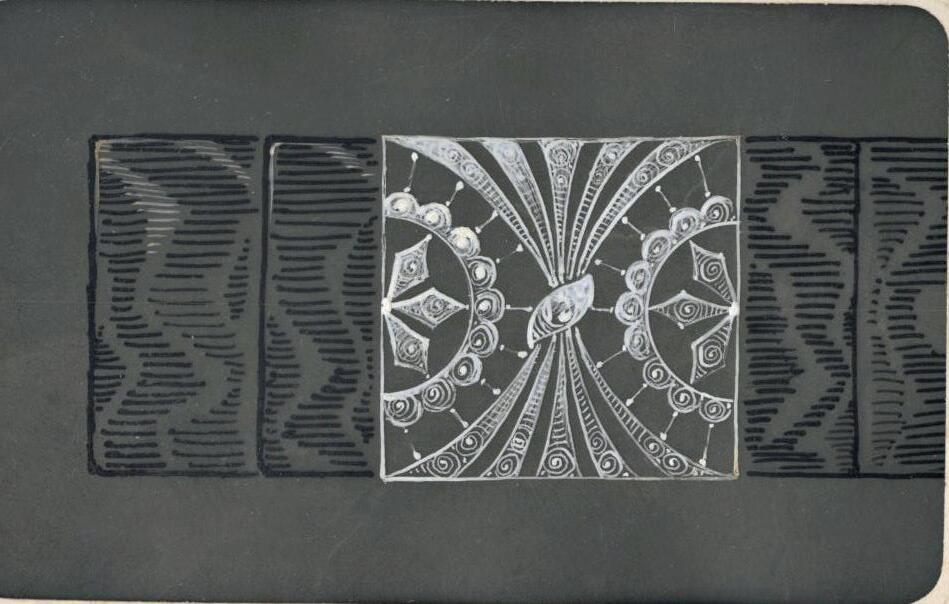
Designs for diamond-set bracelets
Probably Germany, 1920s – early 1930s
Through the centuries, finger rings have been the most consistently worn jewels, by men, women, and children. Unlike other types of jewelry such as necklaces, bracelets, or earrings, the wearing of rings was not dependent on changing dress fashions. Simply slipped onto the bare finger, they become highly personal to the wearer and mark the various stages of life. Signet rings worn by men functioned as a display of rank and authority. Decorative rings featuring a symbolic choice of motifs and gemstones, worn predominantly by women, have long signified love: presented as a sign of friendship, devotion, or a promise of marriage, or worn as a mark of grief and mourning, love transcending death. Bound by the dimensions of a finger, the goldsmiths were limited in the size of their designs but their imaginations could transform this circular form into miniature sculptures.
These two volumes, containing 286 drawings of finger rings, appear to be pattern books collated by a small manufacturer who specialized in the form. The finely-sketched designs are often grouped into variations of the same item. Many rings have identical hoops, intentionally truncated, offering a range of shoulder decoration. Bezels are occasionally devoid of a gemstone, so that the outline of the bezel is apparent and the client — or the manufacturer — can choose the cut of the gemstone. The settings are in general quite large, and the coloring suggests the use of amethyst, aquamarine, carnelian, moonstone or chrysoprase. The ornament on some of the metalwork reflects the influence of Art Deco symmetry, but the majority feature more elaborate motifs, such as acanthus, palmettes, shells, rocaille, volutes, and coiled wires. The gemstone rings would have been intended for women, the signet rings for men, the latter engraved with initials or heraldic motifs. One German inscription describing a tulip-shaped shoulder ornament (“Tulpe“) suggests the album belonged to a German manufacturer, possibly from Hanau, Schwäbisch-Gmünd, or Pforzheim, making jewelry for national and international trade.
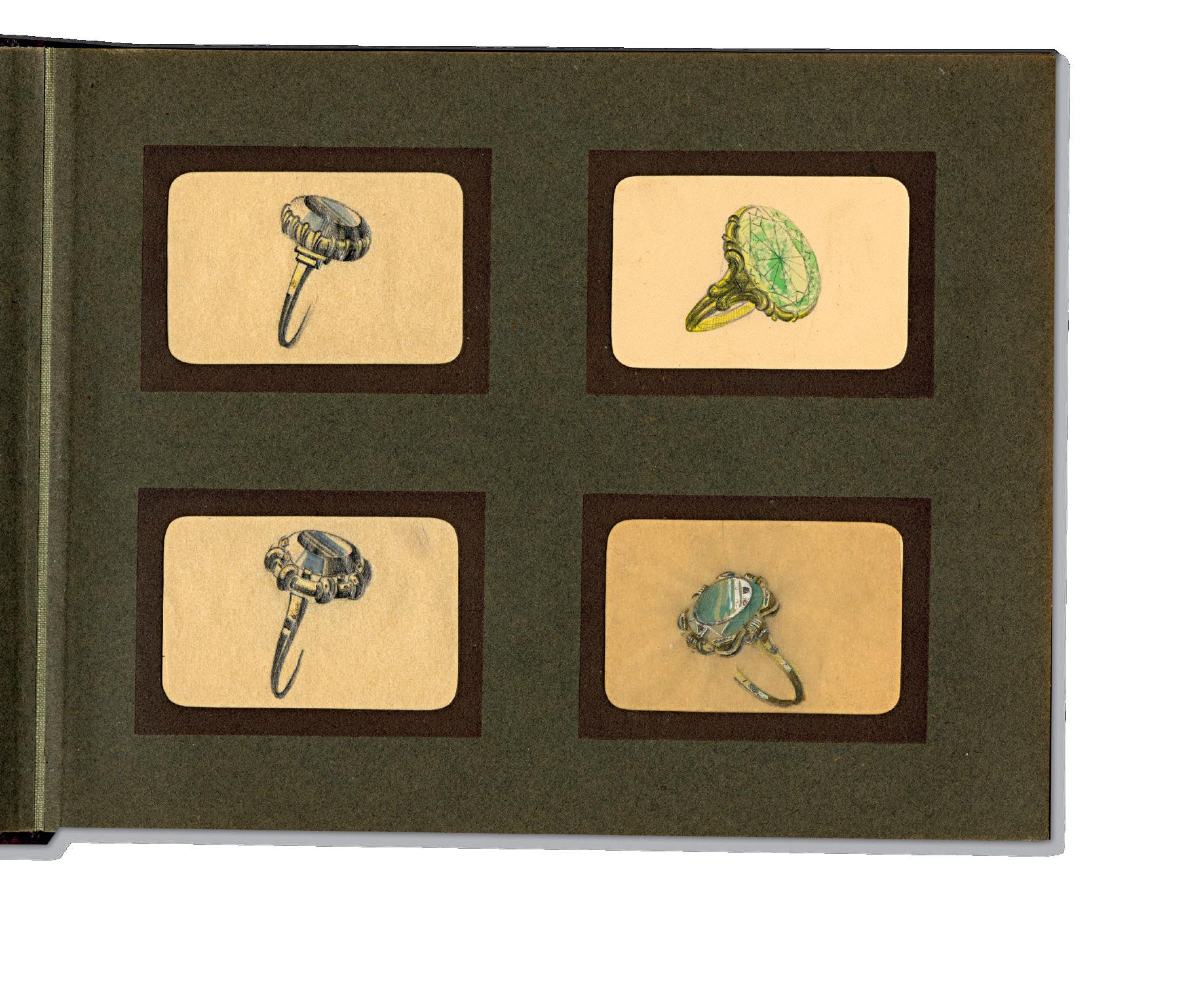
Sketches for gem-set rings
286 sketches assembled in a two-volume album. Drawings in graphite, sometimes ink, often colored with watercolors. Geometric instruments were used for the drawings. Visible glue spots on the back of the tracing paper otherwise in excellent condition.
First volume: [i]+48+[i], pages with 192 drawings, mostly on tracing paper or écru paper, occasionally brown, pink, or blue paper. The sketches include 185 rings and 7 pendants.
Second volume: [i]+24 pages+[i], with 94 sketches of rings on various types of paper: tracing paper, blue or gray colored paper, pink paper.
Albums: Each volume consists of cardboard pages measuring 150 x 195 mm, covered in gray paper, each divided into four sections where jewels sketches are inserted or glued. Blue or gray paper cut in a diamond shape. Each section measures 40 x 60 mm. Two-volume album, half-roan over cloth. Dimensions 160 x 200 mm.
In the first volume the designs show a high level of completion; the rings are depicted in profile, three-quarter view, or front view for the most part. Occasionally, the same ring is shown from multiple perspectives or several versions of the same rings are presented. The colors provide us with indications and illusion about the type of stone. Very few annotations: Tulpe (tulip) to describe a shoulder decoration motif, and some numbers, possibly sizes (12 ½/10), registration or inventory numbers (12541), probably indicating that these pieces were intended to be produced. The second volume shows a less detailed level of completion, as each ring is represented by a single sketch, mostly from the front. Several sketches are numbered here too: 9/6 ½, 16/8 or 11986, 13/7½. Sometimes a detail of the hoop or the shoulders decoration is included next to the main drawing. There is a stylistic coherence in the volumes.
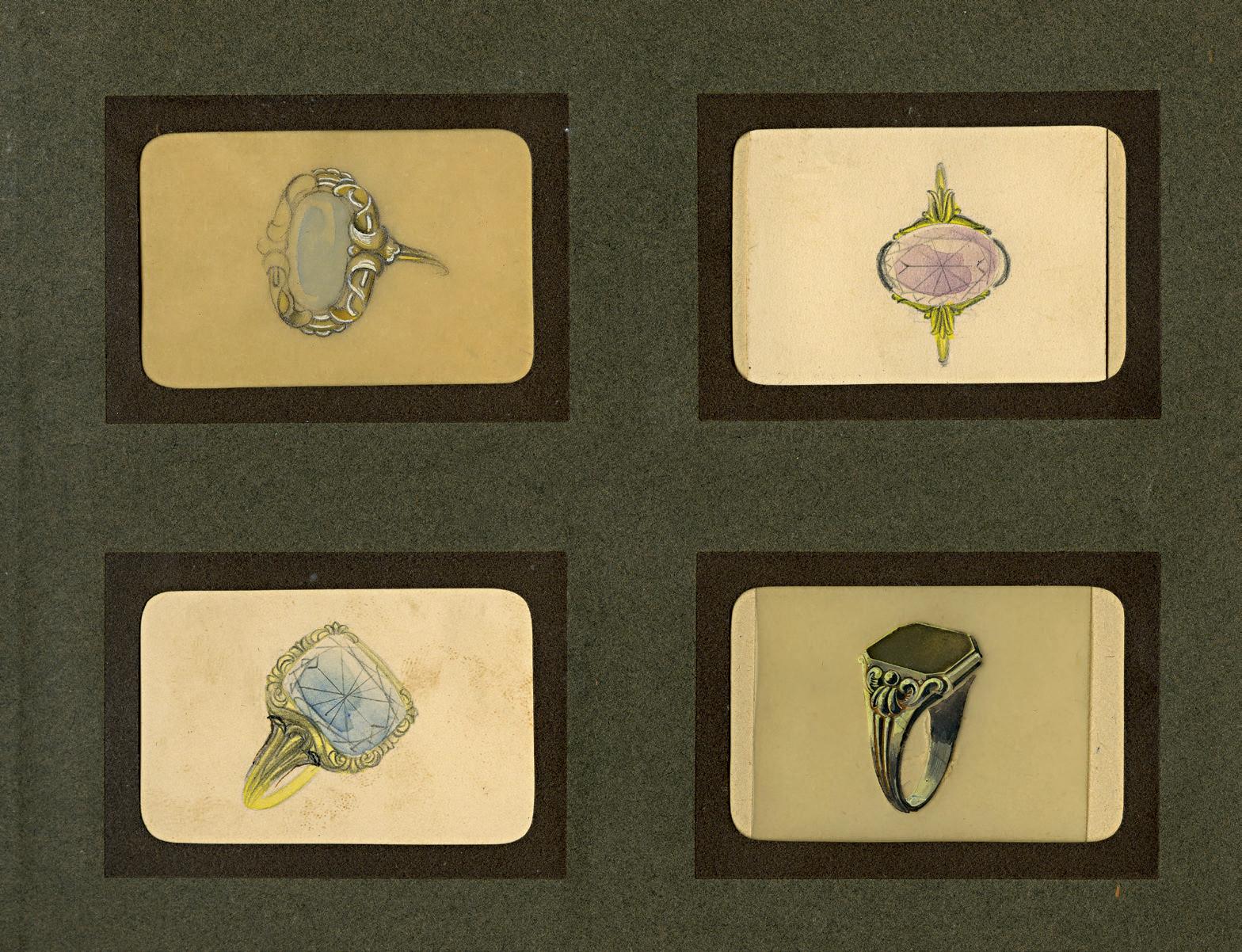
Sketches for gem-set rings

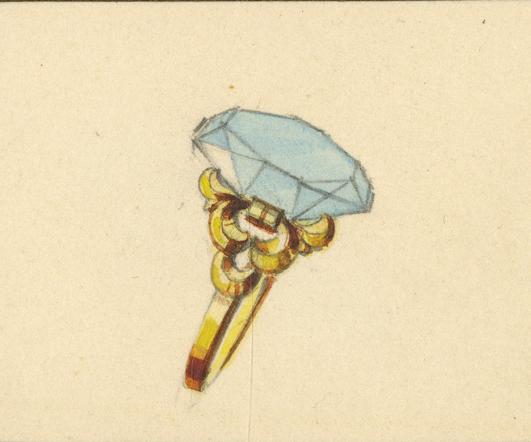
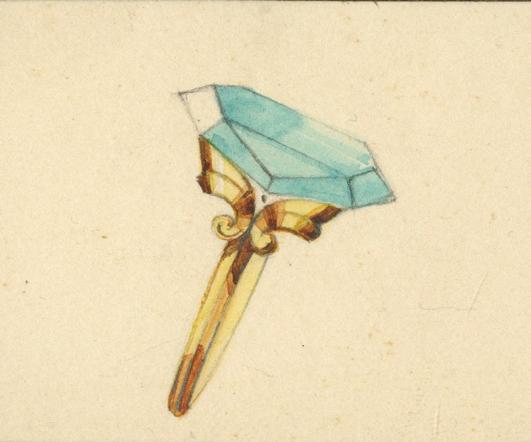
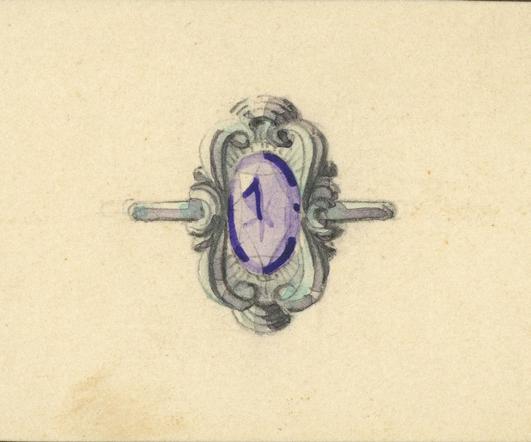
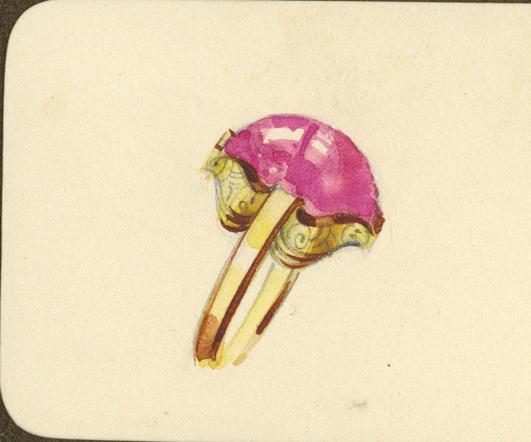
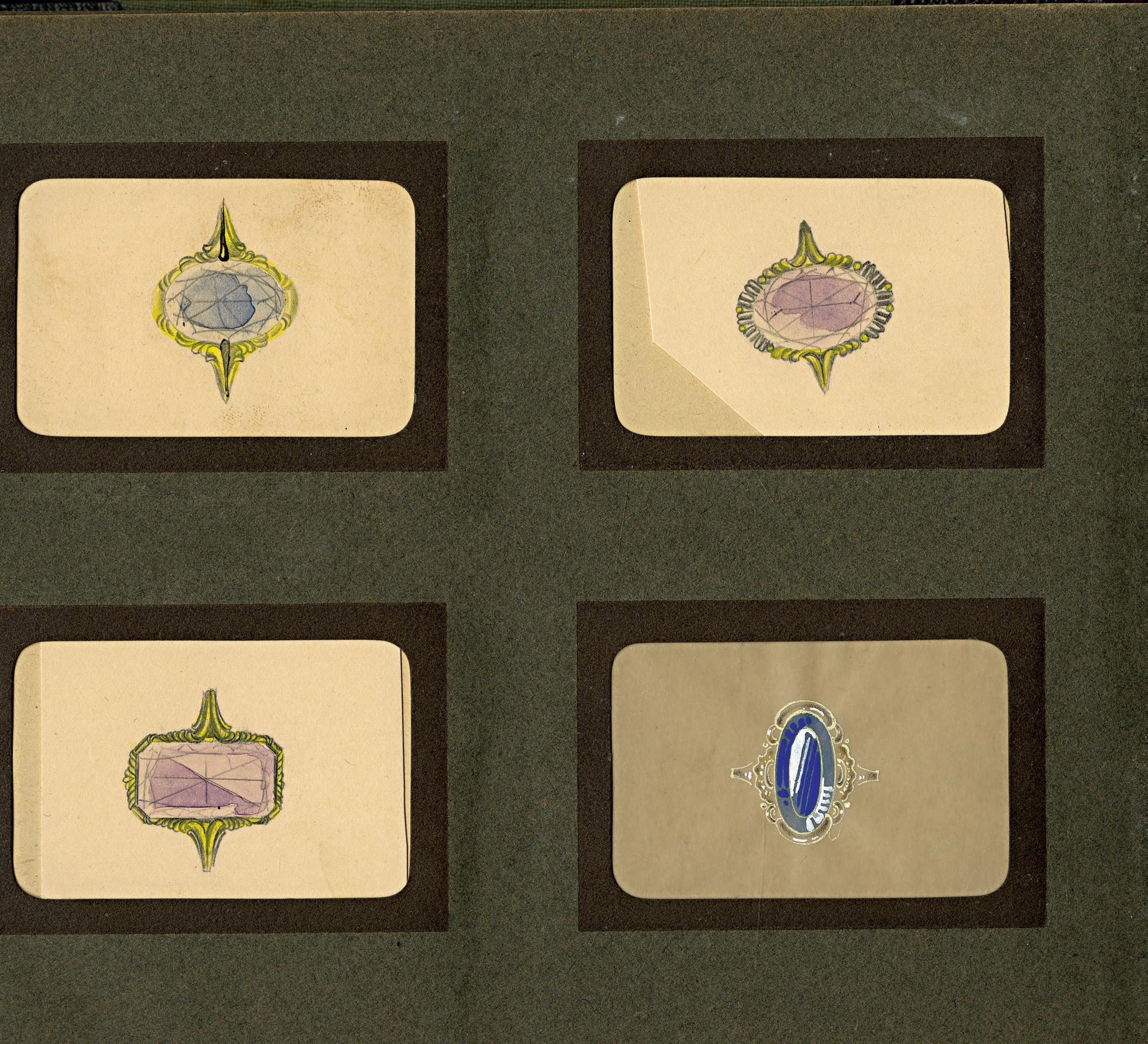
Sketches for gem-set rings

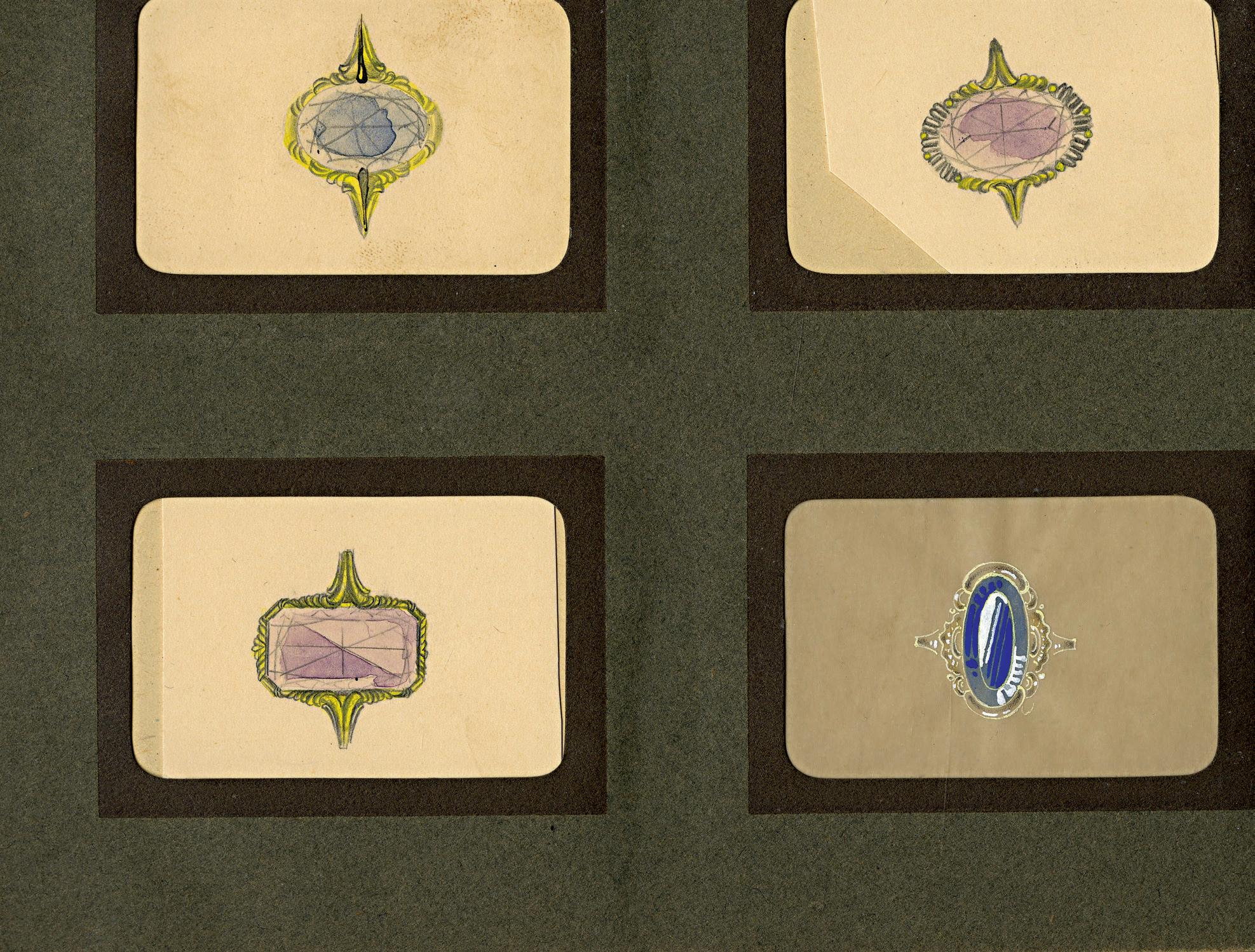
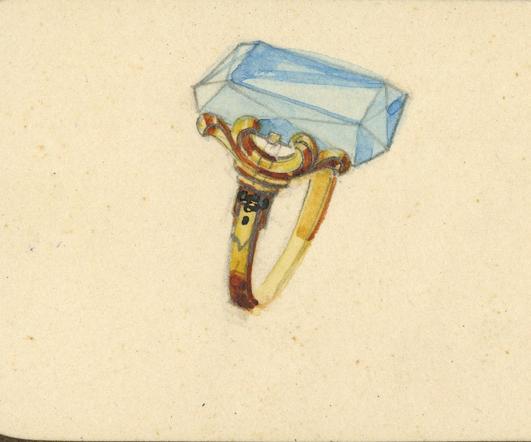
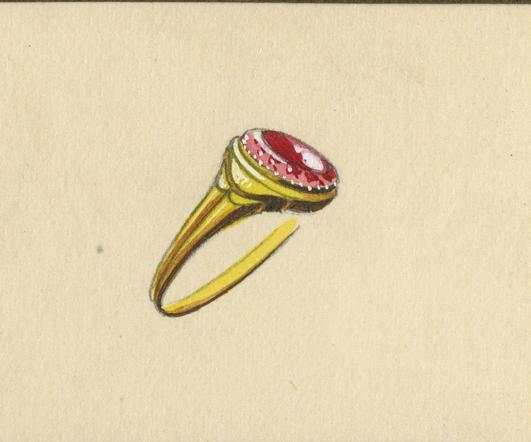
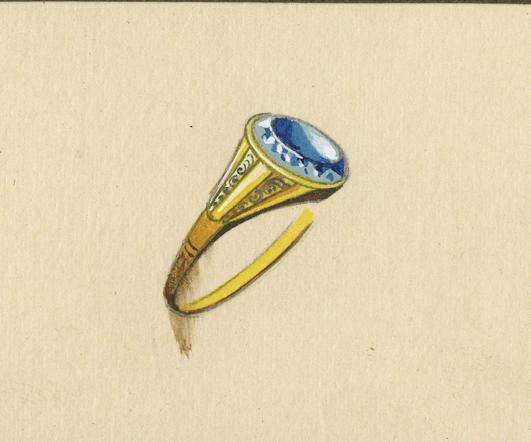
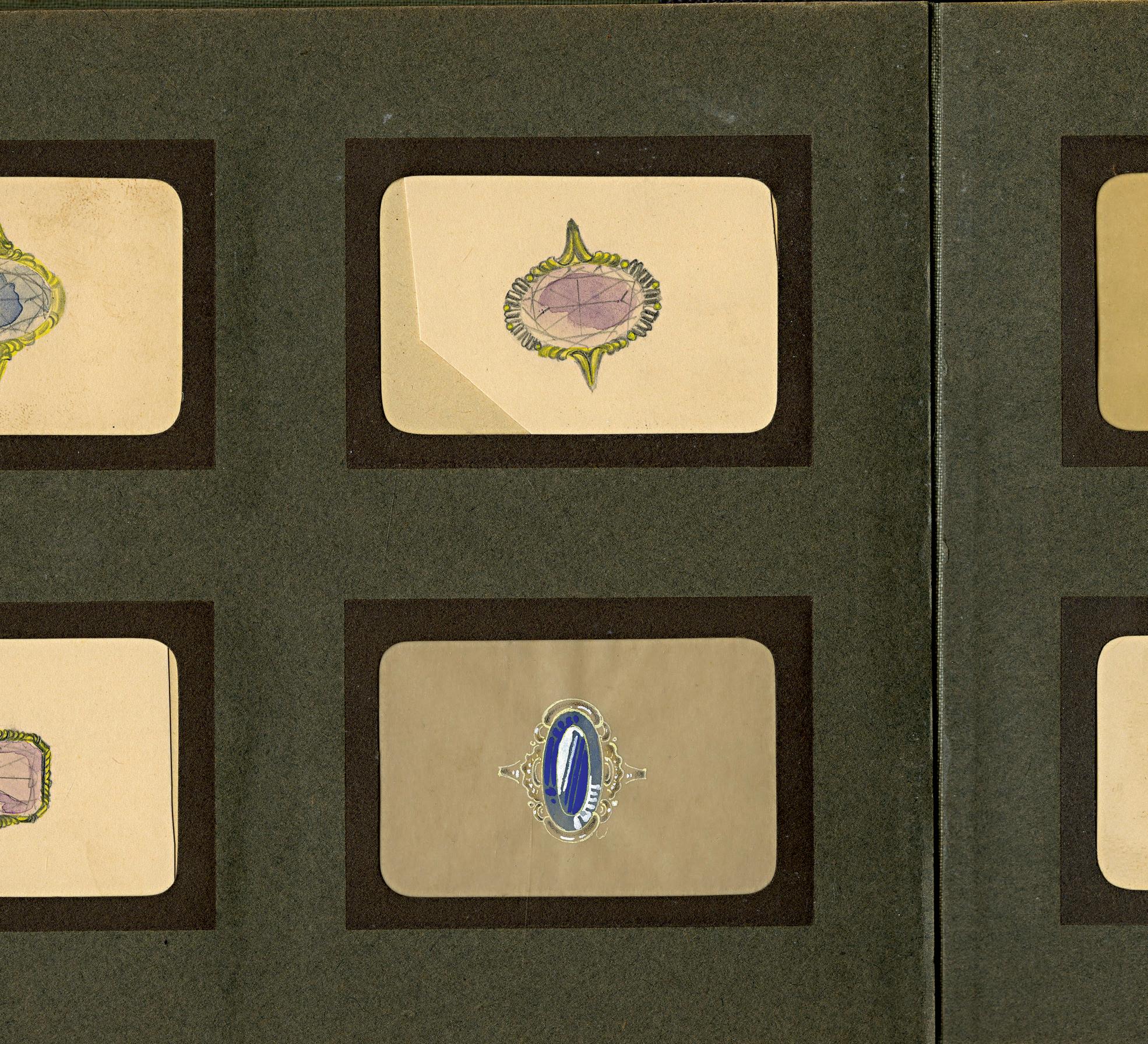
Sketches for gem-set rings
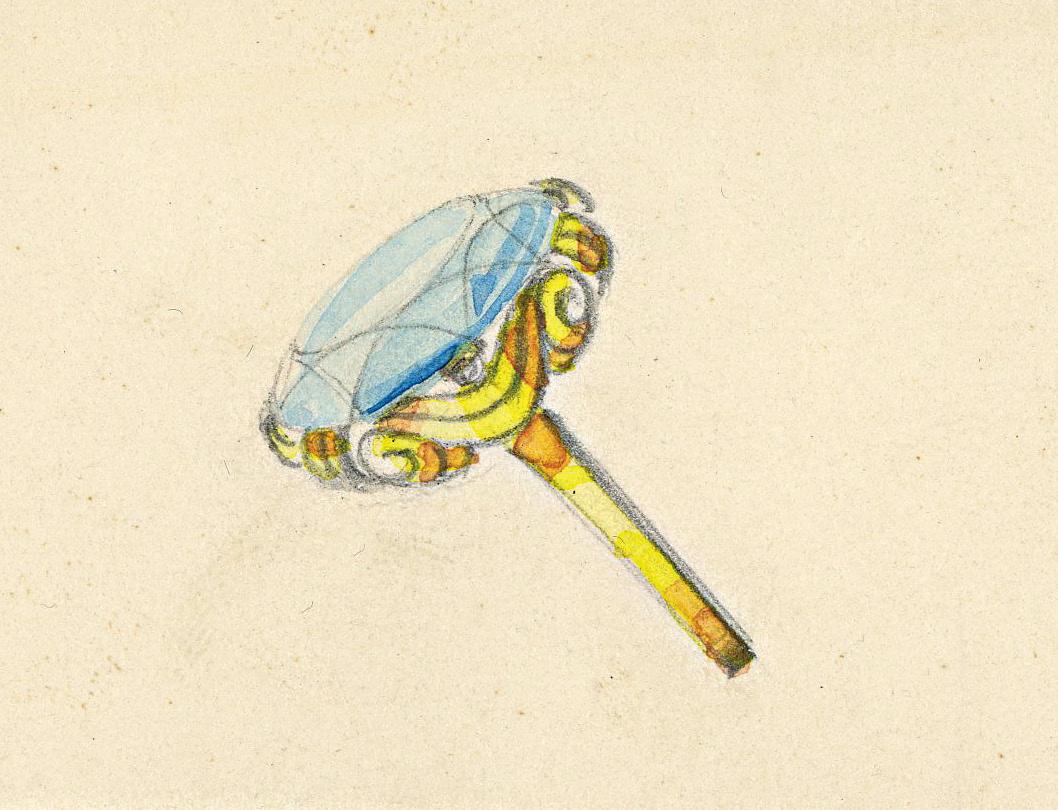
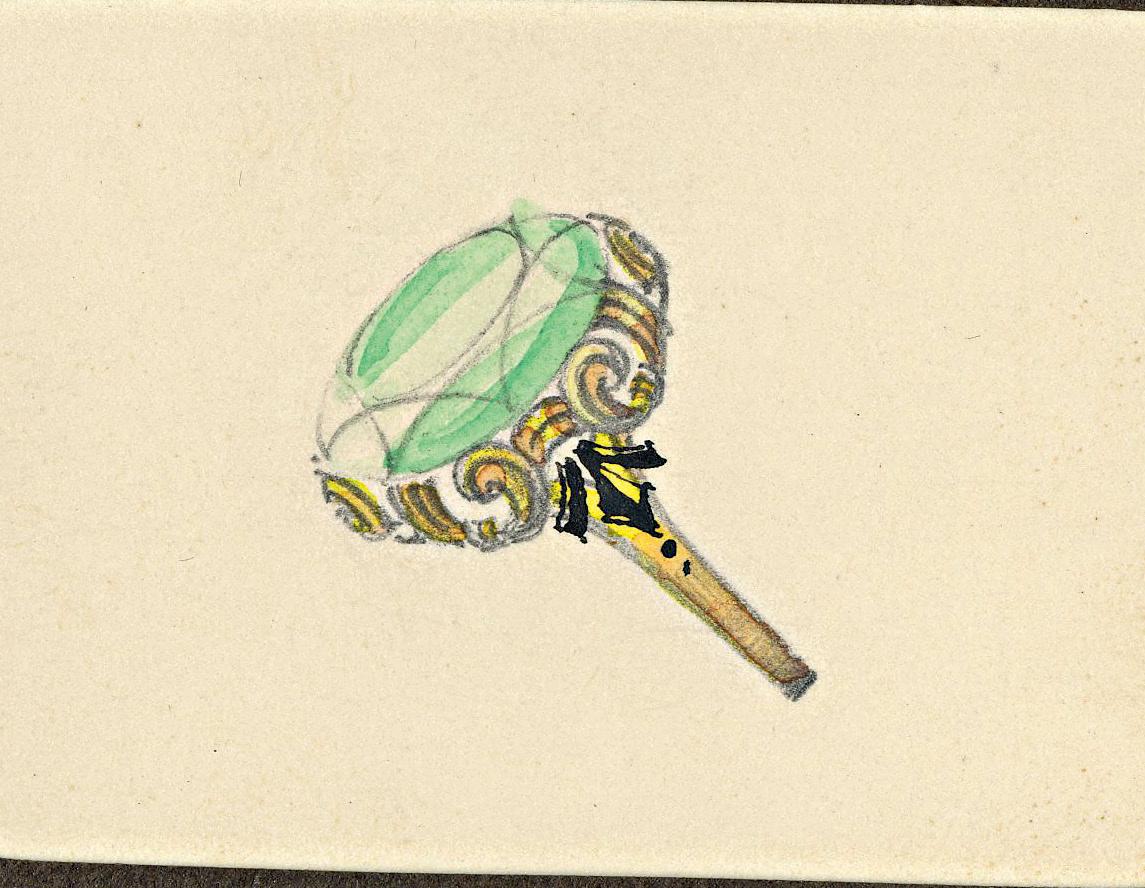

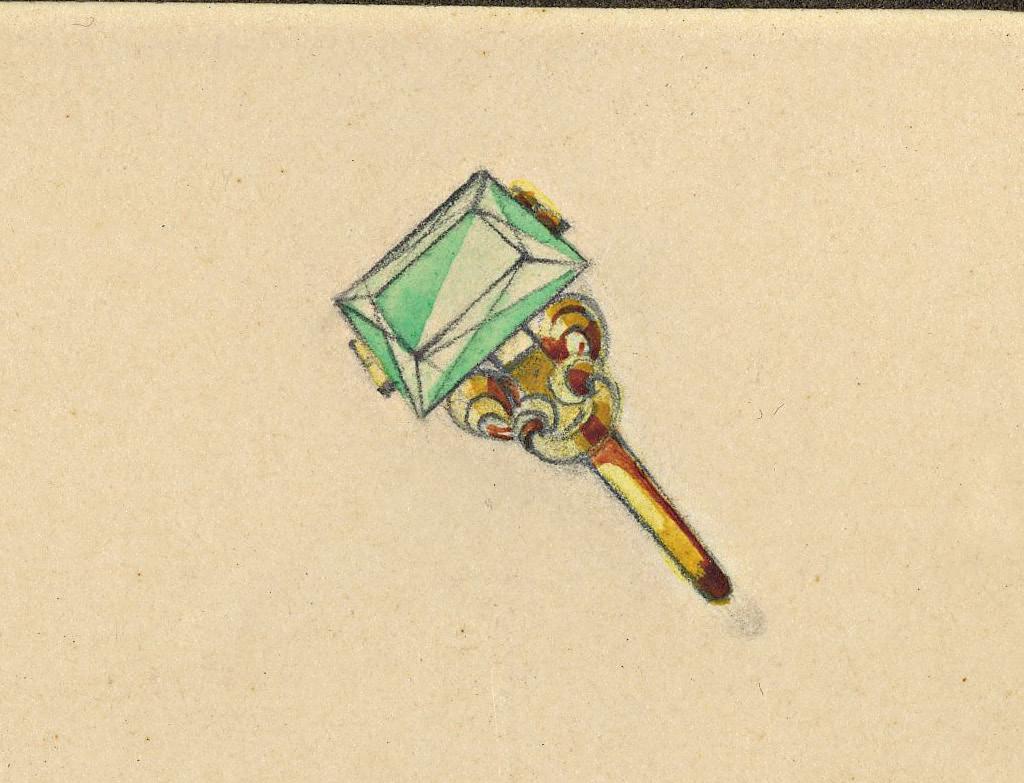
Sketches for gem-set rings
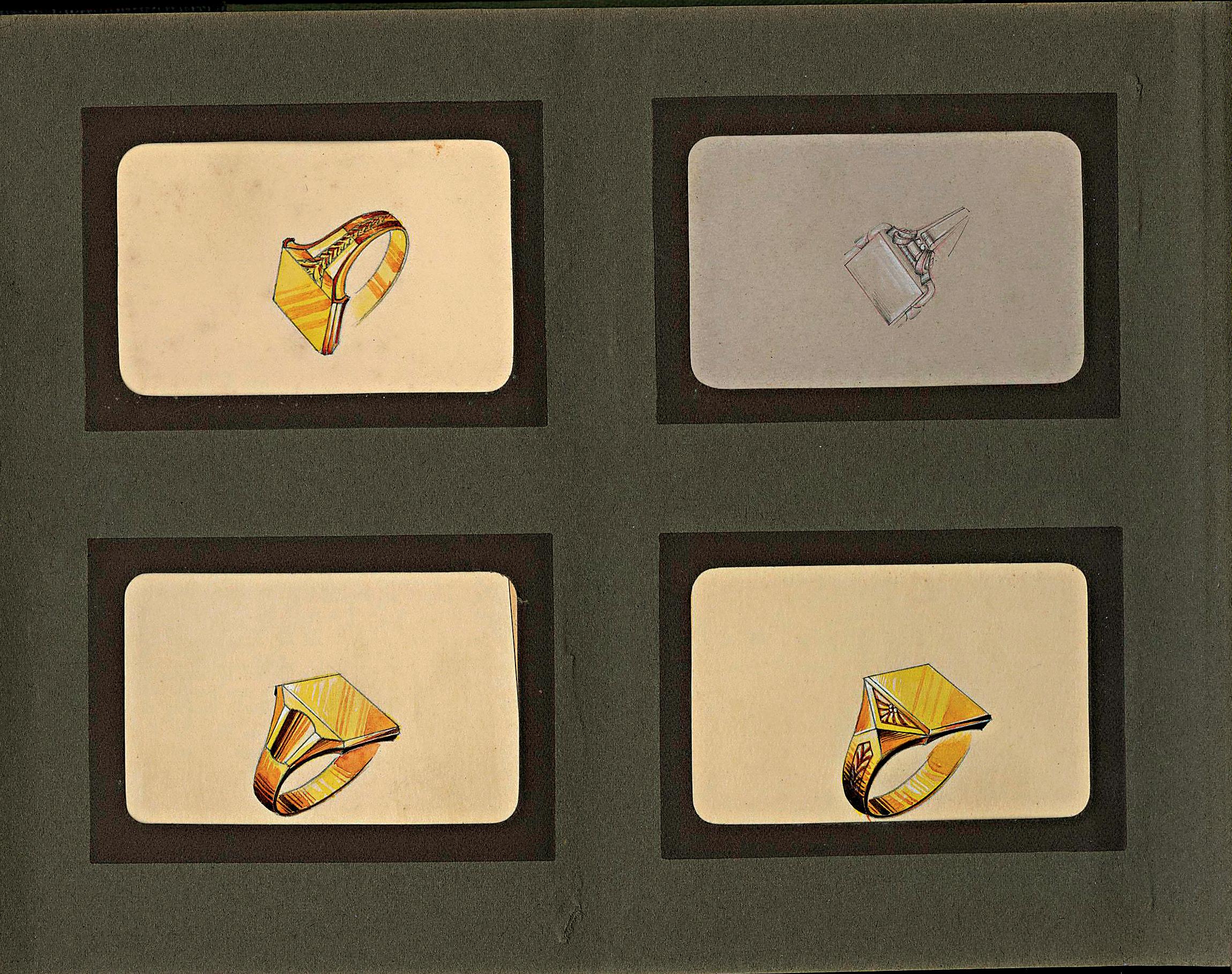
Sketches for plain gold signet rings
Probably France, late 1920s-1930s
The success of the Paris Exposition des Arts Décoratifs in 1925 cemented the embrace of Modernist styles by Parisian jewelers. Their use of geometric forms and unconventional color combinations reflected the influence of Modernist art movements, especially Cubism, of contemporary interest in “exotic“ cultures, and of the daring aesthetic of the Ballets Russes. For fashionable clients, the 1920s was a time to embrace luxury and excess, and the worldwide economic depression brought about by the 1929 Wall Street Crash did not immediately affect the demand for luxury jewelry. Georges Fouquet, from the renowned Parisian dynasty of jewelers, commented in 1942 that if the theme of the 1925 exhibition was color, then the 1929 exhibition at the Palais Galliera proved to be white, dominated by white gold, platinum, and white diamonds. As the 1930s progressed, the use of yellow gold and less expensive colorful stones become fashionable again as dress and jewelry became more overtly feminine.
With few exceptions the 22 drawings in this collection reflect the fashion for white jewelry in the 1930s and the preference for three-dimensional forms. Diamonds dominate the designs, mainly pavé-set, in a variety of sizes and cuts (such as brilliant-, navette,- and baguette-cuts) in dense arrangements creating linear, interlaced, or fan-shaped outlines. The jewels would have been made in white gold or platinum to create almost invisible settings and emphasize the sparkle of the diamonds. The emeralds featured in some of the drawings appear to be used more to highlight the diamonds than to emphasize color. The move towards yellow gold and more naturalistic design is represented here in the bow-shaped necklace and floral spray where the use of diamonds is sparse.
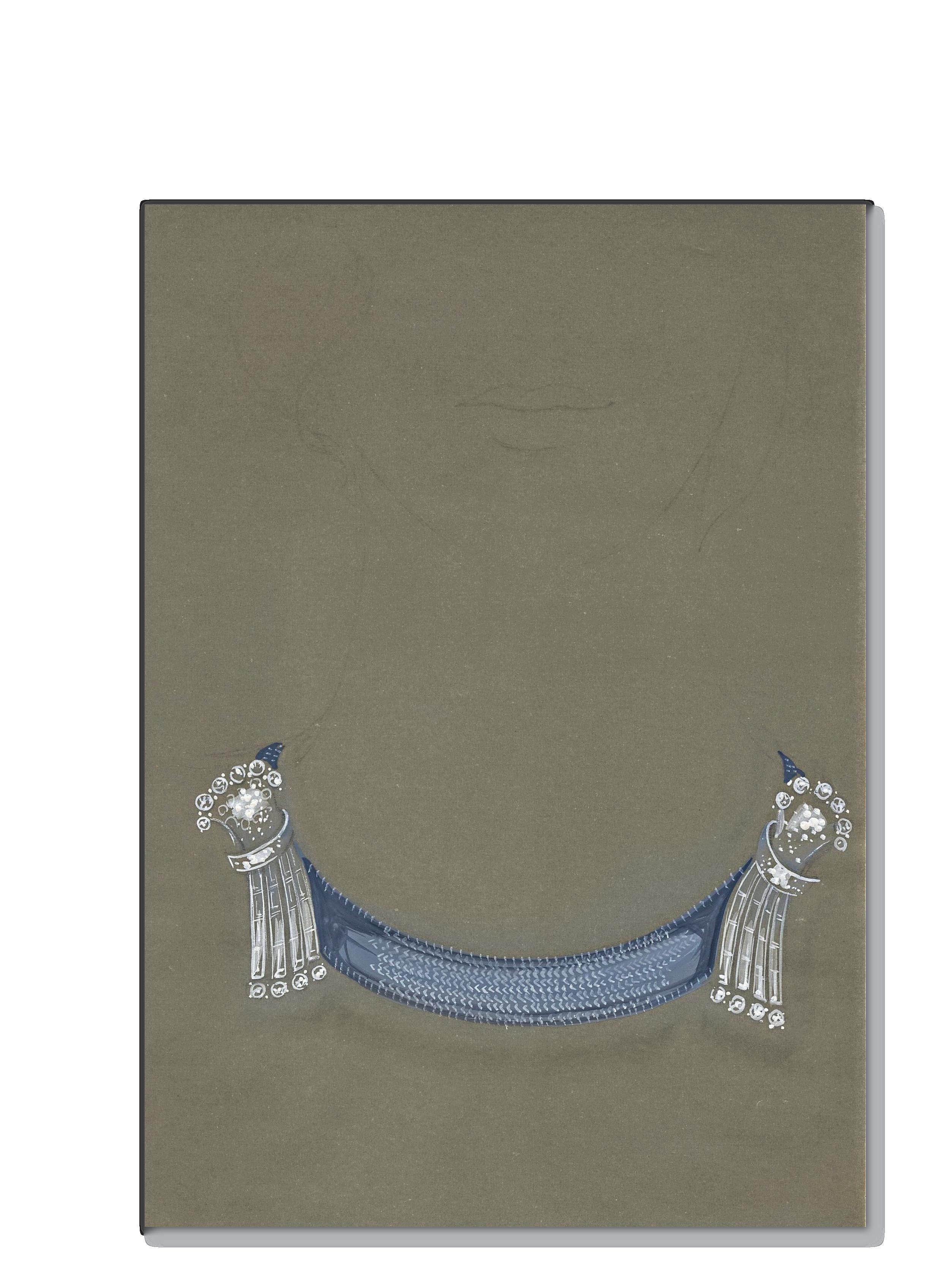
Drawing for necklace with blue-colored gemstone beads and diamond-set festoons
22 graphite pencil and gouache drawings on slightly different types and colors of tracing paper. Two of them stapled to a gray cardboard backing. The tracing paper sheets vary in size, ranging from c. 210 x 160 mm to 230 x 180 mm. Excellent condition. Includes 11 necklaces, 9 bracelets, one earring, and a brooch.
Box: Half leather, with cardboard sides, archive box labelled in French “projets bijoux.” Dimensions 250 x 200 mm.
The 22 drawings are executed with the utmost care. Two gouaches featuring bracelets on a cardboard backing appear to be made to present to clients, showing advanced finishing touches, cast shadows, white, gray, and green highlights. These are numbered in pencil: 1 at the top right corner is numbered '46' at the bottom, and '2' at the top right corner is numbered '43' at the bottom. Three gouache drawings display a rather advanced level of completion and respectively a brooch, an earring, or a necklace all with colored highlights. Occasionally, the body parts on which the jewel is supposed to be worn are also drawn. Other sketches are organized by series and show variations of the same piece: three gouaches for a necklace design, two series of two gouaches for a bracelet, three pencil sketches (executed using a geometric instrument) for a bracelet, and seven pencil sketches for a necklace. These series range from a relatively advanced to a moderate stage of completion, and sometimes pencil marks are visible. The sketches are predominantly for diamond jewelry, made over a longer period of time and appear to be by the hand of one jeweler.
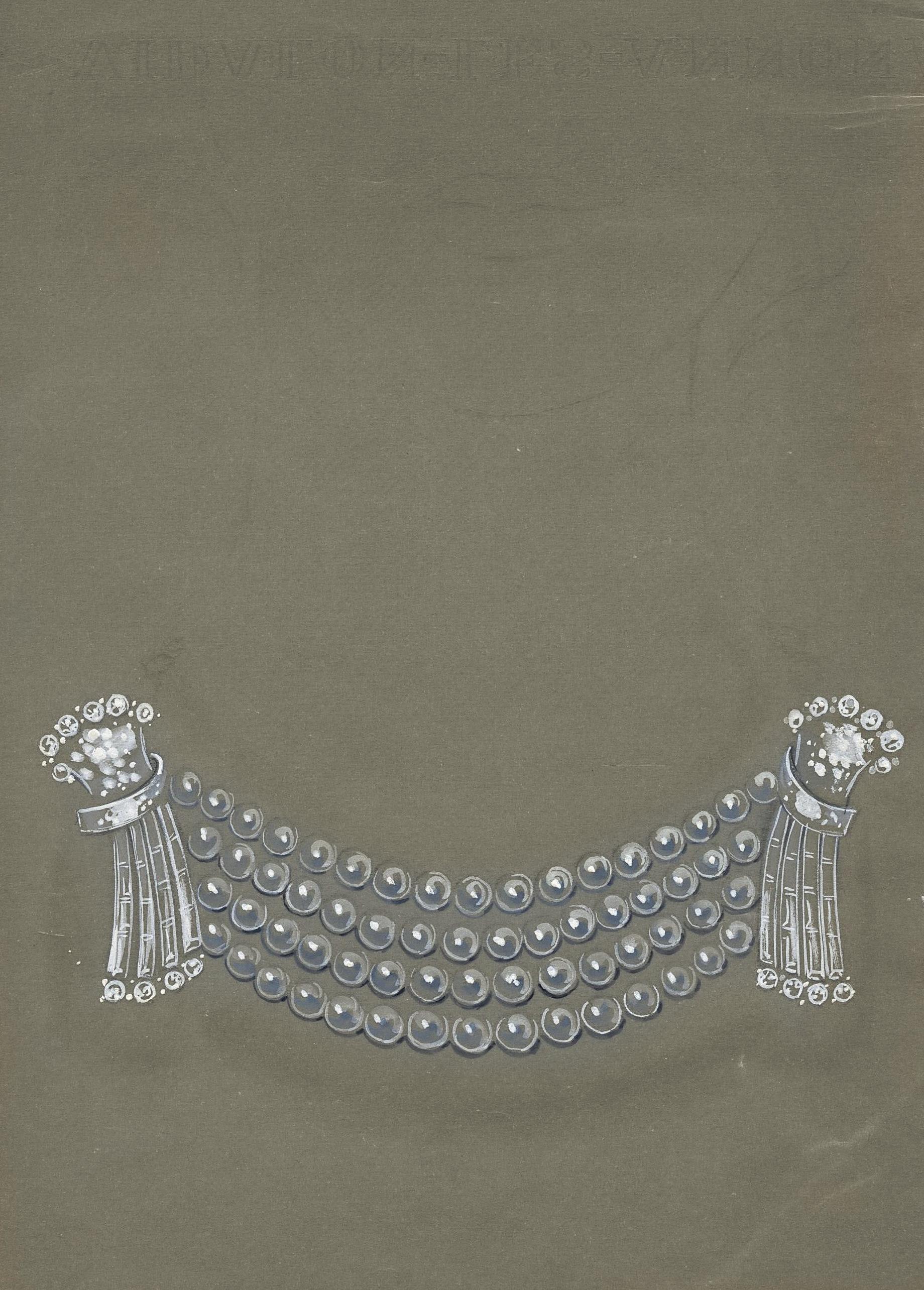
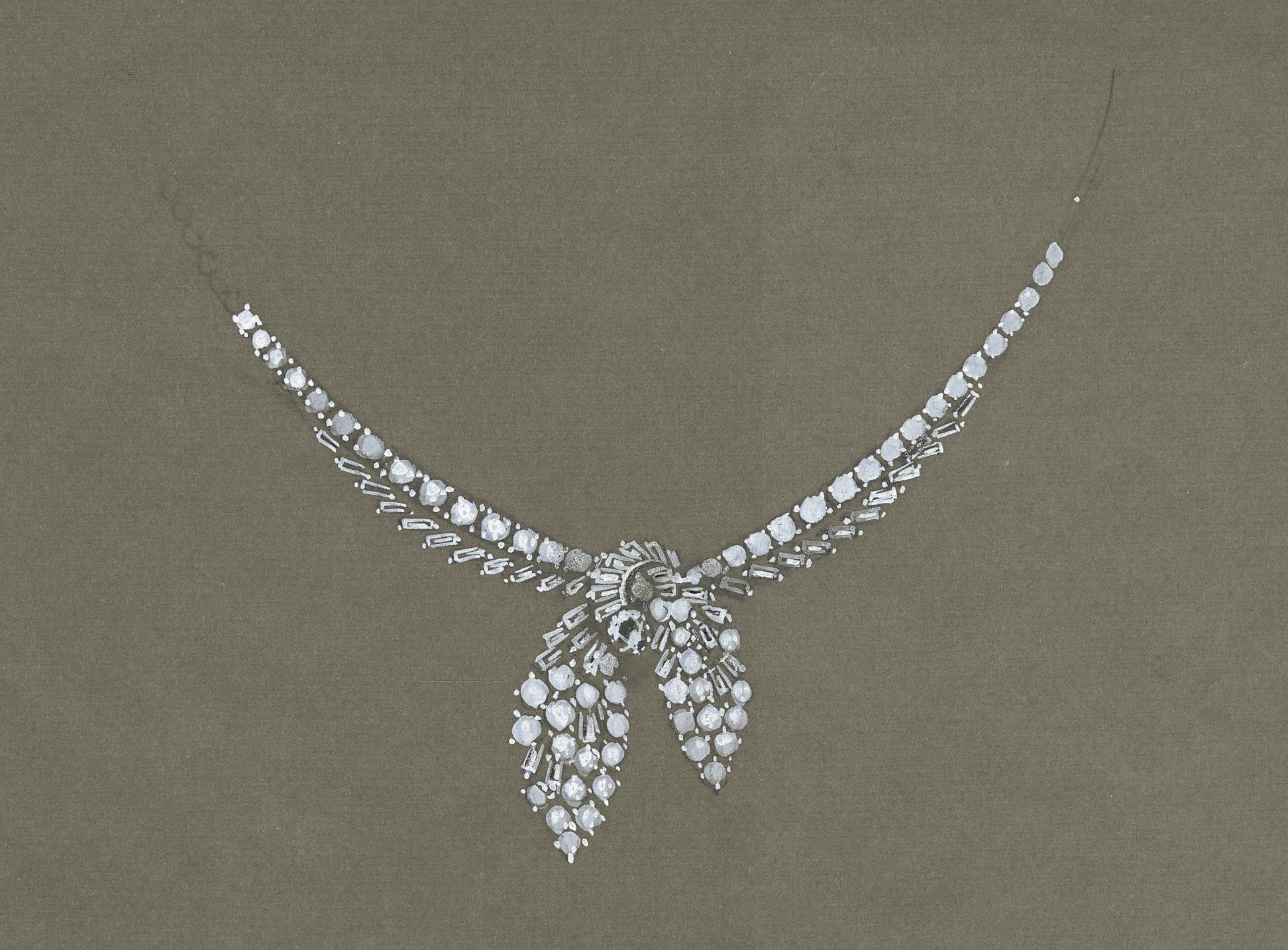
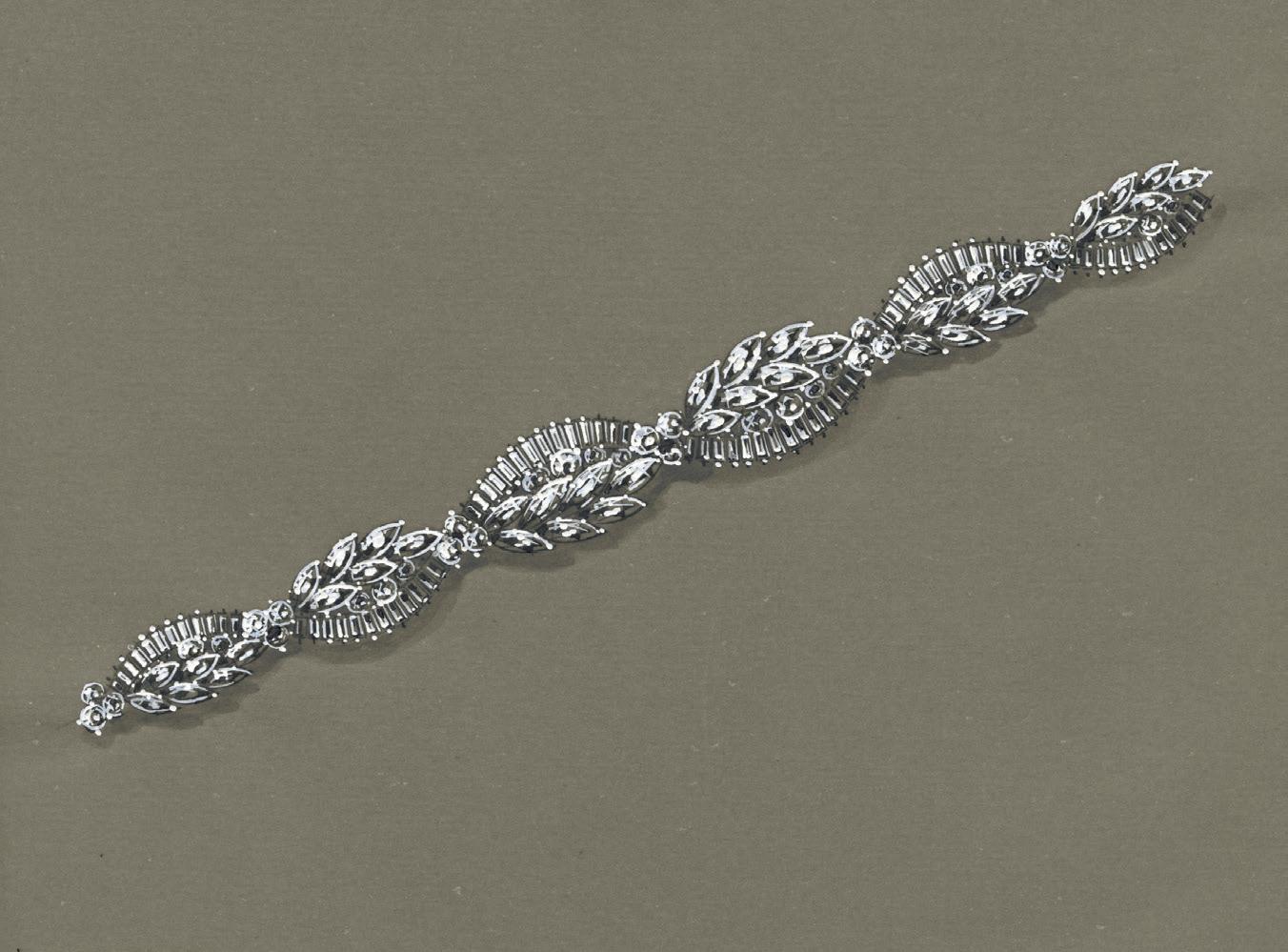
Drawings for diamond-set necklace and bracelet
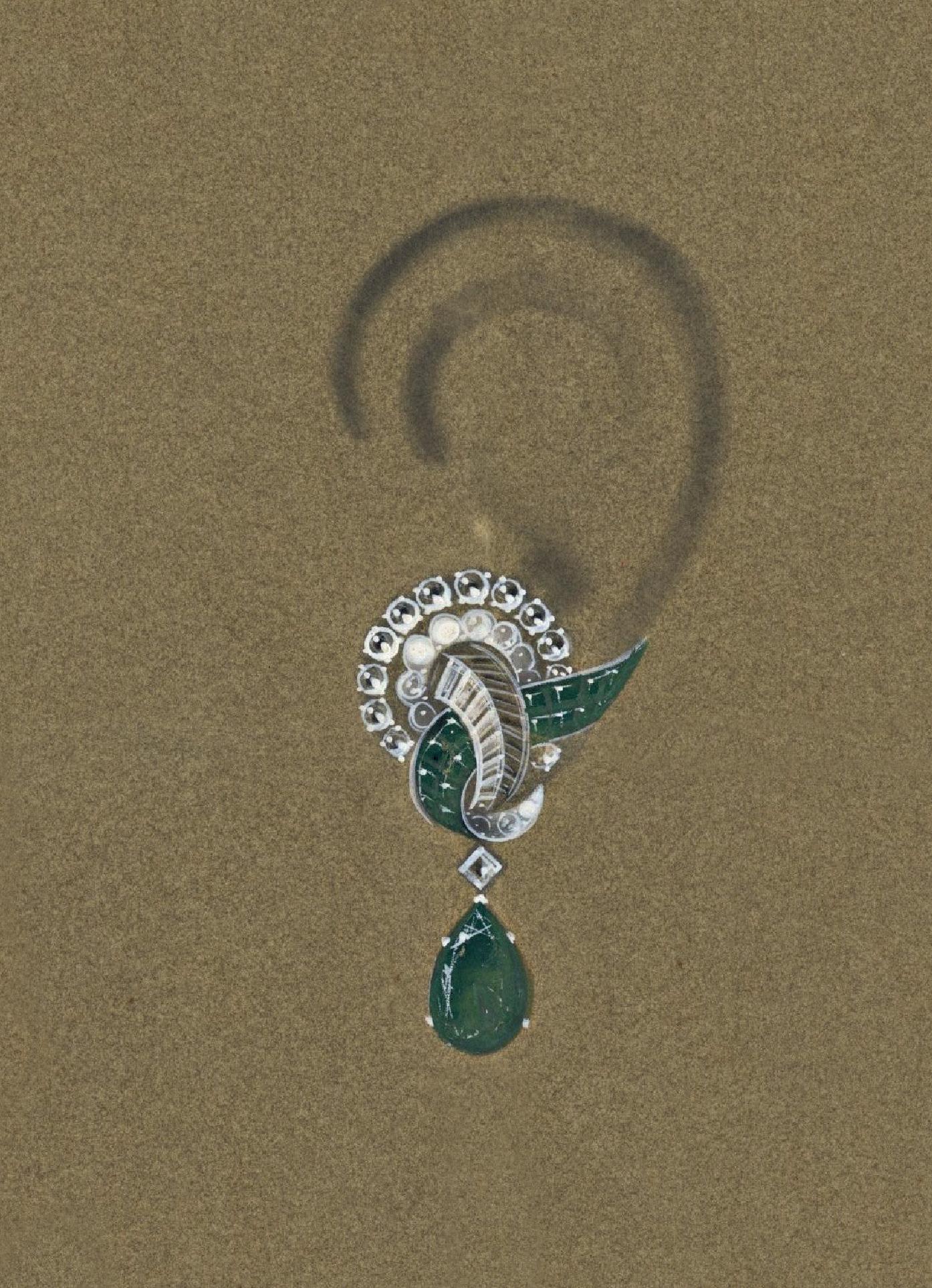
Drawing for a diamond and emerald earring
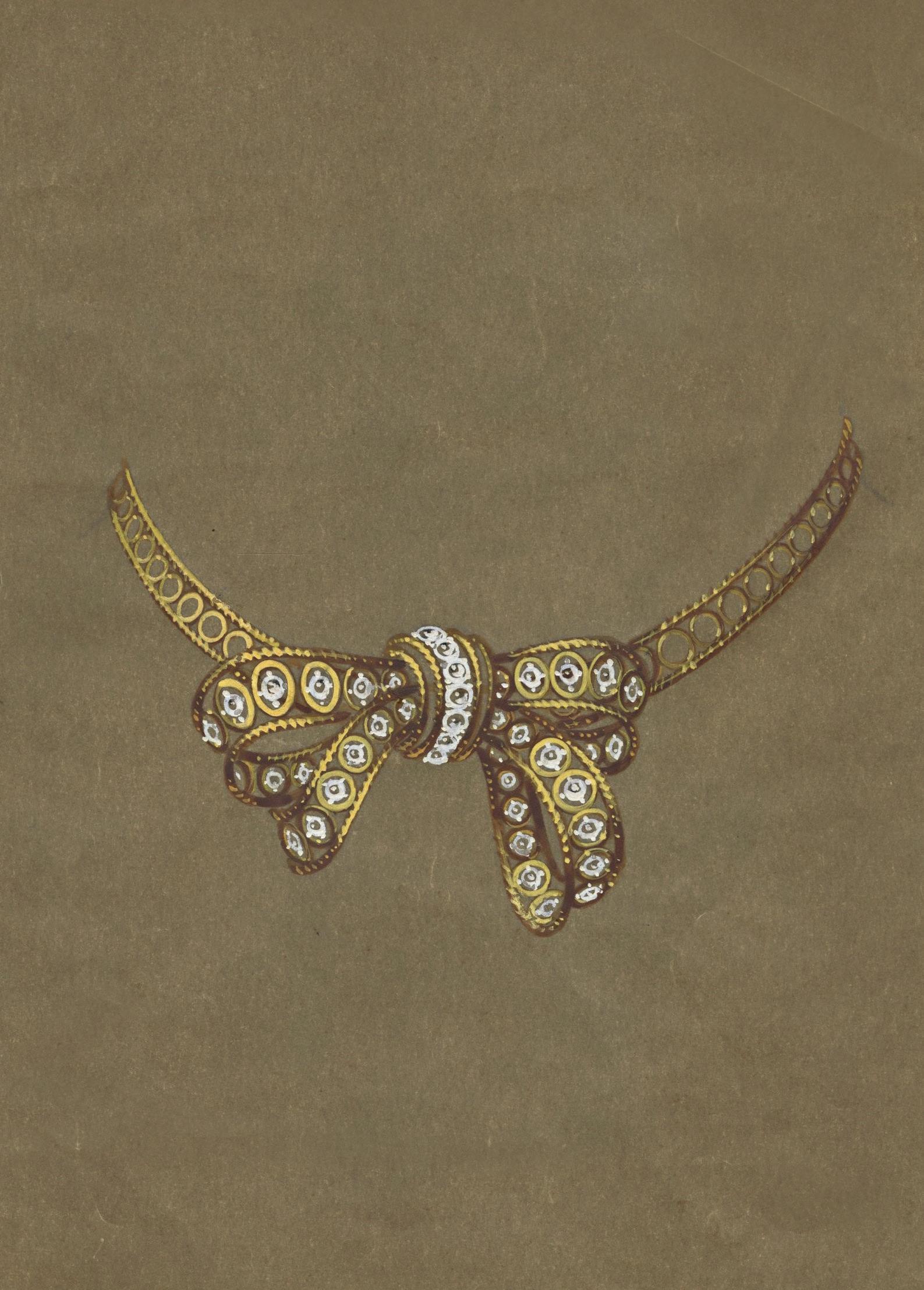
Drawing for necklace in yellow gold filigree work and diamond-set bow as centrepiece
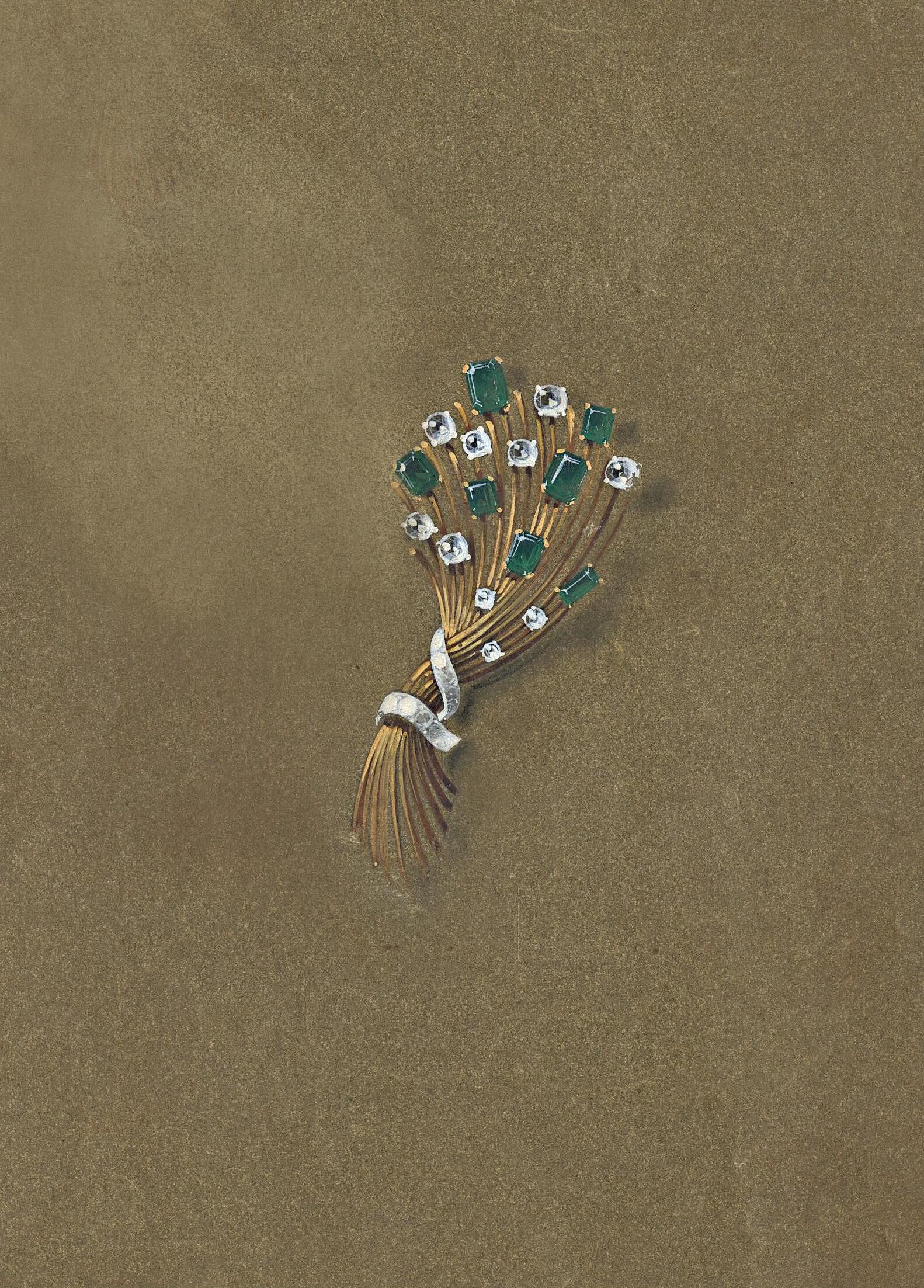
By Jules Fonteyne (1878-1964)
Belgium (Bruges), c. 1920s-early 1930s
Born into an artistic family in Bruges in 1878, Jules Fonteyne studied art and sculpture at the city’s Stedelijke Academie voor Schone Kunsten, followed by further studies in Brussels and Antwerp. Returning to Bruges he immersed himself in the city’s artistic community, joining the art society Kunstgenegen (1894-1914), consisting of a group of pupils, former pupils, and teachers of the Academie, which held annual exhibitions. He started teaching in 1921 and was appointed Director of the Academie in 1927, where he remained until his retirement in 1947. A painter and etcher of Bruges cityscapes, portraits, and scenes of everyday life, Fonteyne was also a prolific graphic artist and book illustrator, designing posters, postcards, and bookplates. He also designed decorative arts, such as stained glass and furniture for churches and monasteries in West Flanders rebuilt after the First World War.
This album of sketches, perhaps dating from the 1920s or early 1930s, unusually includes designs for metalwork vessels and jewelry, whose style echoes the crisp, sinuous lines of his woodcuts from that period. The jewelry reflects a range of influences: the linear naturalism of Japanese art, Egyptian scarabs popular after the 1922 discovery of the tomb of Tutankhamun, ancient Roman jewels, and Dutch silver design of the Amsterdam School in the 1920s and 1930s. There are several pages of designs for hanging pendants featuring motifs from the natural world — beetles, fish, birds, even a lizard and frog — as well as graceful dancing girls, all accented by pearls and cabochon gemstones in various colors. Fonteyne’s work was exhibited internationally during his lifetime and was the focus of a retrospective exhibition at the Groeningemuseum in Bruges in 1973.
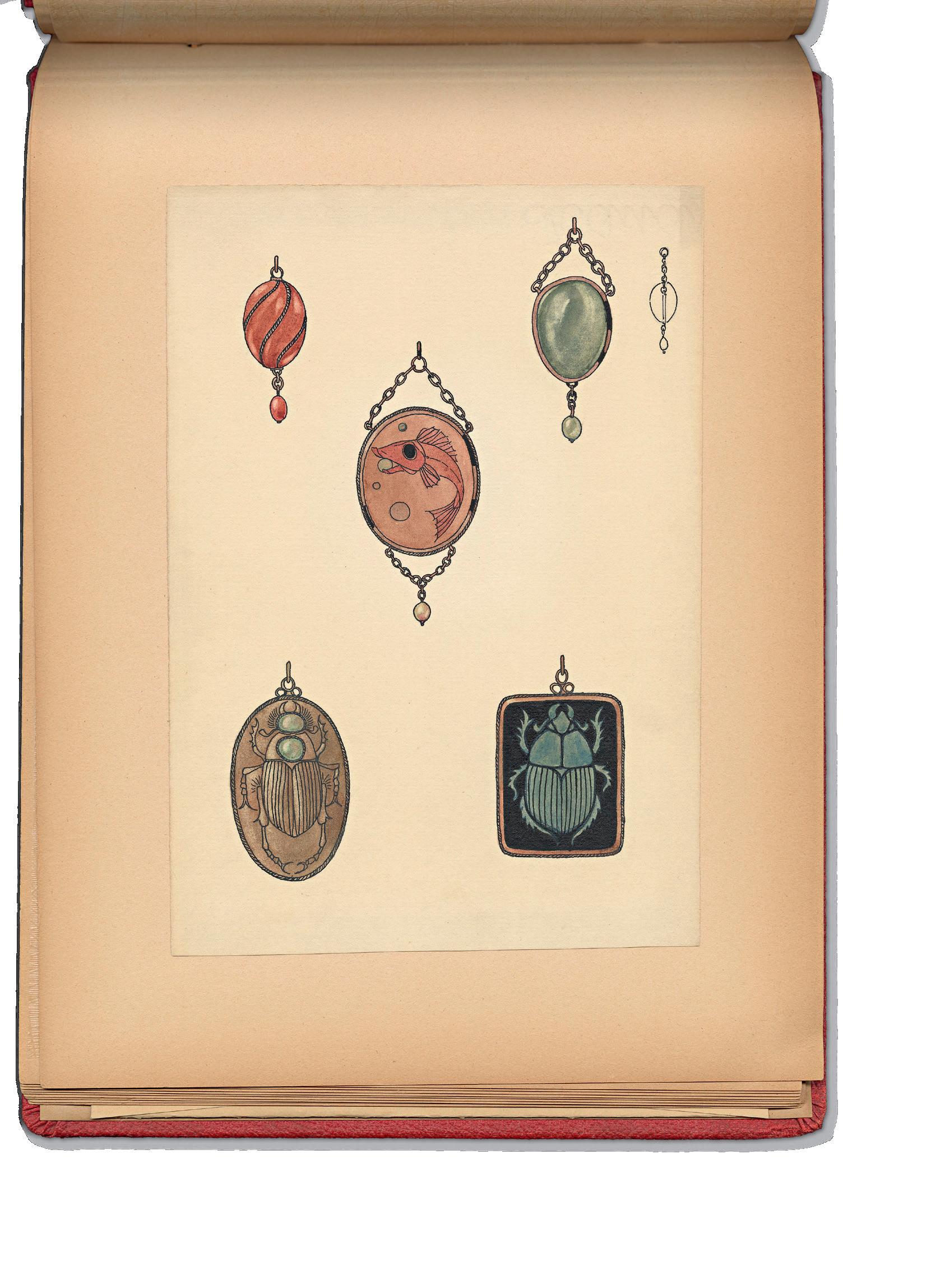
Ensemble of 15 cuttings mounted on larger sheets of brown paper, 14 sheets both glued on a photo album. 5 additional drawings on loose sheets. Sheets show one or more sketches in watercolors, ink, graphite, pencil on various types of paper. The majority of these designs are intended for jewelry, particularly pendants, as well as small decorative objects such as spoons and cups. The first three sheets have moisture stains, the others mostly clean. The drawings vary in size, sheets from 145 x 210 mm to 190 x 255 mm.
Album: The album itself is made of 22 folios, with tissue-guards, side-stitched, yellow cord. Bound in red percaline, hot-stamped, two geese in flight motif. Wear marks on the spine; in very good condition. Dimensions 222 x 315 mm. Included two envelopes on the back cover with two typed letters to Fonteyne and newspaper cuttings about the artist.
This set of designs, executed with varying degrees of finishing, ranging from simple sketches to tracing drawings, and to detailed, inked, and watercolorpainted designs, all made by Jules Fonteyne. The jewelry designs, mostly pendants, draw their inspiration primarily from animal motifs, mainly toads, lizards, fish, or scarabs. They also feature botanical patterns and female nudes. Many designs suggest the use of gemstones and openwork. Twisted wires are sometimes used for the outlines and hooks. These sketches attest to Jules Fonteyne's exquisite drawing ability.
Bibliography: exh. cat. Retrospectieve tentoonstelling Jules Fonteyne 1973.

Sketches for pendants with fish motifs
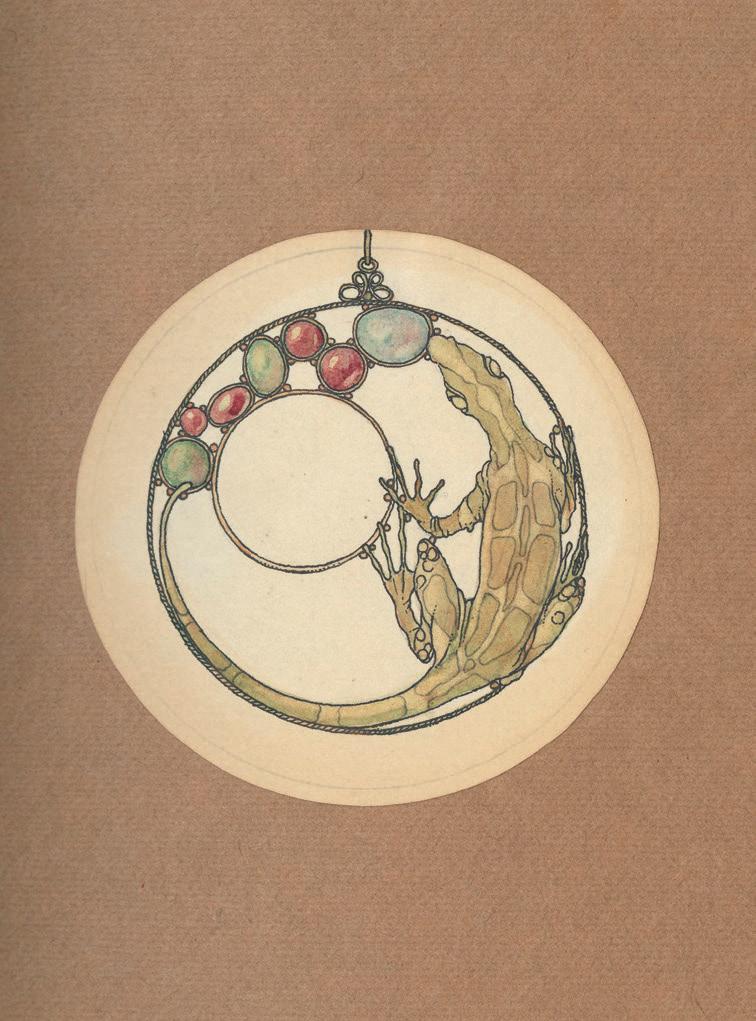
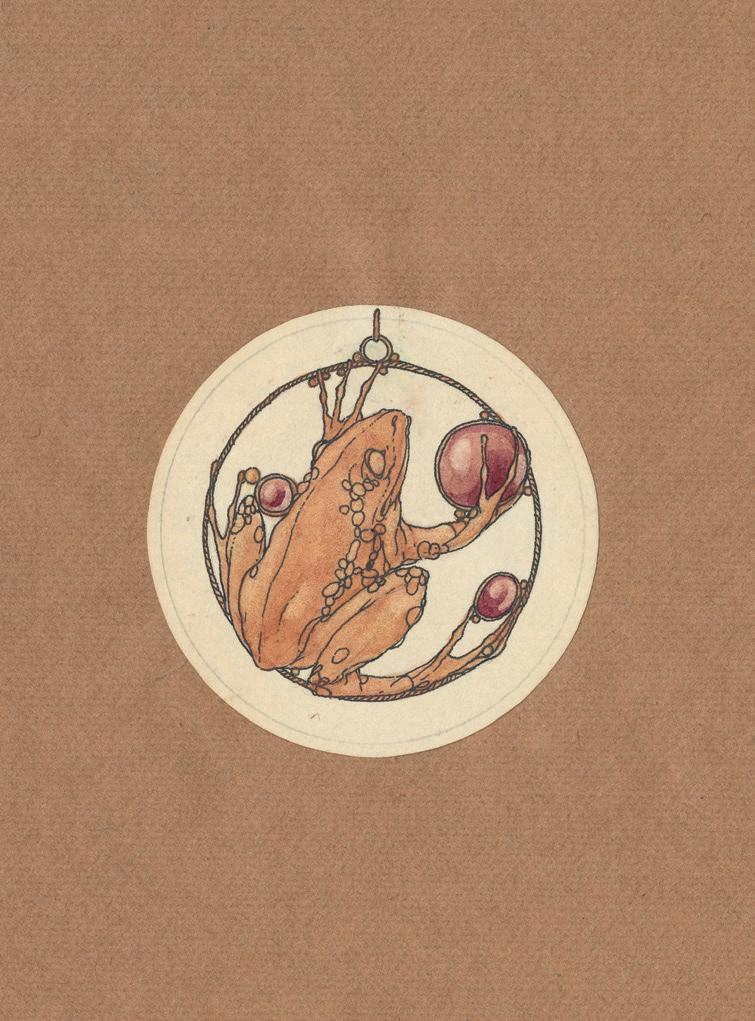
Sketches for pendants with lizard and frog
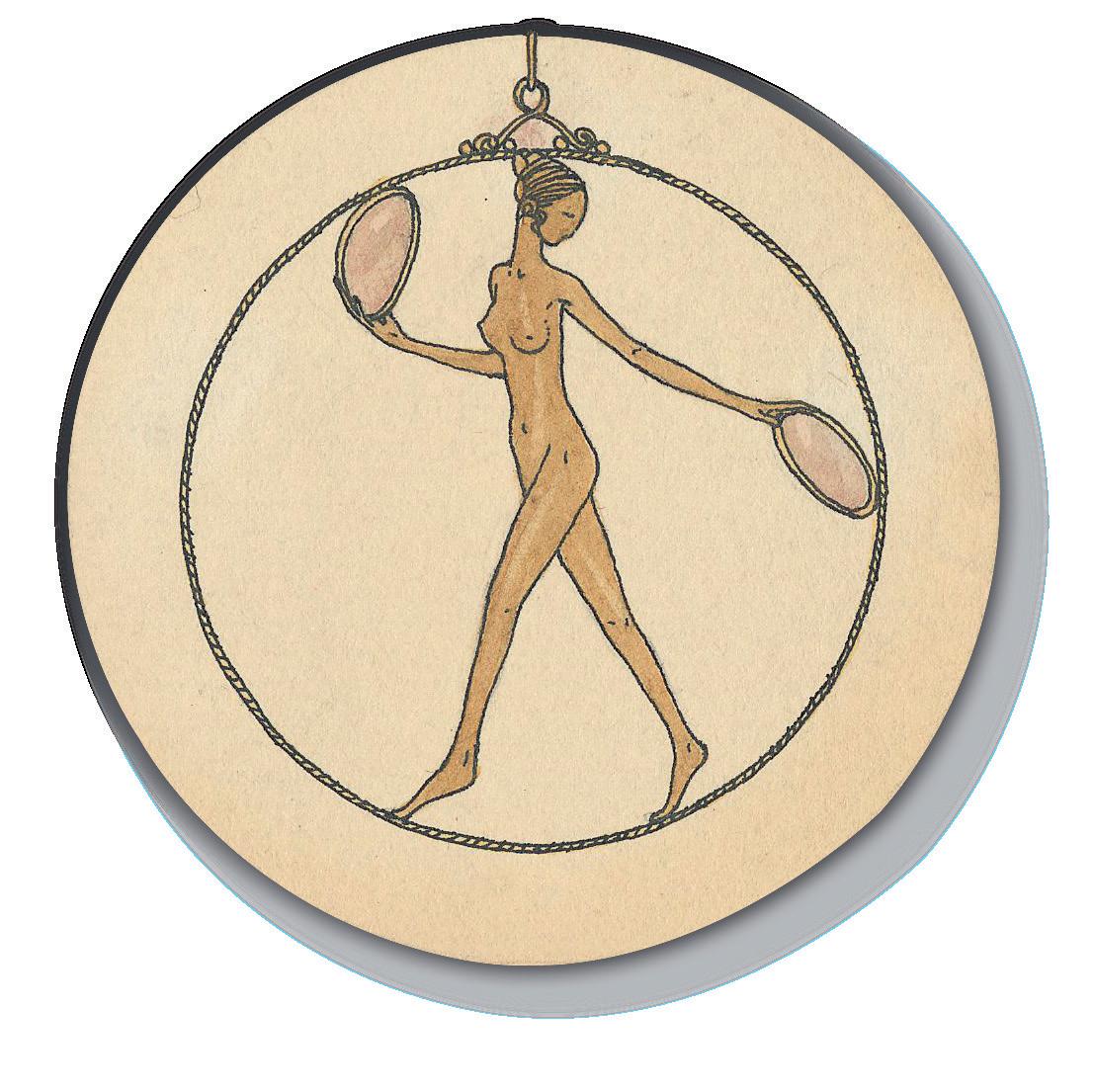

Sketches for pendants with graceful female figures
Probably France, late 1940s -1950s
By the late 1940s and 1950s, luxury fashions and jewelry were enjoying a revival as the post-war economy began to recover. Paris continued to lead style trends, especially after 1947 when fashion designer Christian Dior launched his revolutionary Spring collection named “The New Look.“ His designs caused a sensation, emphasizing femininity and glamour with a lavish use of fabrics to create opulent full skirts, quite a contrast from the more utilitarian wartime fashions. Inspired by this exciting change in dress styles, high-end jewelry houses in Paris such as Van Cleef & Arpels, Pierre Sterlé, Mauboussin, Mellerio, and Cartier, devised extravagant and fun-loving jewels to meet women’s renewed desire for luxury. Precious metals such as white gold and platinum were more readily available alongside yellow gold, and the trade in gemstones flourished.
This collection of 38 designs for elaborate jewels reflects the new taste of the period, drawing on optimistic, life-affirming, even frivolous themes. The designer uses round and twisted wires to create voluminous three-dimensional forms, including ribbons, bows, and stylized floral sprays featuring an array of colored stones with a preference for rubies, sapphires, and emeralds. The designs encompass sumptuous diamond swirls and cascading stone-studded creations as well as light-hearted compositions of birds and butterflies, fruits and floral bouquets. They also reveal a playful use of gemstones: a ship riding over waves of sapphires and diamonds, or a log fire aflame with rubies and diamonds, both indicating the use of red gold.

38 drawings, pencil, graphite, and gouache on tracing paper of different colors (two leaves with Canson & Montgolfier watermark). The drawings depict mainly brooches; some may be designs for clasps and rings. Pencil annotations in French. Two leaves are mounted on a black cardboard backing. Most of them have a gouache white frame. Sizes vary from 105 x 90 mm to 276 x 188 mm. In excellent condition.
Box: Modern half-cloth clamshell box, with marbled paper sides. Dimensions 330 x 235 mm.
Collection of detailed drawings, with extensive use of color to indicate the suggested gemstone. Some examples show variants of the same jewel (in one instance even with pencil annotation "refait" at the corner of the fireplaceshaped brooch) or a choice between two options provided to the client, with a more or less extensive selection of stones. Very few annotations in pencil, mostly numerical, in one case about material “7 a 8 perles de 4ème a 6” probably indicating that the jewels were intended to be produced. Four largersized sheets (276 x 188 mm) with two sketches of the same jewel: one detailed and gouache-enhanced, and a second one with very precise white outlines. All drawings likely executed by the same hand.
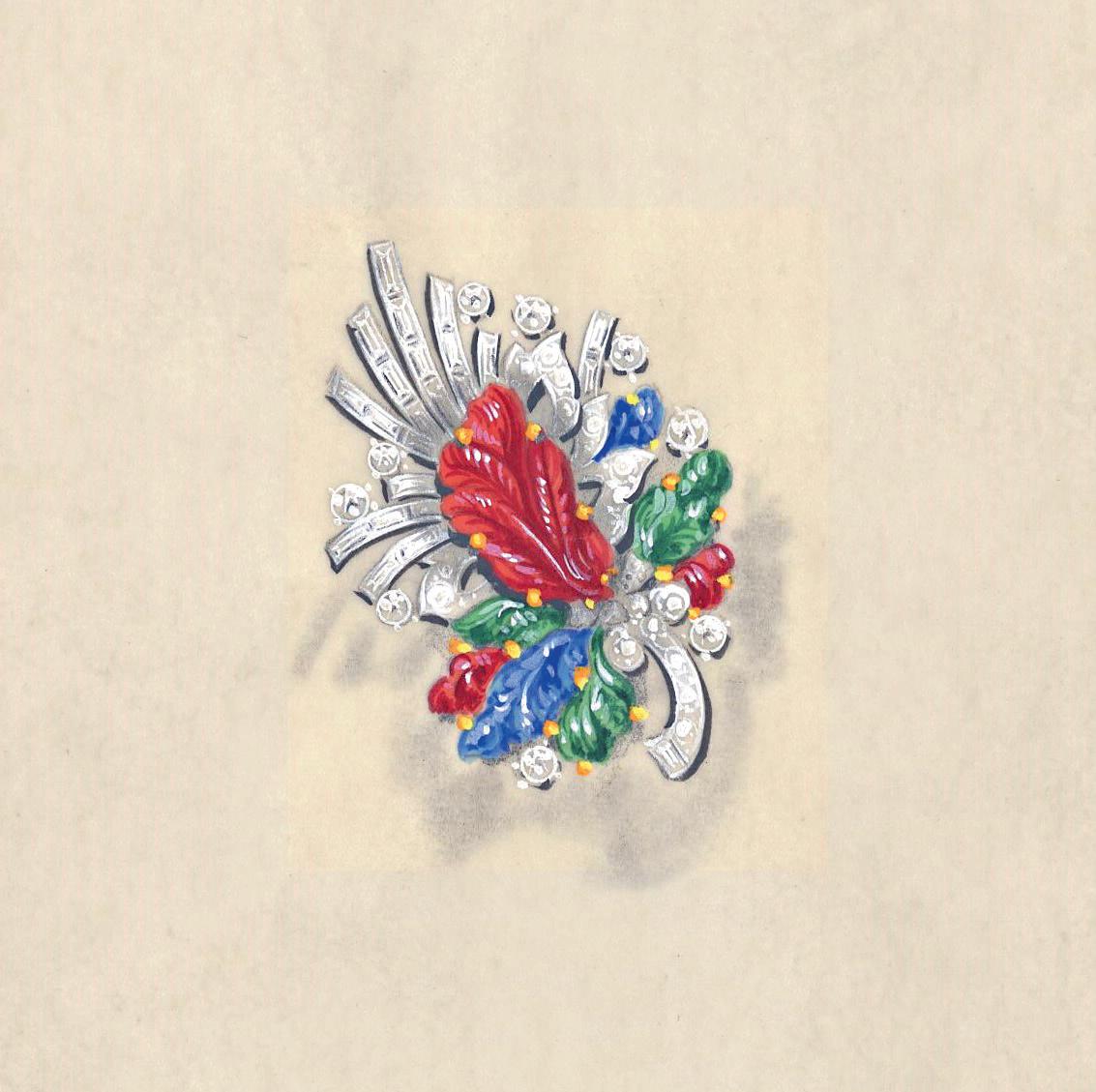
Drawing for a brooch in the “ tutti
style with carved rubies, emeralds and sapphires
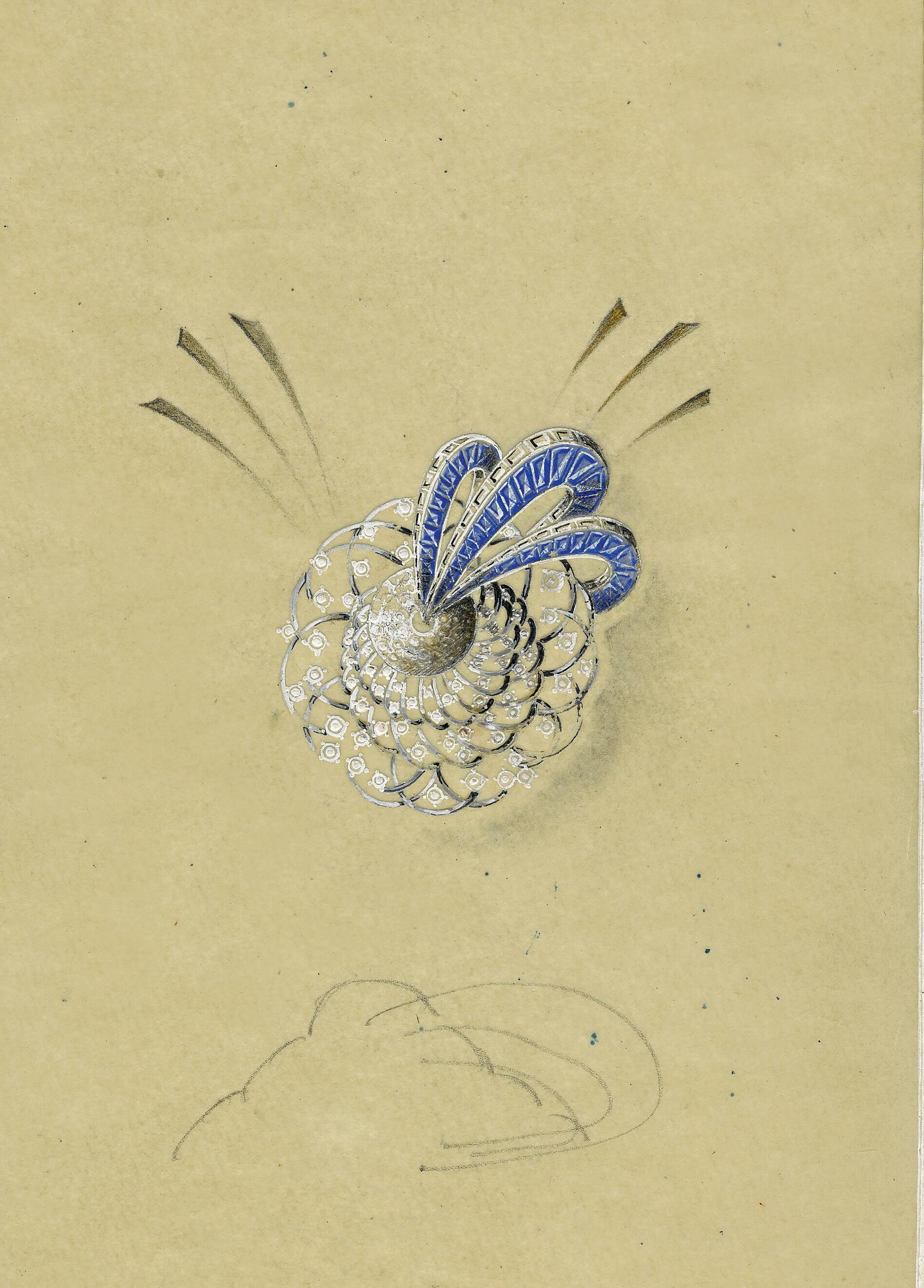
Drawing for a diamond and sapphire floral-like jewel
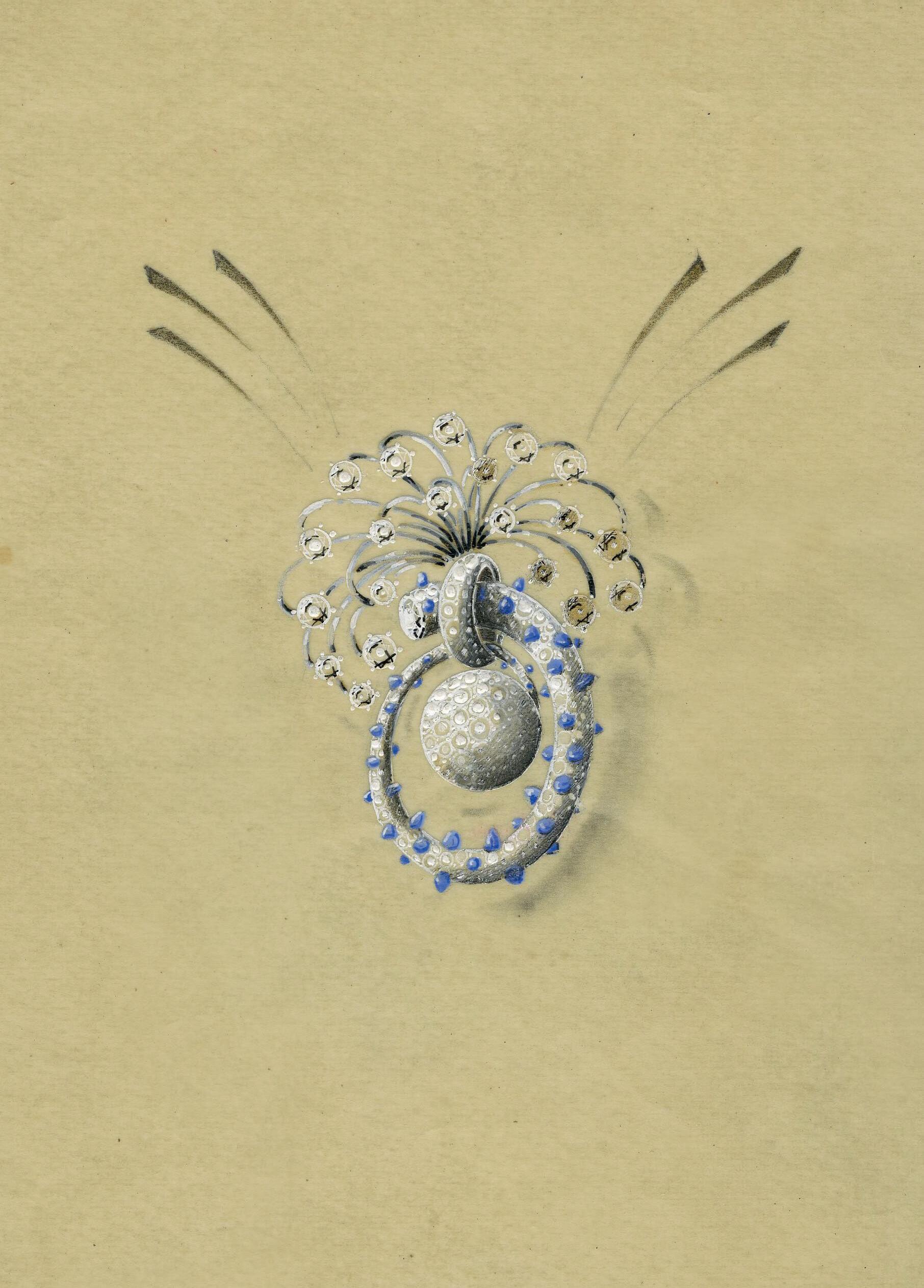
Drawing for a diamond and sapphire jewel
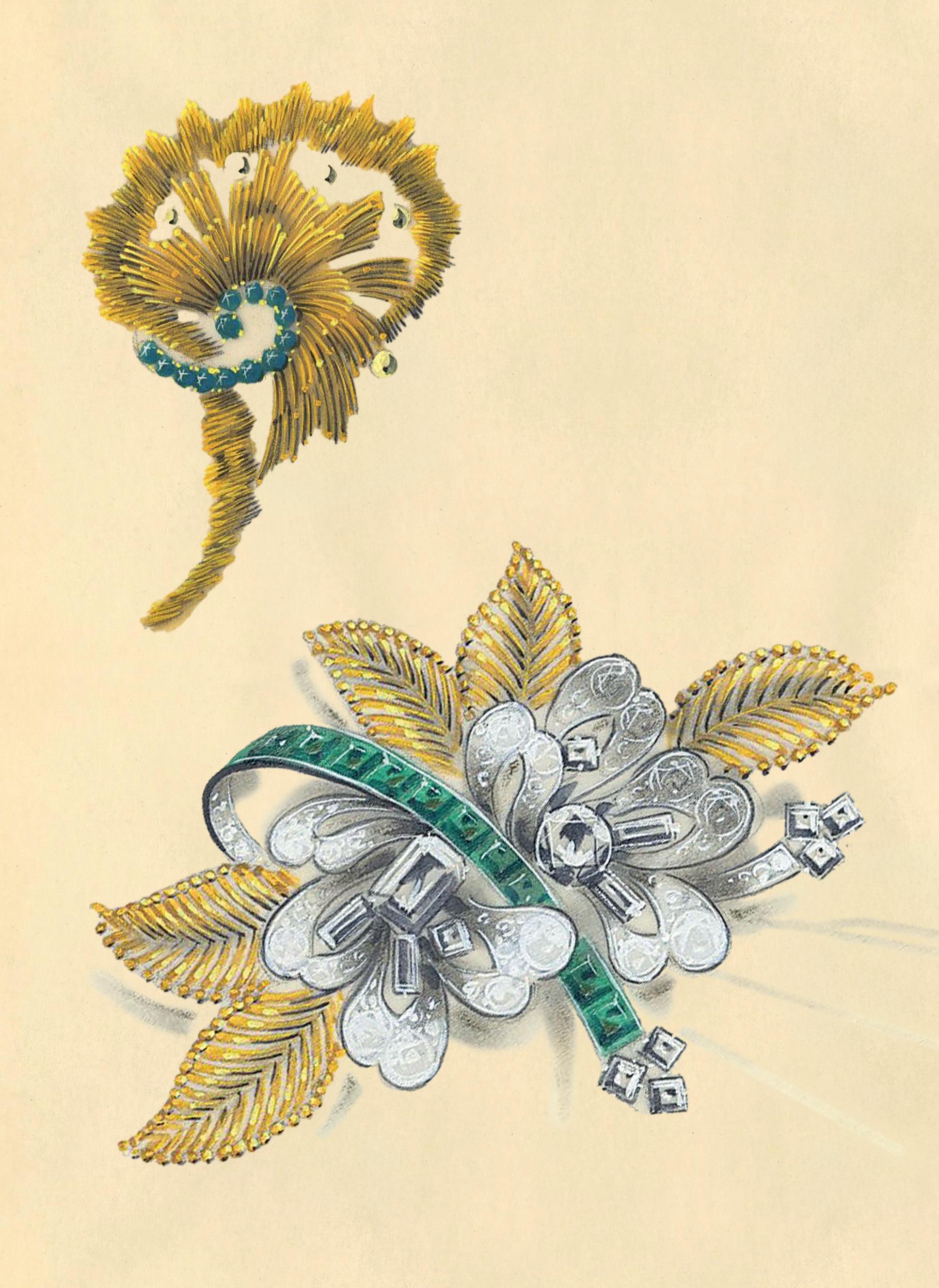
Two drawings for yellow gold brooches inspired by nature with emeralds and diamonds
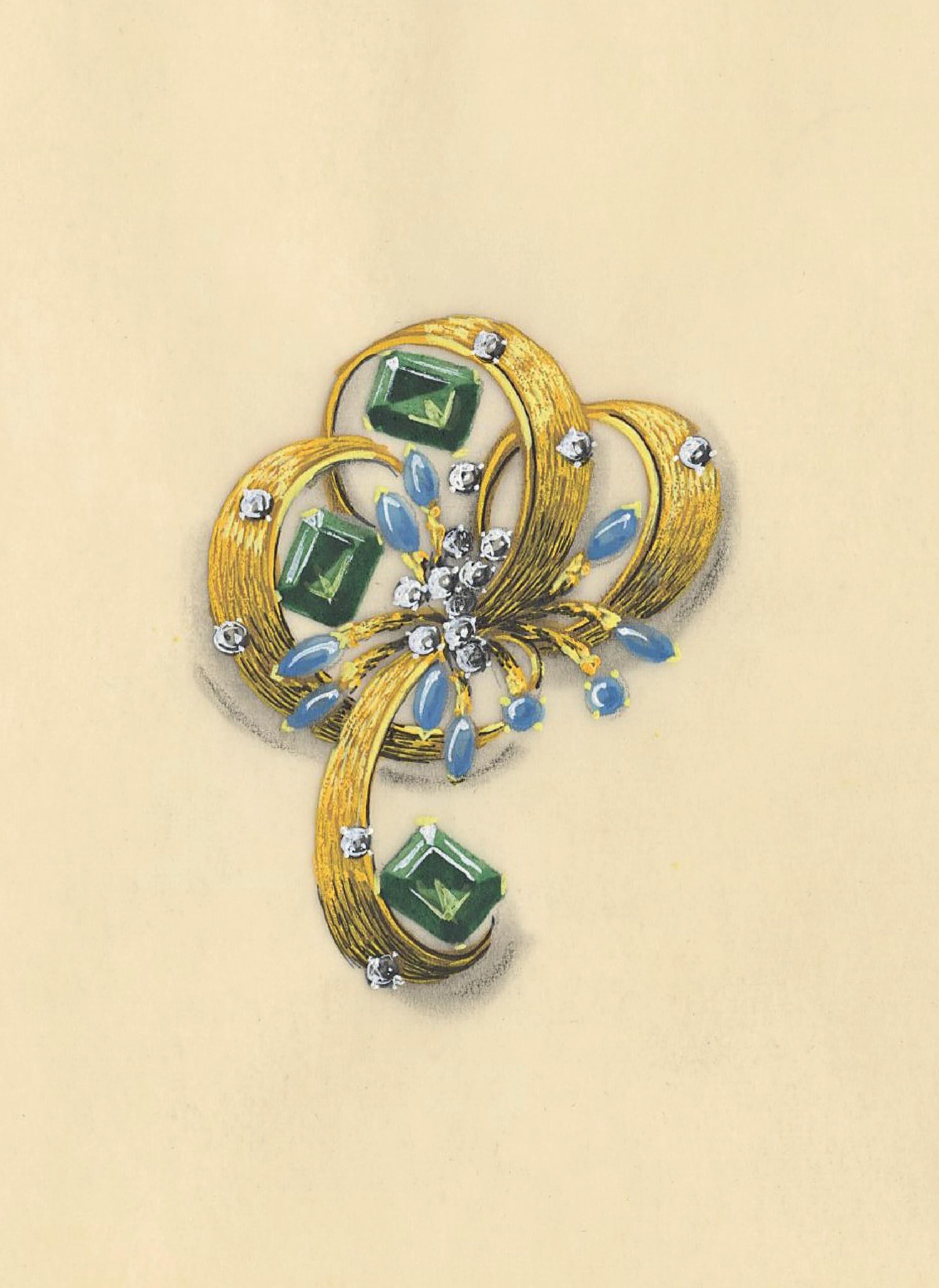
Drawing for a bow brooch in yellow gold, with turquoise cabochons, emeralds and diamonds
Probably France, 1950s-1970s
The 1960s and 1970s was a period of economic prosperity in Europe and the United States. International voyages to stylish resorts became more accessible for the affluent “jet set“ through readily available air travel. Socialites, supermodels, and film actors were celebrity icons, their lifestyles, fashions, and jewelry desirable must-haves. It was a golden era for high-end jewelers who opened boutiques worldwide where high society mixed and entertained. Trends in jewelry were truly global, and established Parisian houses were now competing with jewelers such as the flamboyant Bulgari in Rome or Tiffany in New York.
These three albums contain 330 jewelry designs in varying styles, suggesting the designer compiled a record of work made over several decades. The three volumes are divided into neckpieces, rings, and, under the sobriquet “miscellaneous,“ an assortment of earrings, brooches, and jeweled watches. The designs appear to follow French styles in jewelry, both classical and unconventional, a few dating back to the 1950s but the majority reflecting luxury tastes of the 1960s and 1970s with a flamboyant use of both cabochon and facetted gemstones in unconventional color combinations and cuts. The selection of finger rings is exceptional, and many of the designs break from tradition: a ring is no longer circular, the outlines are often geometric, and gemstones are cut to unusual specifications. The artist appears to be of French origin as many of the annotations are in French, and some designs show that he/she worked for at least two famous jewelry houses as they are labelled Asprey (London) and Van Cleef & Arpels (Paris).
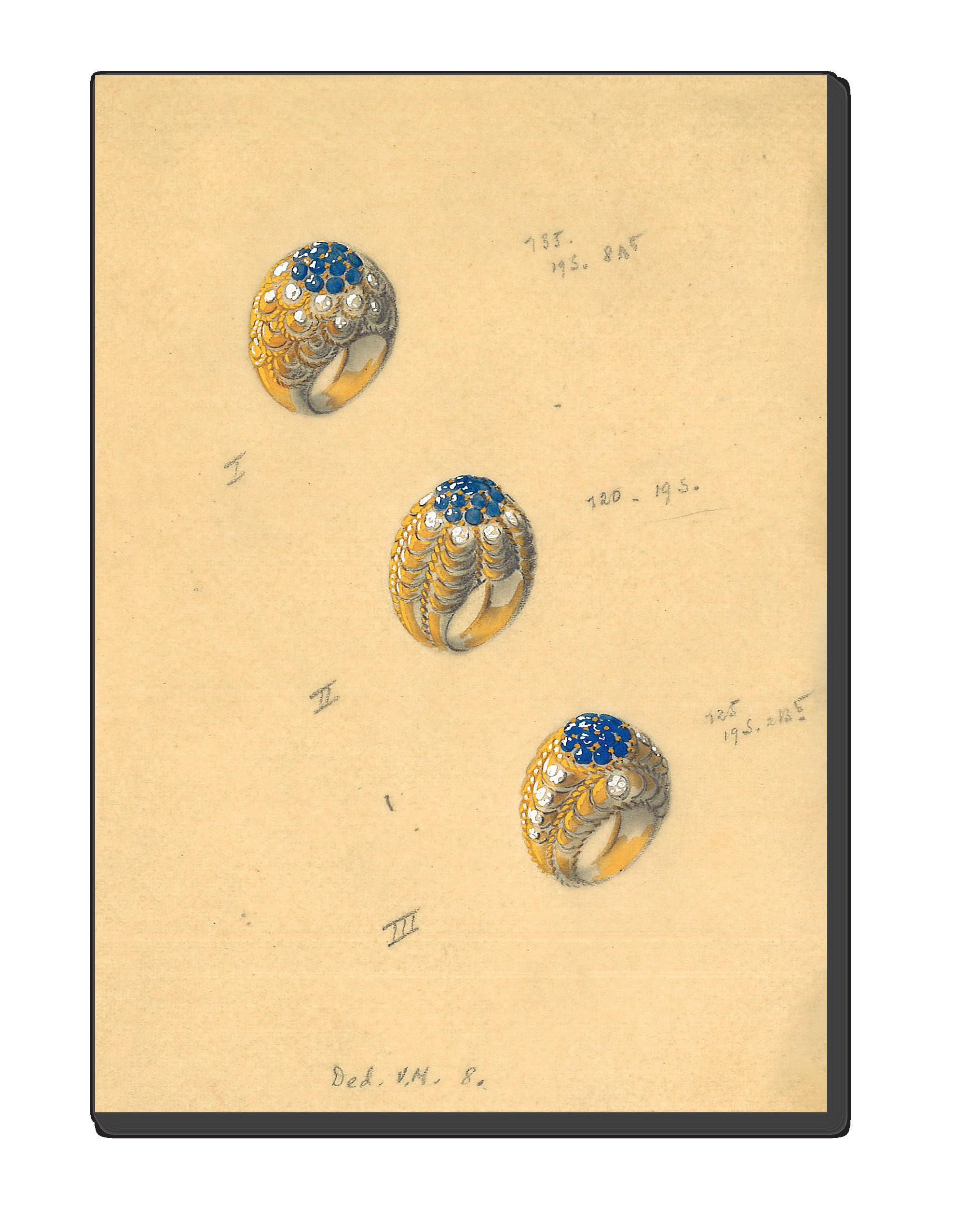
Drawings with a variety of gem-set rings
330 designs, graphite, pencil, and gouache on tracing paper. They are organized by jewelry type into three groups. Pencil annotations appear to be by the same hand, mostly in French, with a few in English. Excellent condition.
Albums: The designs in group 1 and 2 are presented on a black cardboard backing within a modern, black plastic photo album measuring 306 x 230 mm.
Group 1 and 2 belong to the same series and appear to have been made to present to clients as they show advanced finishing touches. The shading and colors are executed in a uniform manner. Some designs indicate the body parts on which the jewel is supposed to be worn.
Group 1: 99 Designs of Necklaces and Chokers on tracing paper, each measuring 250 x 190 mm. Annotations include series numbers, drawing numbers, weights and materials (gold, black onyx, lapis, perles, bleu topaze). Various notes in uppercase letters, probably representing model names such as HARSA, MARIETTA, LYRE, CAPRI, LALY, MARSA. One of the sketches bears the name “Asprey.“
Group 2: 100 designs of Rings on tracing paper (Canson France claque supérieur), 250 x 190 mm. A few annotations in pencil, including drawing numbers or model names (SAMBA, MAROUSSIA, MARSA, GAVOTTE, AGLAEE, SITA), or various other notes (bangle, maquette, bague anneau gaudron). Three drawings bear the name “Asprey“.
Group 3: is a miscellaneous group of 131 sheets, designs on tracing paper (watermark “Montgolfier”) size varies from 90 to 250 mm. Six designs of rings are enclosed in plastic pouches with gray paper backing. Various subjects (rings, earrings, watches, bracelets, brooches, and pins): some sketches show a less detailed level of completion than others. Various annotations can help identify the provenance, likely from the same designer but made over a longer period
of time. Some designs bears initials (probably AB/TB/GB?), one shows a pine tree stamp, while 13 sheets have a four-digit numbering stamp (registration or inventory numbers of pieces made) in the lower right corner, ranging from 1092 to 1449. Some drawings are also numbered in pencil, with one explicitly labeled as “dessin N. 1644.“ Handwritten notes in French probably about the client: “Maquette Mme L.“; “projet No. 1 à la demande Petits Bts“; “STOFFEL maquette avec pierres VcA“ (Van Cleef & Arpels).
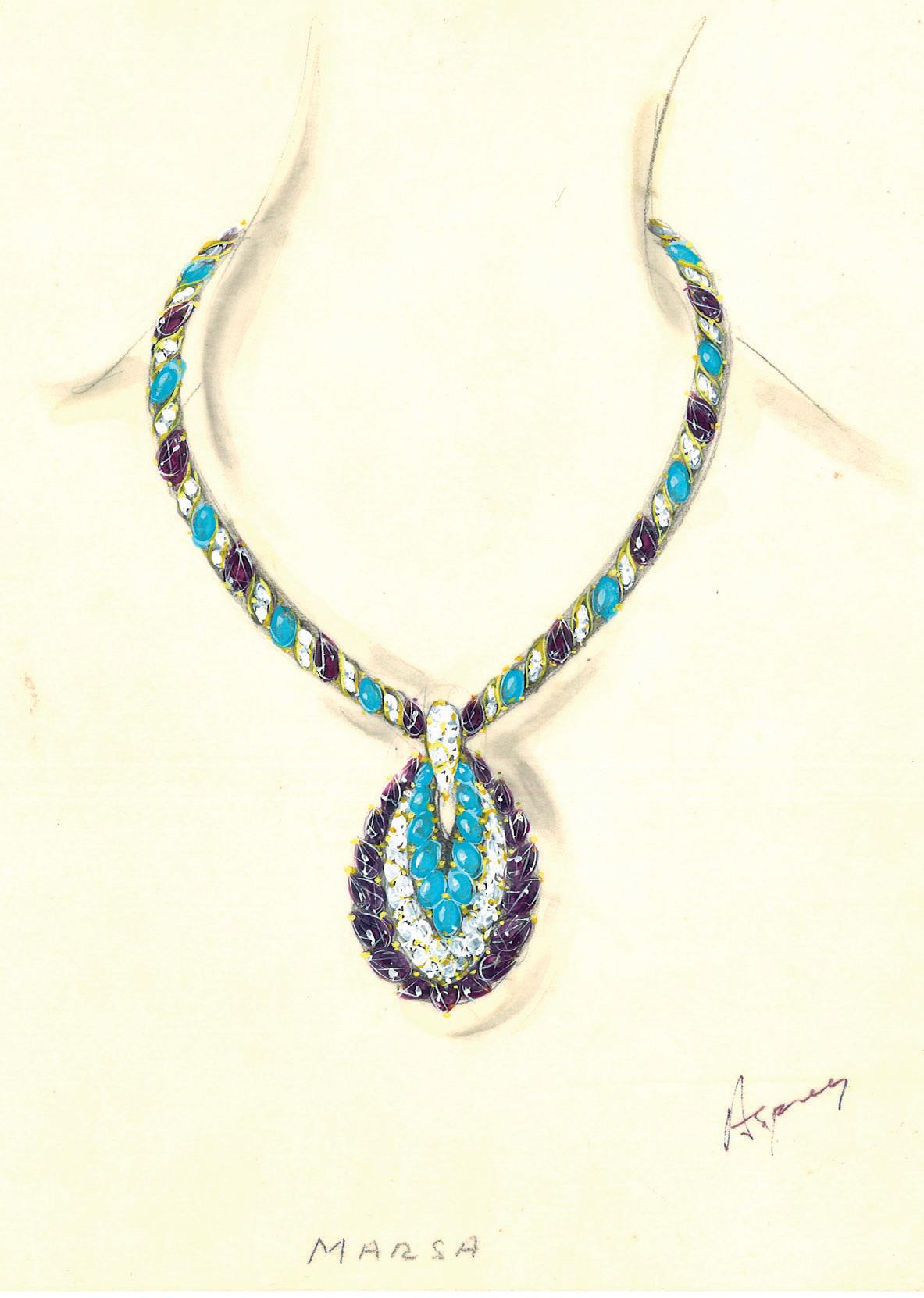
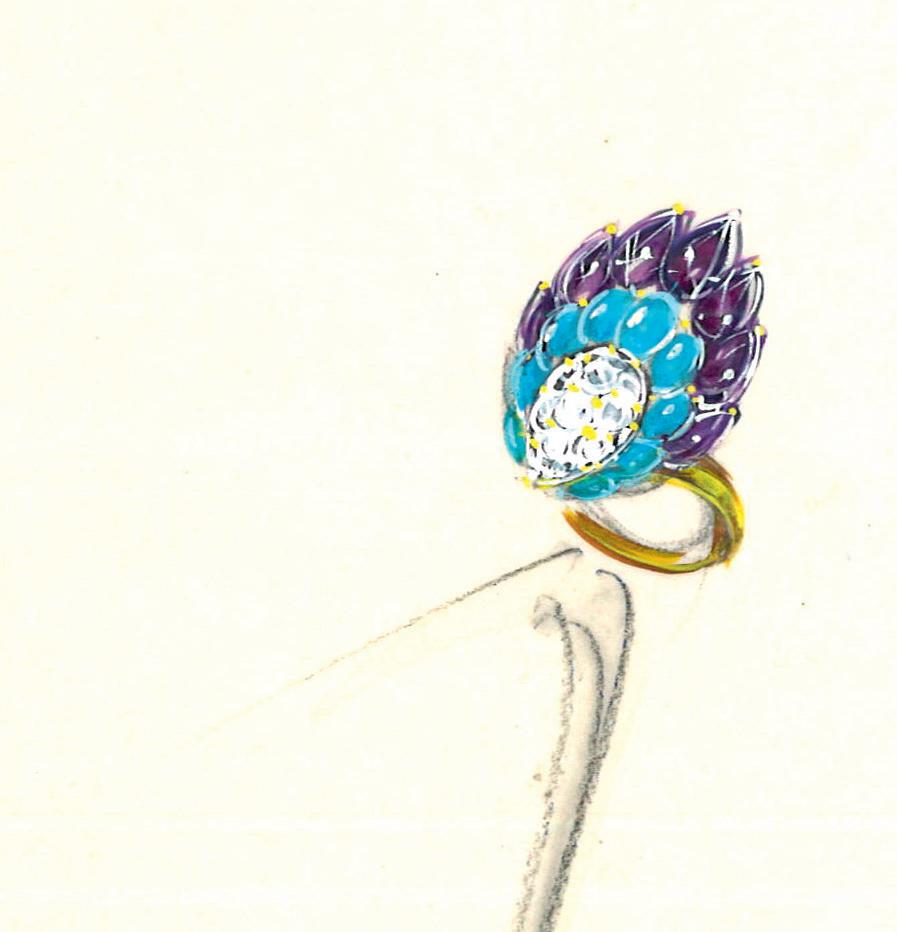
Drawings of a necklace and matching ring titled 'Marsa' for Asprey, London
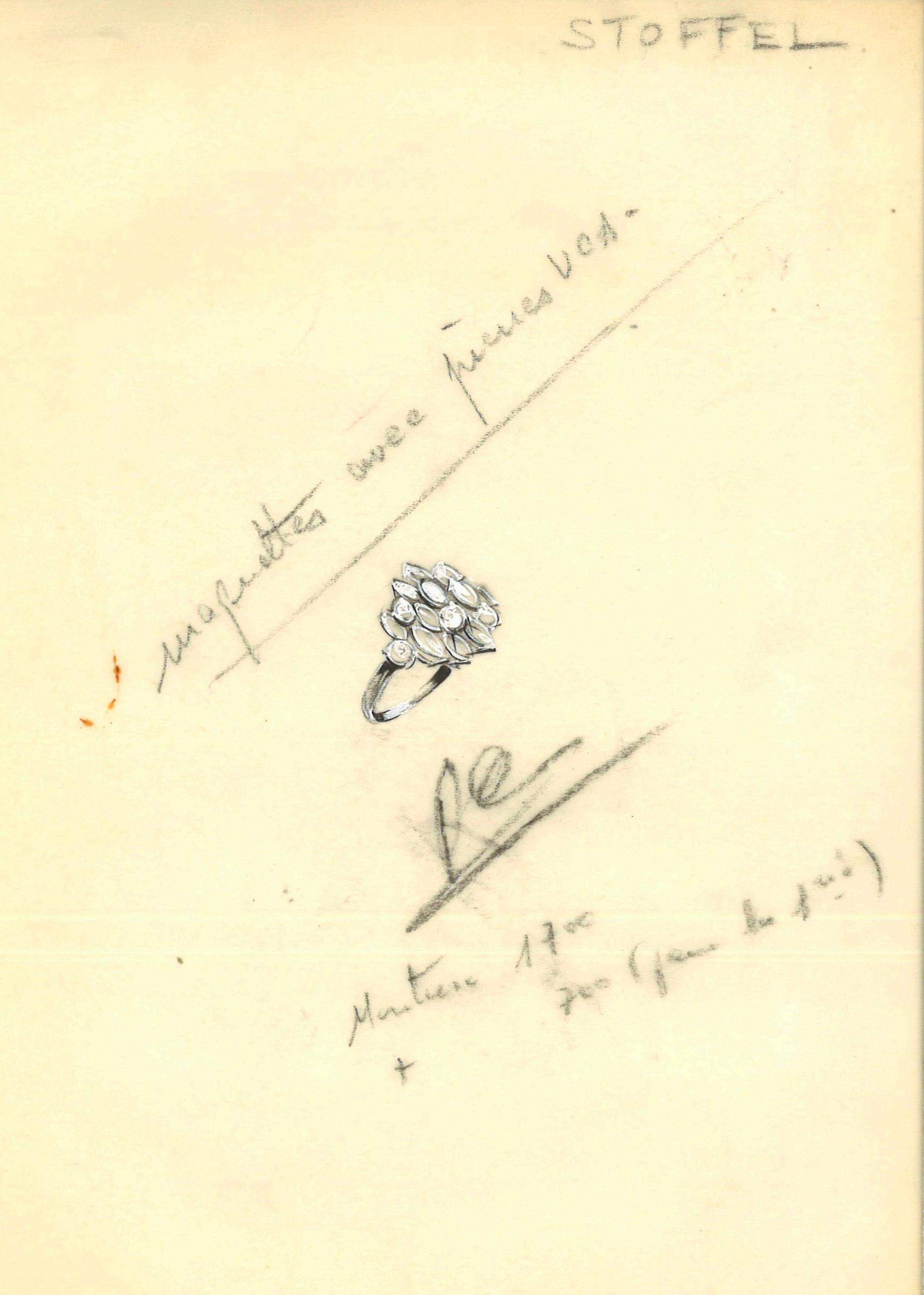
Drawings of a ring with handwritten note: “STOFFEL maquette avec pierres VcA (Van

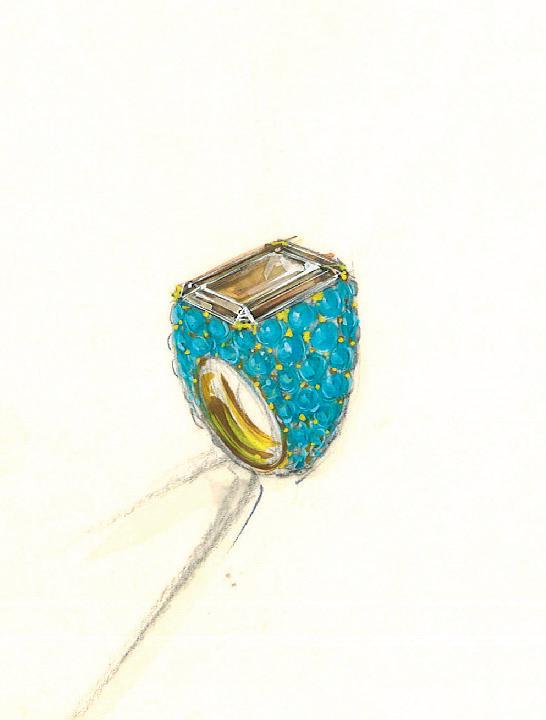

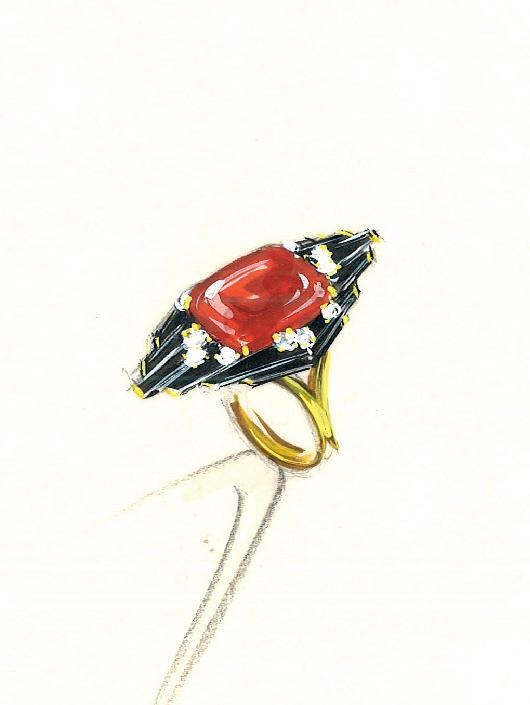

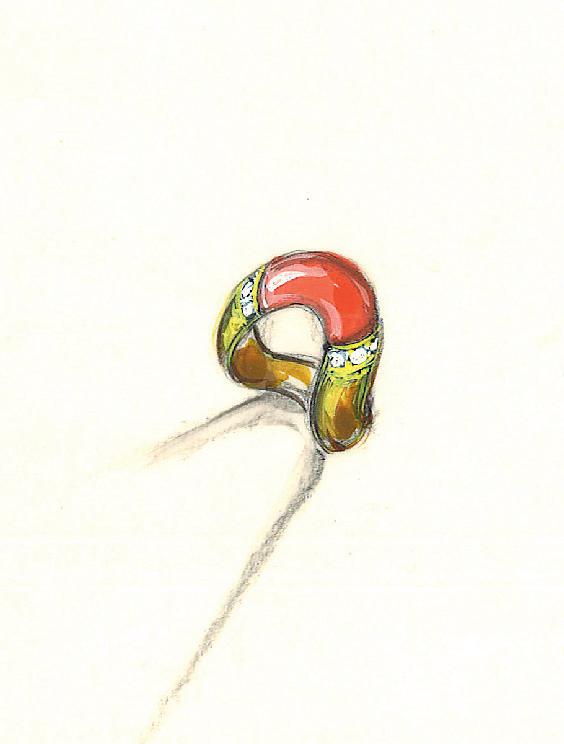
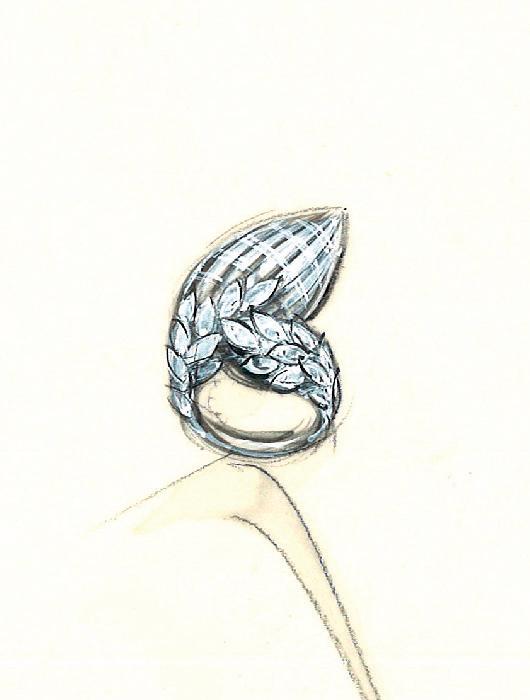
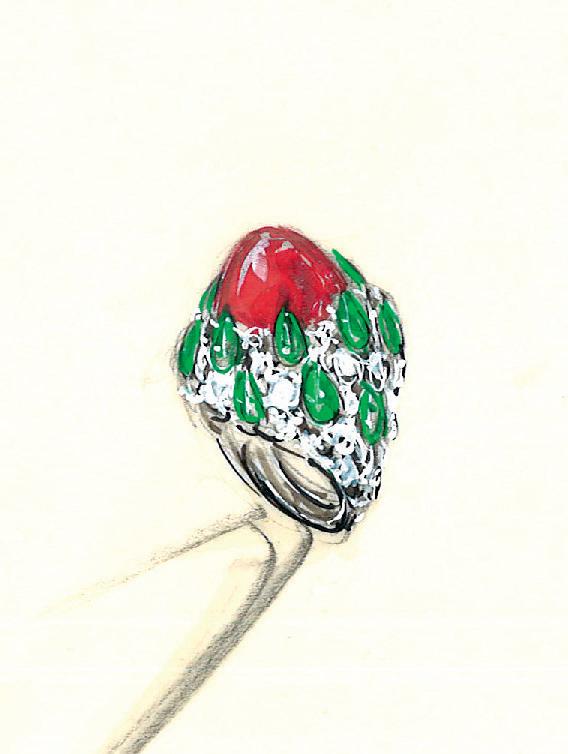

Drawings for nine ring designs in varying styles and gemstone combinations
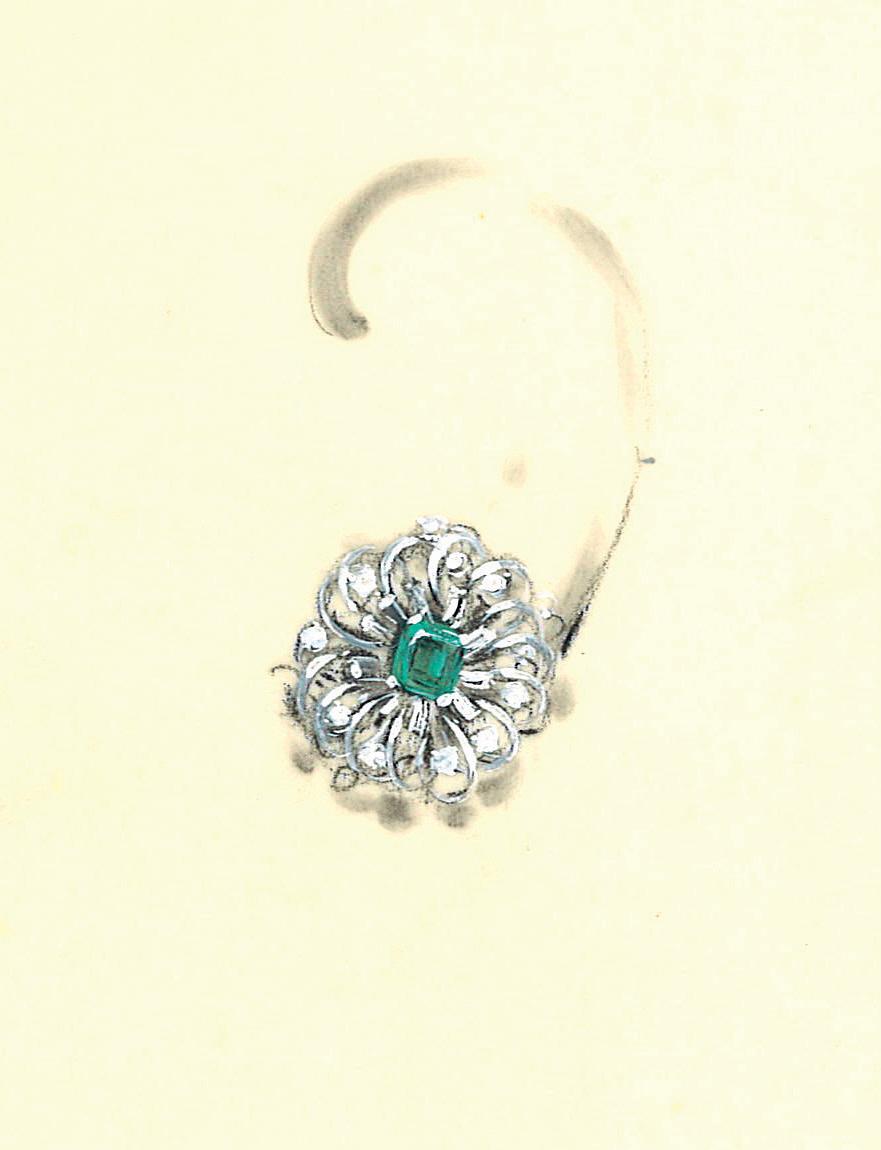
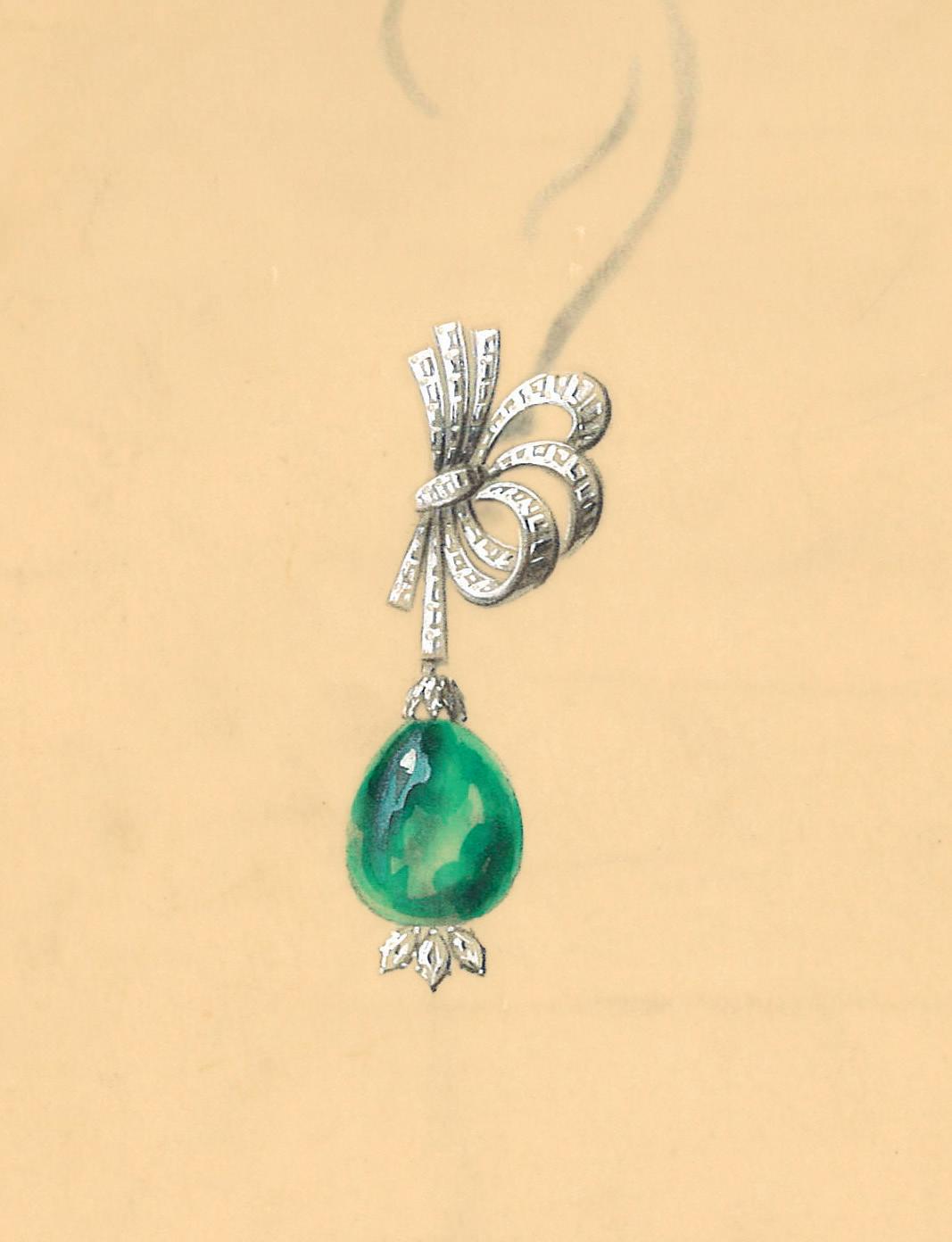
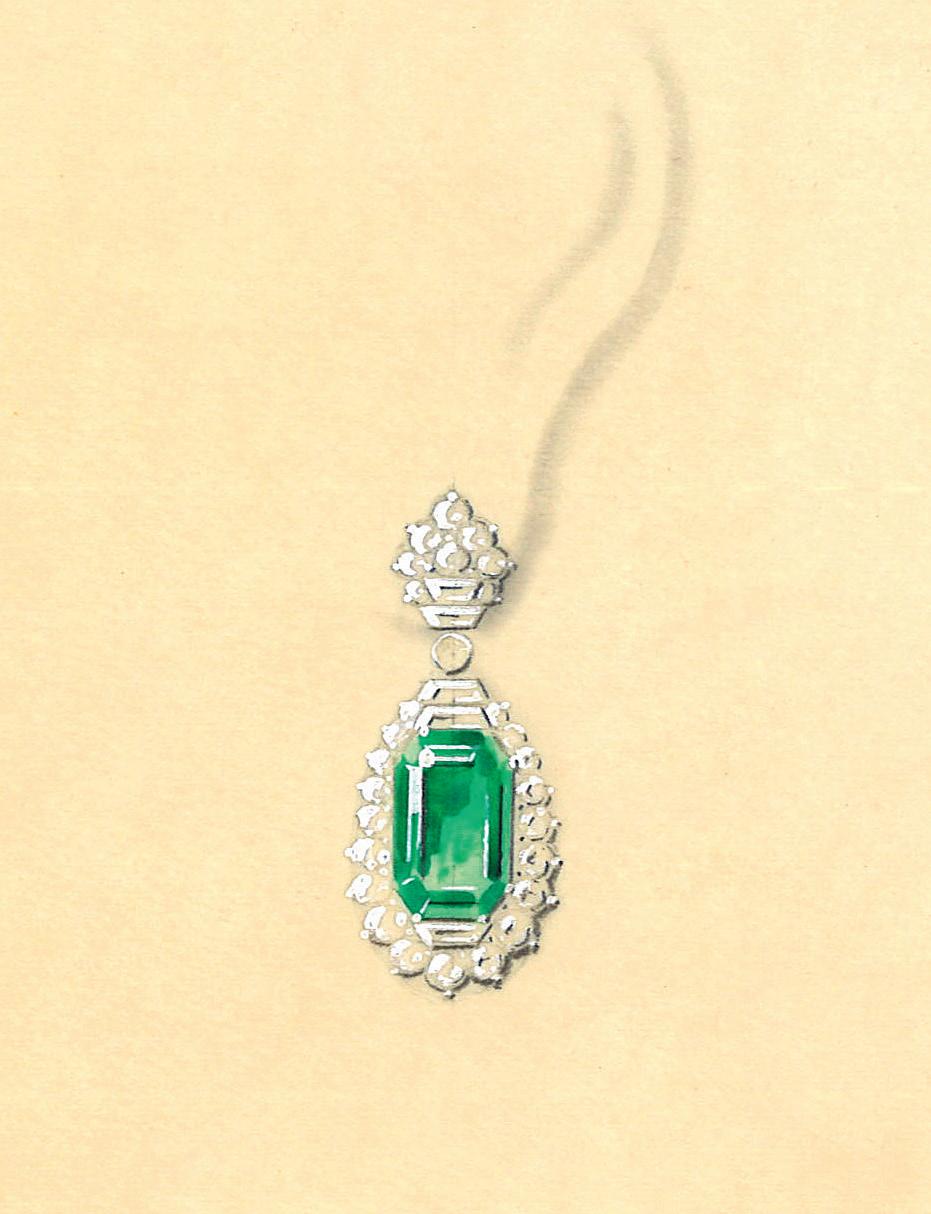
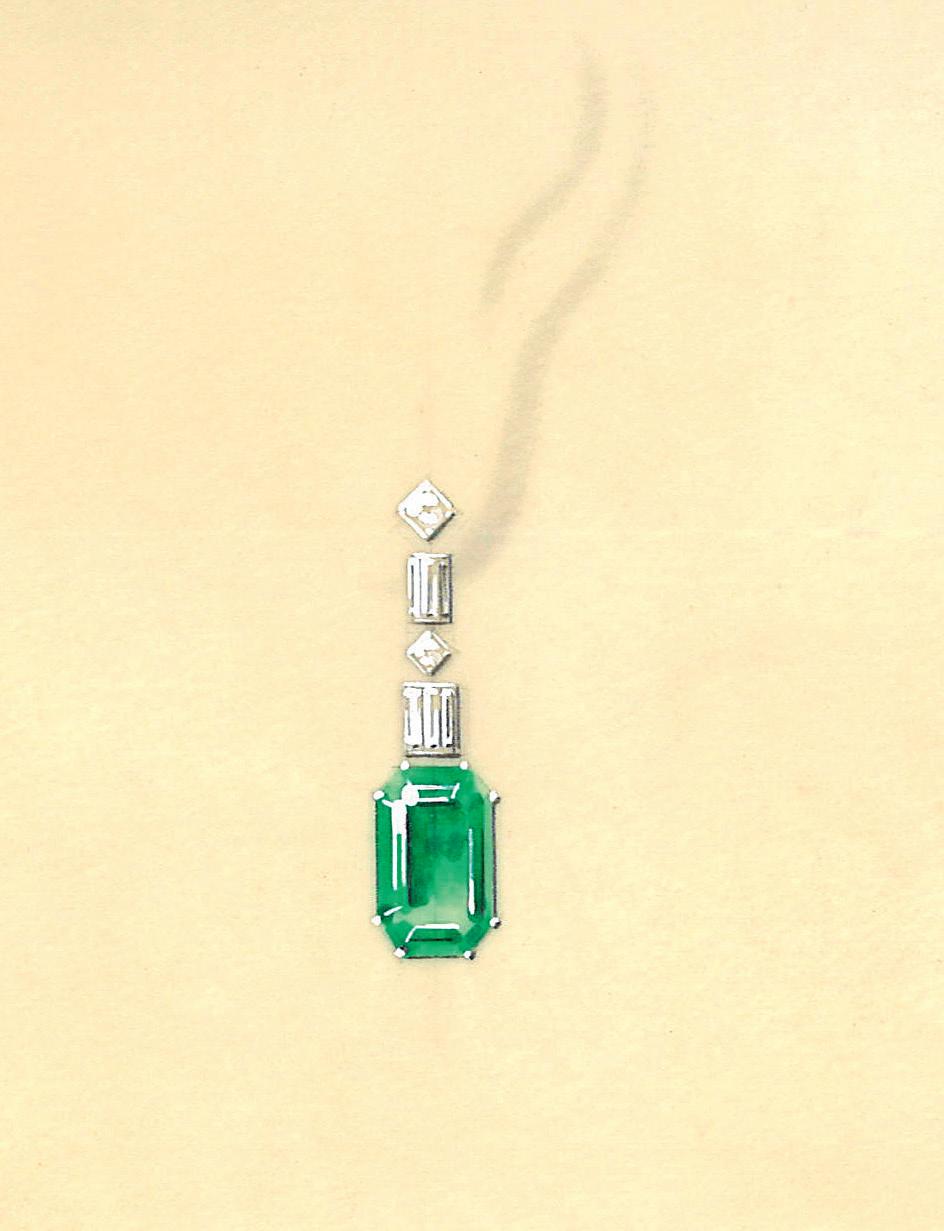
Four drawings for varying diamond and emerald earrings
Becker 1985
Becker, Vivienne. Art Nouveau Jewelry, London, 1985.
Bury 1991
Bury, Shirley. Jewelry: The International Era 1789-1910, 2 vols, Woodbridge, 1991.
Cailles 1994
Cailles, Françoise. René Boivin Jeweler, London, 1994.
Capellieri 2018
Capellieri, Alba. Jewelry from Art Nouveau to 3D-Printing, Milan, 2018 (1st edition).
Chadour-Sampson/Newell-Smith 2021
Chadour-Sampson, Beatriz / Newell-Smith, Sonya. Tadema Gallery London, Jewelry from the 1860s to 1960s, Stuttgart 2021.
Cruse 2007
Cruse, Jen. The Comb, Its History and Development, Robert Hale Ltd, London, 2007.
Culme 1992
Culme, John. The Directory of Gold & Silversmiths: Jewelers & Allied Traders 1838–1914: From the London Assay Office Registers, Volume I. The Biographies, Woodbridge, 1992 (1st ed. 1987).
Dictionnaire International du Bijou 1998
Dictionnaire International du Bijou, Paris, 1998.
Gabardi 1987
Gabardi, Melissa. Les bijoux des années '50, Milan, 1987.
Gabardi 1989
Gabardi, Melissa. Art Deco Jewelry 1920-1949, Woodbridge, 1989.
Gabardi 2016
Gabardi, Melissa. Italian Jewelry in the 20th Century, Milan, 2016.
Gere/Rudoe/Tait/Wilson 1984
Gere, Charlotte / Rudoe, Judy / Tait, Hugh, ed. / Wilson, Timothy. The Art of the Jeweler, A Catalogue of the Hull Grundy Gift to the British Museum , 2 vols, London, 1984.
Hughes 1963
Hughes, Graham. Modern Jewelry, Studio Books, London, 1963.
Hughes 1972
Hughes, Graham. The Art of Jewelry: A Survey of Craft and Creation, London, 1972.
Loyrette 2017
Loyrette, Henri, ed. Chaumet Parisian Jeweler since 1780, Paris, 2017.
Marquardt 1998
Marquardt, Brigitte. Schmuck. Realismus und Historismus 1850-1895, Deutschland, Österreich, Schweiz, Munich and Berlin, 1998.
Mascetti/Triossi 1990
Mascetti, Daniela/ Triossi, Amanda. Earrings from Antiquity to the Present, London, 1990.
Mascetti/Triossi 1997
Mascetti, Daniela/ Triossi, Amanda. The Necklace from Antiquity to the Present, London, 1997.
Meylan 2011
Meylan, Vincent. Van Cleef & Arpels Treasures and Legends, Woodbridge, Suffolk, 2011.
Mouillefarine/ Possémé 2009
Mouillefarine, Laurence / Possémé, Evelyne. Art Deco Jewelry, London, 2009.
Nadelhoffer 2010
Nadelhoffer, Hans. Cartier, Thames & Hudson, London, 2010 (1st ed. 1984).
Néret 1988
Néret Gilles. Boucheron. Histoire d’une dynastie de joailliers, Fribourg, 1988.
Phillips 2006
Phillips, Clare (ed.). Bejeweled by Tiffany 1837-1987, New Haven, 2006.
Phillips 2019
Phillips, Clare. Jewels and Jewelry, V&A Publications, London, 2019 (1st ed. 2000).
Possémé / Mauriès 2017
Possémé, Evelyne / Mauriès, Patrick. Fauna: The Art of Jewelry, London and New York, 2017.
Raulet 1984
Raulet, Sylvie. Schmuck Art Déco, Munich, 1984.
Raulet 1987
Raulet, Sylvie. Schmuck der 40er & 50er Jahre, Munich, 1987.
Redington Dawes/Collings 2007
Redington Dawes, Ginny/ Collings, Olivia. Georgian Jewelry 1714-1830, Woodbridge Suffolk, 2007.
Rio 2023
Rio, Gaëlle. Chaumet, Drawing from Nature, London, 2023.
Röhrs 2011
Röhrs, Ursula. Der Ring. 500 Jahre Schmuck, Magie, Handwerk und Design Die Sammlung des Museums im Prediger Schwäbisch Gmünd, Schwäbisch Gmünd, 2011.
Roux/Royer/Possémé/ Le Stum 2015
Roux, Nathalie/ Royer Amandine/ Possémé, Evelyne/ Le Stum Philippe. Jules Chadel (1870-1941): Nature & Movement. Drawings and Engravings, Gourcuff Gradenigo, 2015.
Scarisbrick 1994
Scarisbrick, Diana. Jewelry in Britain 1066-1837. A Documentary, Social, Literary and Artistic Survey, Norwich, 1994.
Scarisbrick 1995
Scarisbrick, Diana. Chaumet: Master Jewelers since 1780, Paris, 1995.
Silverman 2018
Silverman, Willa Z. Henri Vever, Champion de l’art nouveau, Arman Colin, Paris, 2018.
Unger 2004
Unger, Marjan. Het Nederlandse sieraad in de 20ste eeuw, Utrecht, 2004.
van Strydonck de Burkel 1998
van Strydonck de Burkel, Rolende. Le Bijou Art Nouveau en Europe, La Bibilothèque des Arts, Lausanne and Paris, 1998.
Vever 2001
Vever, Henri. French Jewelry of the Nineteenth Century. Translated by Katherine Purcell, London, 2001 (original ed. 1906-1908).
Weber 1990
Weber, Christianne. Schmuck der 20er und 30er Jahre in Deutschland, Stuttgart 1990.
Woolton 2011
Woolton, Carol. Drawing Jewels for Fashion, Munich, London, New York, 2011.
EXHIBITION CATALOGUES
Bruges 1973
Stad Brugge, Jules Fonteyne. Retrospectieve tentoonstelling, Groeningemuseum, Bruges 1973.
London, 1997
Judy Rudoe, Cartier 1900-1939, British Museum London, 1997.
Memphis 2013
Gilles Chazal and Martine Chazal, Bijoux parisiens: French Jewelry from the Petit Palais, The Dixon Gallery and Gardens, Memphis, 2013.
Paris 2021
Guillaume Glorieux, Le Bijou Dessiné, Designing Jewels, École des Arts joailliers, Paris, 2021
Paris 2023
Rosella Froissart with Florent Guérif and Paul Paradis, A New Art Metamorphoses of jewelry, 1880-1914, École des Arts joailliers, Paris, 2023.
Paris 2025
Clara Roca (ed.), Dessins de Bijoux. Les secrets de la création, Petit Palais, Paris 2025.
Jean-Jacques Richard. Online article “Georges LE TURCQ Dessinateur et Fabricant, époque Art Nouveau“, 29 March 2015 https://www.richardjeanjacques.com
https://www.thefrenchjewelrypost.com/en/style/henri-vever-the-art-nouveaujeweler/
Jewelry Designs at the Petit Palais, Paris https://www.petitpalais.paris.fr/en/node/3493
Rhode Island Jewelry Design Collection
https://sova.si.edu/record/nmah.ac.1505
Jewelry Design Books of Jacques and Marcus 1890 to 1910 https://www.library.dartmouth.edu/digital/digital-collections/jewelry-design-booksjaques-and-marcus-1890-1910
(see also Beth Carver Wees, “A Gem of a Discovery,” Magazine Antiques 183.6 (2016): 48)
Beatriz Chadour-Sampson is an international jewelry historian, author, curator, and lecturer based in England. Her publications examine famous collections of jewelry such as the Museum of Decorative Arts, Cologne, Germany (1985); Alice and Louis Koch Collection, Zurich, Switzerland (1994, 2019) as well as broader histories of jewelry like The Power of Love: Jewels, Romance, and Eternity (2019). She continues to work as a curator and lecturer for several museums including the Swiss National Museum, Zurich; the Victoria and Albert Museum, London; and Gübelin Gem Museum, Lucerne.
Gaia Grizzi studied Art History at Parma University in Italy and the École du Louvre in Paris. She is currently completing a PhD at the École nationale des Chartes. Since 2008, she has worked with Les Enluminures. She co-edited the Liber amicorum in honour of Diana Scarisbrick: A Life in Jewels (Paul Holberton Publishing 2022).
Sandra Hindman is a leading expert on European Medieval and Renaissance manuscript illumination and jewelry. Professor Emerita of Art History at Northwestern University and Chairwoman of Les Enluminures worldwide, Dr. Hindman is author, co-author, and editor of more than a dozen scholarly books, as well as numerous articles on illuminated manuscripts and on medieval rings. These publications include The Robert Lehman Collection. IV. Illuminations (Metropolitan Museum of Art, 1997); Books of Hours Reconsidered (2013); and Take this Ring: Medieval and Renaissance Rings from the Griffin Collection (2015). In 2023 the French Republic named Sandra Hindman a Chevalière de l’Ordre des Arts et des Lettres (Knight of the Order of Arts and Letters).
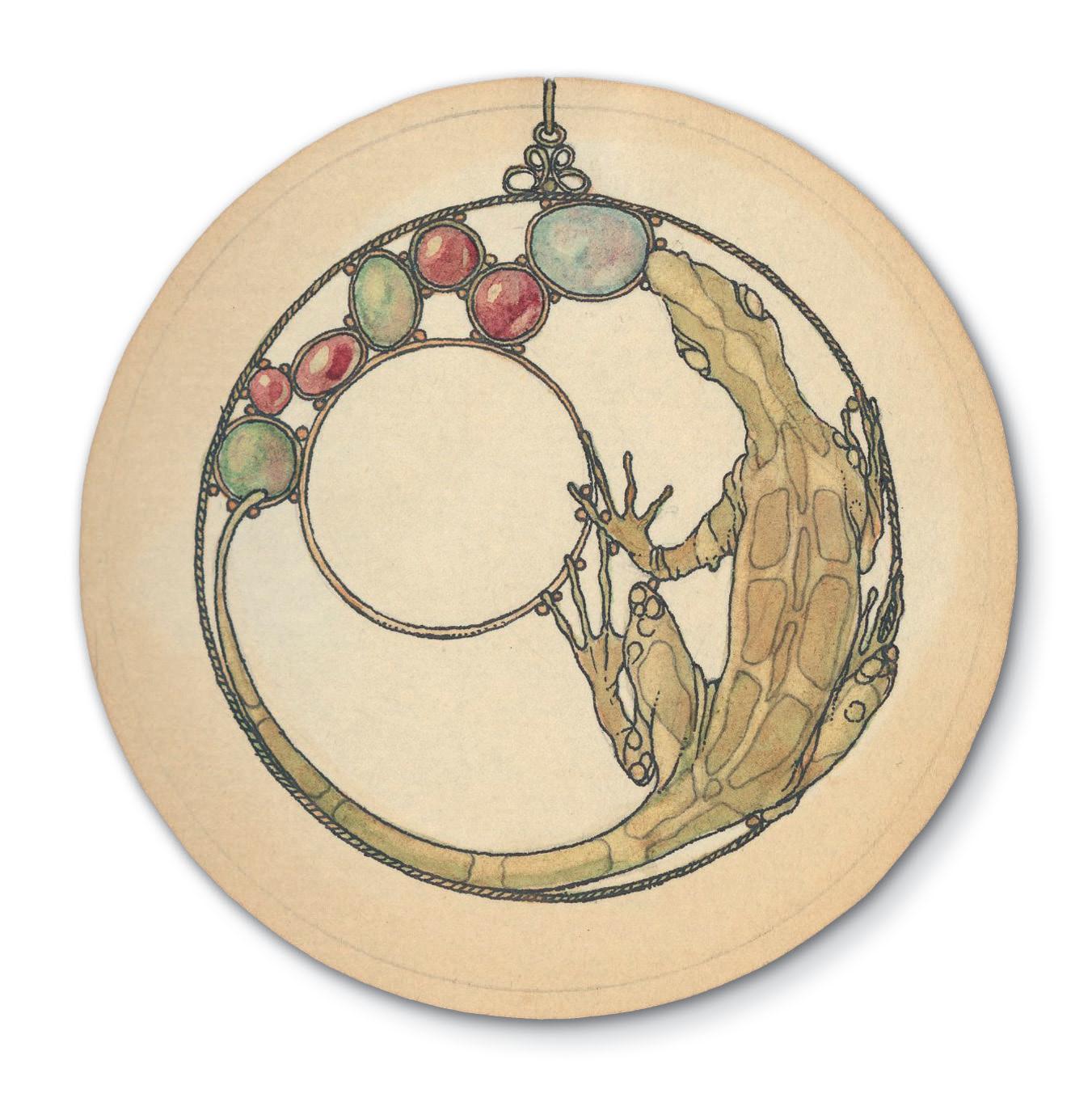
Toward an Art History of Medieval Rings: A Private Collection, 2007 (repr. 2014)
Sandra Hindman, with Illaria Fatone and Angélique Laurent-di Mantova; Introduction by Diana Scarisbrick
Byzantium and the West: Jewelry in the First Millennium, 2012
Jeffrey Spier; Preface by Sandra Hindman
Cycles of Life: Rings from the Benjamin Zucker Family Collection, 2014
Sandra Hindman, with Beatriz Chadour-Sampson, Reine Hadjadj, Jack Ogden, and Diana Scarisbrick; Essay by Benjamin Zucker
Rings Around the World, 2016
Beatriz Chadour-Sampson and Sandra Hindman
Golden Marvels of Byzantium: A Millenium of Finger-rings (3rd-13th Centuries), 2017
Sandra Hindman; Introduction by Diana Scarisbrick
The Thing of Mine I Have Loved the Best: Meaningful Jewels, 2018
Cynthia Hahn with Beatriz Chadour-Sampson
The Fashioned Hand: Historic Finger Rings, 2018
Sandra Hindman; Introduction by Jonquil O’Reilly
Diamonds: The Collection of Benjamin Zucker, 2019
Diana Scarisbrick; Essay by Benjamin Zucker
Living Nobly: Jewelry of the Renaissance Courts, 2020
Beatriz Chadour-Sampson and Sandra Hindman
The Althorp Leopard: The Celebrated Life of a Renaissance Cameo, 2020
Sandra Hindman; preface by Diana Scarisbrick
The Ideal Past: Revival Jewels, 2022
Beatriz Chadour-Sampson and Sandra Hindman
Edited by Les Enluminures:
Take this Ring: Medieval and Renaissance Rings from the Griffin Collection
Sandra Hindman with Scott Miller; Introduction by Diana Scarisbrick, Turnhout Brepols, 2015
Liber Amicorum in honour of Diana Scarisbrick: a Life in Jewels ed. Beatriz Chadour-Sampson, Sandra Hindman, Carla van de Puttelaar, London, Ad Ilissvm, 2022
